Paul van Yperen's Blog, page 68
November 15, 2023
Ernst von Klipstein
Ernst von Klipstein (1908-1993) was a rangy, masculine German supporting actor and occasional lead. He performed on stage from 1925. Von Klipstein became a prominent actor during the Nazi era, mainly for Universum AG (Ufa) where he was often cast as an officer, chief engineer or other authority figure. After the war, he was much in demand for synchronising work, radio plays and as a guest star on TV.
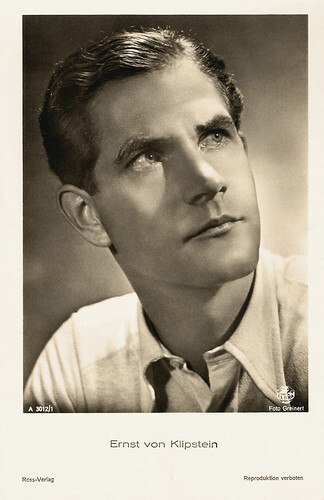
German postcard by Ross Verlag, no. A 3012/1, 1941-1944. Photo: Greinert / Terra.
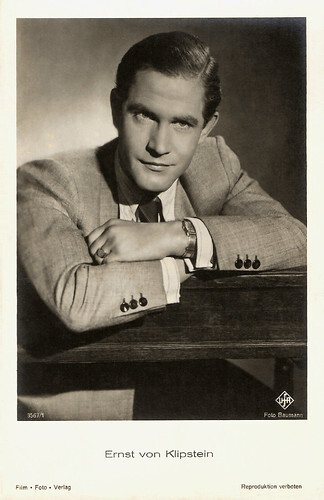
German postcard by Film-Foto-Verlag, no. A 3567/1, 1941-1944. Photo: Baumann / Ufa.
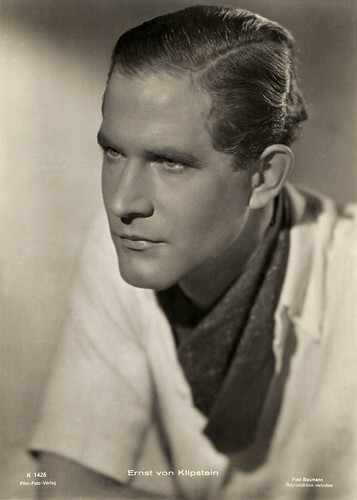
German postcard by Film-Foto-Verlag, no. K 1426. Photo: Baumann.
The ideal country junker and Prussian officer
Ernst Vollrath von Klipstein was born in 1908 in Posen, Prussia in the German Empire (now Poznan, Wielkopolskie, Poland). He first studied law and theatre studies for six semesters. At the same time, he took acting lessons with Jacobi in Munich.
In 1925 he made his stage debut as Leon in Franz Grillparzer's 'Weh dem, der lügt' at the Landestheater Darmstadt. This was followed by theatres in Regensburg, Meiningen, Bochum, Cologne, Kassel, Frankfurt am Main and Leipzig. He played, among others, Don Carlos, Max Piccolomini in Friedrich Schiller's 'Wallenstein', Cardinal Julian in Franz Werfel's 'Das Reich Gottes in Böhmen'(both in Bochum), Ferdinand in Schiller's 'Kabale und Liebe' (Intrigue and Love, in Frankfurt) and Marchbanks in George Bernard Shaw's 'Candida' (in Kassel).
At the end of 1938 Ernst von Klipstein made his feature film debut in Gustav Ucicky's Aufruhr in Damaskus/Riot in Damascus. Until the end of the war, he played mostly striking supporting roles in numerous Ufa productions, which came close to the ideal of the country junker and the Prussian officer of the time.
He played under the direction of Viktor Tourjansky in Der Gouverneur/The Governor (1939) and under the direction of Boleslaw Barlog in Unser kleiner Junge/Our Little Boy (1941). Alongside Heinrich George and Ilse Werner , he appeared in the historical comedy Hochzeit auf Bärenhof/Wedding in Barenhof (Carl Froelich, 1942) after Hermann Sudermann.
He co-starred with Hans Söhnker and Anneliese Uhlig in the Propaganda film Blutsbrüderschaft/Blood Brotherhood (Philipp Lothar Mayring, 1941) as well as in two tendentious Nazi propaganda films by Karl Ritter, Stukas (1941) with Carl Raddatz and Besatzung Dora/Occupation Dora (1943), starring Hannes Stelzer . Von Klipstein was on the 'Gottbegnadete' list of the Reich Ministry for Popular Enlightenment and Propaganda in 1944.
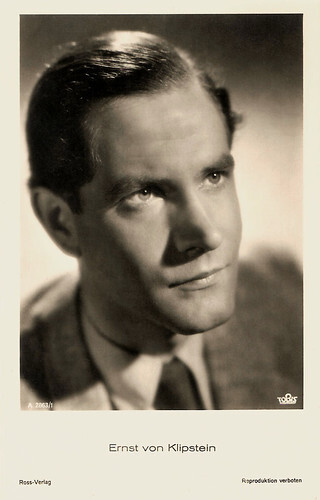
German postcard by Ross Verlag, no. A 2863/1, 1939-1940. Photo: Tobis.
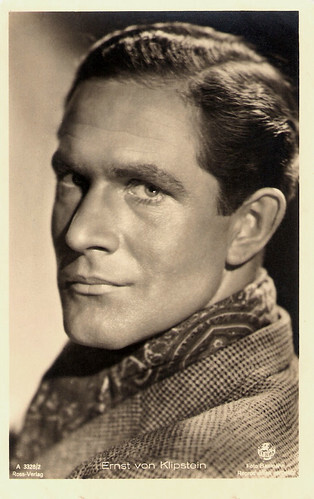
German postcard by Ross Verlag, no. A 3228/2, 1941-1944. Photo: Baumann / Terra.
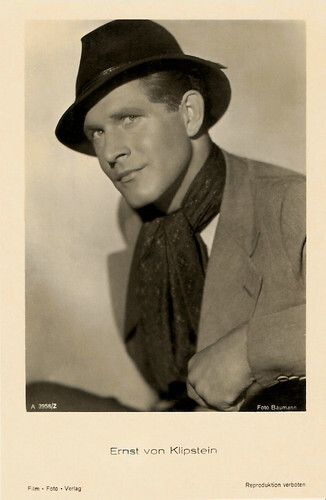
German postcard by Film-Foto-Verlag, no. A 3958/2, 1941-1944. Photo: Baumann.
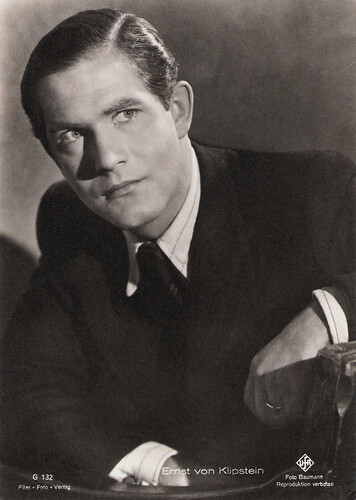
German postcard by Film-Foto-Verlag, no. G 132. Photo: Baumann / Ufa.
The theatre was the hub of his activity after the war
After the 1940s, Ernst von Klipstein only appeared in a few film productions. The theatre formed the hub of his activity after the war for the time being.
His rare appearances in post-war cinema include Skandal um Dr. Vlimmen/Dr. Vlimmen (Arthur Maria Rabenalt, 1956) starring Bernhard Wicki, the historical drama Die Barrings/The Barrings (Rolf Thiele, 1955) with Dieter Borsche and Nadja Tiller , the war drama Hunde, wollt ihr ewig leben/Stalingrad: Dogs, Do You Want to Live Forever? (Frank Wisbar, 1959) and the Johannes Mario Simmel adaptation Der Stoff aus dem die Träume sind/The Stuff That Dreams Are Made Of (Alfred Vohrer, 1972, starring Hannelore Elsner .
Instead, he increasingly took part in lavish television productions such as the miniseries Bauern, Bonzen und Bomben/Farmers, Politics and Bombs (Egon Monk, 1973) an adaptation of Hans Fallada's novel, the historical series Der Winter, der ein Sommer war/The winter that was a summer (Fritz Umgelter, 1976) after the novel of the same name by Sandra Paretti, the family saga Die Pawlaks/The Pawlaks (Wolfgang Staudte, 1982) and the series Nirgendwo ist Poenichen/Nowhere is Poenichen (1980) after the bestseller by Christine Brückner.
He also acted as Grandfather de Bonsac in the acclaimed series Tadellöser & Wolff (Eberhard Fechner, 1975), based on the novels by Walter Kempowski. Von Klipstein also took on numerous guest roles in television series and serials such as Tatort, Sonderdezernat K1, Der Landarzt, Großstadtrevier, Die fünfte Kolonne, Percy Stuart and Die Schwarzwaldklinik. He also worked extensively as a voice actor for German versions of international films between 1949 and 1991. He lent his distinctive voice to Gary Cooper in Along Came Jones (Stuart Heisler, 1945), Rex Harrison in The Rake’s Progress (Sidney Gilliat, 1945), Michael Redgrave in The Importance of Being Earnest (Anthony Asquith, 1952), and among others. Von Klipstein was also often engaged as a radio play narrator.
Ernst von Klipstein was married four times, with Deli Maria Teichen, actress Lotte Koch , Elisabeth Biebl and finally with the actress Marianne Kehlau. He died in Hamburg in 1993 at the age of 85 and was buried at the Waldfriedhof in Hamburg-Volksdorf, as was his second wife Lotte Koch , whose name is not engraved on the gravestone.
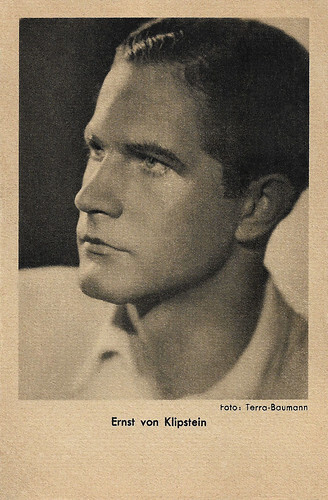
German postcard. Photo: Terra / Baumann.
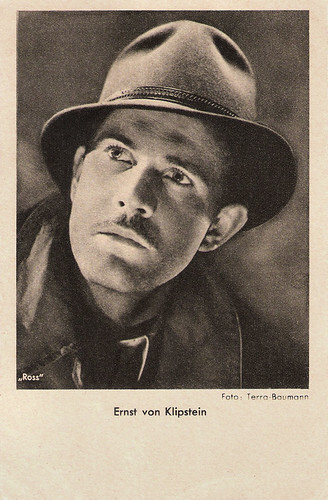
German postcard by Ross Verlag for Das Programm von Heute, Berlin. Photo: Baumann / Terra.

German postcard by Ross Verlag for Das Programm von Heute, Berlin. Photo: Tobis.
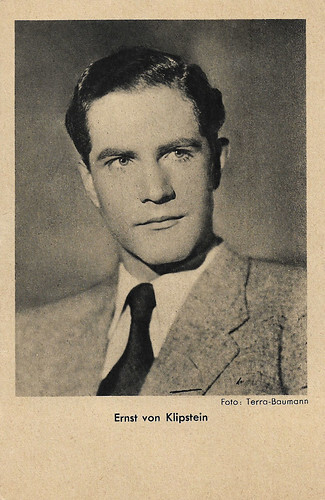
German postcard by Ross Verlag for Das Programm von Heute, Berlin. Photo: Terra / Baumann.
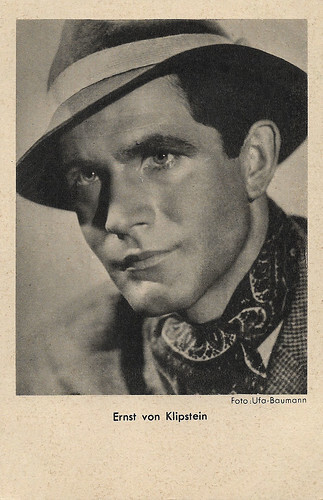
German postcard by Ross Verlag for Das Programm von Heute, Berlin. Photo: Ufa / Baumann.
Sources: Wikipedia (German and English) and .

German postcard by Ross Verlag, no. A 3012/1, 1941-1944. Photo: Greinert / Terra.

German postcard by Film-Foto-Verlag, no. A 3567/1, 1941-1944. Photo: Baumann / Ufa.

German postcard by Film-Foto-Verlag, no. K 1426. Photo: Baumann.
The ideal country junker and Prussian officer
Ernst Vollrath von Klipstein was born in 1908 in Posen, Prussia in the German Empire (now Poznan, Wielkopolskie, Poland). He first studied law and theatre studies for six semesters. At the same time, he took acting lessons with Jacobi in Munich.
In 1925 he made his stage debut as Leon in Franz Grillparzer's 'Weh dem, der lügt' at the Landestheater Darmstadt. This was followed by theatres in Regensburg, Meiningen, Bochum, Cologne, Kassel, Frankfurt am Main and Leipzig. He played, among others, Don Carlos, Max Piccolomini in Friedrich Schiller's 'Wallenstein', Cardinal Julian in Franz Werfel's 'Das Reich Gottes in Böhmen'(both in Bochum), Ferdinand in Schiller's 'Kabale und Liebe' (Intrigue and Love, in Frankfurt) and Marchbanks in George Bernard Shaw's 'Candida' (in Kassel).
At the end of 1938 Ernst von Klipstein made his feature film debut in Gustav Ucicky's Aufruhr in Damaskus/Riot in Damascus. Until the end of the war, he played mostly striking supporting roles in numerous Ufa productions, which came close to the ideal of the country junker and the Prussian officer of the time.
He played under the direction of Viktor Tourjansky in Der Gouverneur/The Governor (1939) and under the direction of Boleslaw Barlog in Unser kleiner Junge/Our Little Boy (1941). Alongside Heinrich George and Ilse Werner , he appeared in the historical comedy Hochzeit auf Bärenhof/Wedding in Barenhof (Carl Froelich, 1942) after Hermann Sudermann.
He co-starred with Hans Söhnker and Anneliese Uhlig in the Propaganda film Blutsbrüderschaft/Blood Brotherhood (Philipp Lothar Mayring, 1941) as well as in two tendentious Nazi propaganda films by Karl Ritter, Stukas (1941) with Carl Raddatz and Besatzung Dora/Occupation Dora (1943), starring Hannes Stelzer . Von Klipstein was on the 'Gottbegnadete' list of the Reich Ministry for Popular Enlightenment and Propaganda in 1944.

German postcard by Ross Verlag, no. A 2863/1, 1939-1940. Photo: Tobis.

German postcard by Ross Verlag, no. A 3228/2, 1941-1944. Photo: Baumann / Terra.

German postcard by Film-Foto-Verlag, no. A 3958/2, 1941-1944. Photo: Baumann.

German postcard by Film-Foto-Verlag, no. G 132. Photo: Baumann / Ufa.
The theatre was the hub of his activity after the war
After the 1940s, Ernst von Klipstein only appeared in a few film productions. The theatre formed the hub of his activity after the war for the time being.
His rare appearances in post-war cinema include Skandal um Dr. Vlimmen/Dr. Vlimmen (Arthur Maria Rabenalt, 1956) starring Bernhard Wicki, the historical drama Die Barrings/The Barrings (Rolf Thiele, 1955) with Dieter Borsche and Nadja Tiller , the war drama Hunde, wollt ihr ewig leben/Stalingrad: Dogs, Do You Want to Live Forever? (Frank Wisbar, 1959) and the Johannes Mario Simmel adaptation Der Stoff aus dem die Träume sind/The Stuff That Dreams Are Made Of (Alfred Vohrer, 1972, starring Hannelore Elsner .
Instead, he increasingly took part in lavish television productions such as the miniseries Bauern, Bonzen und Bomben/Farmers, Politics and Bombs (Egon Monk, 1973) an adaptation of Hans Fallada's novel, the historical series Der Winter, der ein Sommer war/The winter that was a summer (Fritz Umgelter, 1976) after the novel of the same name by Sandra Paretti, the family saga Die Pawlaks/The Pawlaks (Wolfgang Staudte, 1982) and the series Nirgendwo ist Poenichen/Nowhere is Poenichen (1980) after the bestseller by Christine Brückner.
He also acted as Grandfather de Bonsac in the acclaimed series Tadellöser & Wolff (Eberhard Fechner, 1975), based on the novels by Walter Kempowski. Von Klipstein also took on numerous guest roles in television series and serials such as Tatort, Sonderdezernat K1, Der Landarzt, Großstadtrevier, Die fünfte Kolonne, Percy Stuart and Die Schwarzwaldklinik. He also worked extensively as a voice actor for German versions of international films between 1949 and 1991. He lent his distinctive voice to Gary Cooper in Along Came Jones (Stuart Heisler, 1945), Rex Harrison in The Rake’s Progress (Sidney Gilliat, 1945), Michael Redgrave in The Importance of Being Earnest (Anthony Asquith, 1952), and among others. Von Klipstein was also often engaged as a radio play narrator.
Ernst von Klipstein was married four times, with Deli Maria Teichen, actress Lotte Koch , Elisabeth Biebl and finally with the actress Marianne Kehlau. He died in Hamburg in 1993 at the age of 85 and was buried at the Waldfriedhof in Hamburg-Volksdorf, as was his second wife Lotte Koch , whose name is not engraved on the gravestone.

German postcard. Photo: Terra / Baumann.

German postcard by Ross Verlag for Das Programm von Heute, Berlin. Photo: Baumann / Terra.

German postcard by Ross Verlag for Das Programm von Heute, Berlin. Photo: Tobis.

German postcard by Ross Verlag for Das Programm von Heute, Berlin. Photo: Terra / Baumann.

German postcard by Ross Verlag for Das Programm von Heute, Berlin. Photo: Ufa / Baumann.
Sources: Wikipedia (German and English) and .
Published on November 15, 2023 22:00
November 14, 2023
Folgore (1919)
Beautiful, Polish-born diva (H)elena Makowska (1893-1964) was the star of the Italian silent drama Folgore/Lightning (Ugo De Simone, 1919). Her co-stars were Angelo Vianello and the Argentine (?) actor François-Paul Donadio who played between 1914 and 1921 in Italian silent cinema. At Ambrosio, Donadio had co-starred with Makowska in Romanticismo (Carlo Campogalliani, Arrigo Frusta, 1915) and Val d'olivi (1916). In 1919 they acted again together at Gladiator Film in Il principe Zilah (1919) and Folgore (1919).
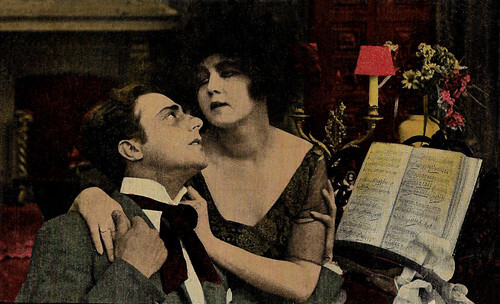
Spanish cromo (collectors card) by Chocolat Imperiale, Card 1 of 6. Photo: Gladiator Film / Distr. J. Verdaguer, Barcelona. Angelo Vianello and Helena Makowska in Folgore (Ugo De Simone, 1919), released in Spain as El Rayo.
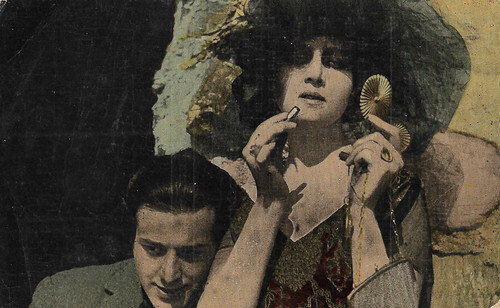
Spanish cromo by Chocolat Imperiale, Card 2 of 6. Photo: Gladiator Film / Distr. J. Verdaguer, Barcelona. Angelo Vianello and Helena Makowska in Folgore (Ugo De Simone, 1919).
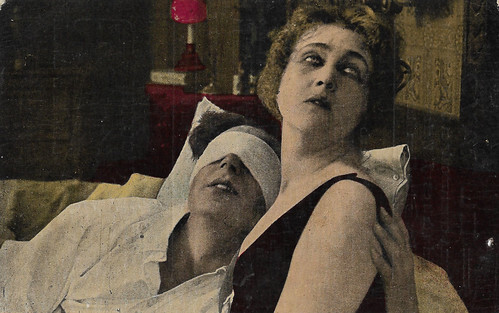
Spanish cromo by Chocolat Imperiale, Card 3 of 6. Photo: Gladiator Film / Distr. J. Verdaguer, Barcelona. Helena Makowska and Angelo Vianello in Folgore (Ugo De Simone, 1919).
A gentle story of love and art
In Folgore (Ugo De Simone, 1919) a talented young composer (Angelo Vianello) humbly asks the eminent diva ( Helena Makowska ) her opinion about his new composition, hoping she may promote it. Detesting big city life, he quietly works on his compositions at his estate. The curious diva visits him with her friends and invites him to join her. They fall in love.
As if to castigate him for his abandonment and new frivolous life, nature blinds him with a lightning bolt (hence the film's title). His beloved steals his last successful composition, called 'Folgore' (Lightning), and tries to sell it to a rich friend of the artist (François-Paul Donadio) who is also a musician, but the latter discovers the infamy and rejects it. The diva returns to her own life but now regrets her misstep. She wants to confess her guilt to the composer and return the manuscript, just when he is about to commit suicide. When trying to prevent him from his act, she dies herself.
Folgore had sets by Filippo De Simone and cinematography by Luigi Florio. Director Ugo De Simone was known for such Gladiator Film productions as L'amazzone macabra (1916), La figlia della tempesta (1917) and Maternità (1917), all starring another silent film diva, Italia Almirante-Manzini .
The premiere of Folgore (Ugo De Simone, 1919) happened in Rome on 29 January 1919, but on 7 August 1918, the critic of the journal La Vita Cinematografica already wrote a positive review of the film: "A gentle story of love and art, gracefully drawn, tastefully scripted and executed by a trio of actors who know their stuff. There is, in the whole and in the details, a search for the best, an aspiration to modernity and a sense of progressiveness, which show that lessons (which today, unfortunately, come to us from foreigners) benefit those who are not so infatuated with themselves as to believe themselves superior to any foreign inducement. [...]
We note with pleasure that Vianello is among the actors who show the most promise, and we do not spare Makowska praise, who is much better and much more effective than she was in a very recent time. Fine as always is Donadio, a mature and assured actor."
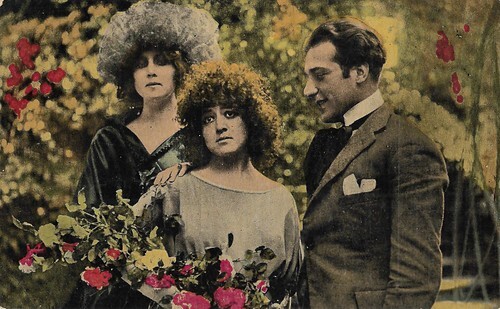
Spanish cromo by Chocolat Imperiale, Card 4 of 6. Photo: Gladiator Film / Distr. J. Verdaguer, Barcelona. Helena Makowska and Angelo Vianello in Folgore (Ugo De Simone, 1919).
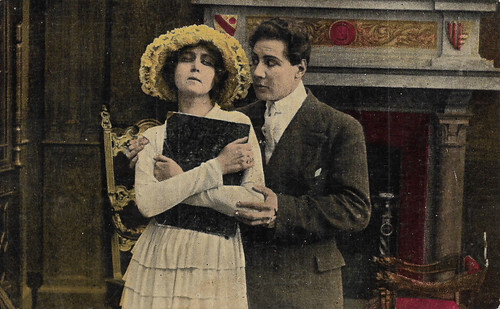
Spanish cromo by Chocolat Imperiale, Card 5 of 6. Photo: Gladiator Film / Distr. J. Verdaguer, Barcelona. Helena Makowska and François-Paul Donadio in Folgore (Ugo De Simone, 1919).
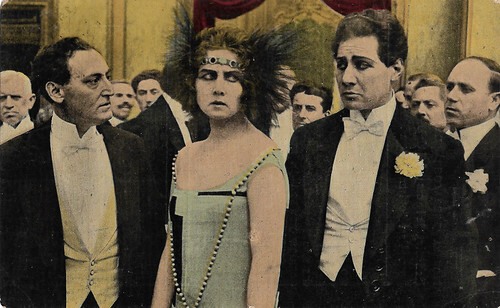
Spanish cromo by Chocolat Imperiale, Card 6 of 6. Photo: Gladiator Film / Distr. J. Verdaguer, Barcelona. Helena Makowska and, right, François-Paul Donadio in Folgore (Ugo De Simone, 1919).
Sources: Vittorio Martinelli (Il cinema muto italiano, Vol. 1918), IMDb and the cards themselves.

Spanish cromo (collectors card) by Chocolat Imperiale, Card 1 of 6. Photo: Gladiator Film / Distr. J. Verdaguer, Barcelona. Angelo Vianello and Helena Makowska in Folgore (Ugo De Simone, 1919), released in Spain as El Rayo.

Spanish cromo by Chocolat Imperiale, Card 2 of 6. Photo: Gladiator Film / Distr. J. Verdaguer, Barcelona. Angelo Vianello and Helena Makowska in Folgore (Ugo De Simone, 1919).

Spanish cromo by Chocolat Imperiale, Card 3 of 6. Photo: Gladiator Film / Distr. J. Verdaguer, Barcelona. Helena Makowska and Angelo Vianello in Folgore (Ugo De Simone, 1919).
A gentle story of love and art
In Folgore (Ugo De Simone, 1919) a talented young composer (Angelo Vianello) humbly asks the eminent diva ( Helena Makowska ) her opinion about his new composition, hoping she may promote it. Detesting big city life, he quietly works on his compositions at his estate. The curious diva visits him with her friends and invites him to join her. They fall in love.
As if to castigate him for his abandonment and new frivolous life, nature blinds him with a lightning bolt (hence the film's title). His beloved steals his last successful composition, called 'Folgore' (Lightning), and tries to sell it to a rich friend of the artist (François-Paul Donadio) who is also a musician, but the latter discovers the infamy and rejects it. The diva returns to her own life but now regrets her misstep. She wants to confess her guilt to the composer and return the manuscript, just when he is about to commit suicide. When trying to prevent him from his act, she dies herself.
Folgore had sets by Filippo De Simone and cinematography by Luigi Florio. Director Ugo De Simone was known for such Gladiator Film productions as L'amazzone macabra (1916), La figlia della tempesta (1917) and Maternità (1917), all starring another silent film diva, Italia Almirante-Manzini .
The premiere of Folgore (Ugo De Simone, 1919) happened in Rome on 29 January 1919, but on 7 August 1918, the critic of the journal La Vita Cinematografica already wrote a positive review of the film: "A gentle story of love and art, gracefully drawn, tastefully scripted and executed by a trio of actors who know their stuff. There is, in the whole and in the details, a search for the best, an aspiration to modernity and a sense of progressiveness, which show that lessons (which today, unfortunately, come to us from foreigners) benefit those who are not so infatuated with themselves as to believe themselves superior to any foreign inducement. [...]
We note with pleasure that Vianello is among the actors who show the most promise, and we do not spare Makowska praise, who is much better and much more effective than she was in a very recent time. Fine as always is Donadio, a mature and assured actor."

Spanish cromo by Chocolat Imperiale, Card 4 of 6. Photo: Gladiator Film / Distr. J. Verdaguer, Barcelona. Helena Makowska and Angelo Vianello in Folgore (Ugo De Simone, 1919).

Spanish cromo by Chocolat Imperiale, Card 5 of 6. Photo: Gladiator Film / Distr. J. Verdaguer, Barcelona. Helena Makowska and François-Paul Donadio in Folgore (Ugo De Simone, 1919).

Spanish cromo by Chocolat Imperiale, Card 6 of 6. Photo: Gladiator Film / Distr. J. Verdaguer, Barcelona. Helena Makowska and, right, François-Paul Donadio in Folgore (Ugo De Simone, 1919).
Sources: Vittorio Martinelli (Il cinema muto italiano, Vol. 1918), IMDb and the cards themselves.
Published on November 14, 2023 22:00
November 13, 2023
Constant Rémy
Constant Rémy (1882-1957) was a French actor and director, who played in 66 films and many stage productions. At Pathé, he acted in around fifteen short films before the First World War, including one of the first French Westerns, La conscience du Cheval Rouge (1913). Later, Rémy made several silent films with director Gaston Roudès. His peak was in the 1930s when he acted in nearly thirty high-quality films. His sixty-sixth and last film was La tour de Nesle (1954) by Abel Gance
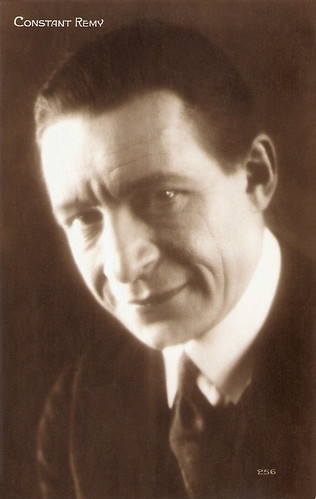
French postcard by Editions Cinémagazine, no. 256.

French publicity still by Films Osso. Albert Préjean and Constant Rémy in Un soir de rafle/Night Raid (Carmine Gallone, 1930). Statens Filmcensur refers to the Danish Film censorship institution that took its final form with the Danish Cinema Act of 1938.
Focus on historical drama
Constant Rémy was born in 1882 in Paris, France. Though his father wanted him to become a doctor, Rémy selected the stage. He made his debut at the Gaité Montparnasse. Eager to prove himself, he acted all over France, Belgium, Switzerland, and Algeria before WWI. During WWI, he was imprisoned in Belgium and once released, he was forced to sing operetta for the liberated Belgians. Back in Paris he returned to the stage and had enormous success with 'La Rafale' which had 175 reprisals. He also was successful in vaudeville with 'J'avais une Marraine' at the Marigny theatre.
Rémy started acting in cinéma in his twenties. He focused on historical drama. He made his film debut for Pathé Frères in the short period piece Benvenuto Cellini (Albert Capellani, Camille de Morlhon, 1908). Then he also acted at Gaumont, and finally at Eclipse, where he stayed for some time. At Eclipse, he started to work with director Gaston Roudès, with whom he would often collaborate during his career. Their first film together was Sa petite fille (Gaston Roudès, 1911).
Another director with whom Rémy often worked at Eclipse was Henri Desfontaines. Rémy appeared at Eclipse also in modern dramas and Westerns, and he acted opposite such actors as Joë Hamman , Aimée Tessandier, and Germaine Dermoz . In an interview in Cinémagazine in the 1920s, Rémy reminded the nerve-wracking stunts he had to do with Roudès in those wild-west-like years of early cinema. Between 1914 and 1918, Rémy stopped film acting, probably because of the war, and only appeared in one film, Le baron mystère (Maurice Challiol, 1918).
From 1920 Rémy had again a steady career in film acting, though he didn't make too many films per year. Opposite France Dhélia , he had a major part in the drama of jealousy, L'ombre du bonheur (Gaston Roudès, 1924). He played the title character in Altemer le cynique (Georges Monca, 1924), about a beautiful harbour den dancer, Gina Zunga ( Geneviève Félix ), who is in the grip of a brutal character, Albéric Altemer. Despite her attraction to a young, naive lawyer (Fernand Herrmann), she cannot escape the fatal force of crime. Herrmann, Felix and Rémy played together again in L'ironie du sort/The Irony of Fate (Maurice Kéroul, Georges Monca, 1924).
Gaston Roudès gave him another lead in La Douleur (1925), also with France Dhélia and Lucien Dalsace . Albert-Francis Bertoni directed him in Les frères Zemganno (1926), which evolved in the circus world and was based on a novel by Edmond de Goncourt. Roudès let Rémy star again opposite - again - Dhélia in Le chemin de la gloire (Gaston Roudès, 1927), about a doctor who discovers a serum against cancer and tests it on one of his patients. Henri Debain gave him a supporting part in a Huguette Duflos vehicle, Chantage (1927) and an important role in Hara-Kiri (Henri Debain, Marie-Louise Iribe, 1928). It was Rémy's last silent film.
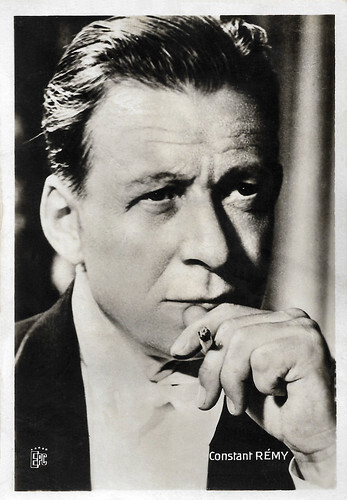
French card by EPC.
An easy passage to sound film
Two years later, after sound cinema had set in, Constant Rémy's first film part was in the French version of the German-English disaster film Atlantic, called Atlantis (1930), directed by Ewald André Dupont et Jean Kemm. The film was shot by British International Pictures at Elstree Studios, the first European studio to be equipped for sound film recording. Such Multiple-language versions were common in the early years of sound before dubbing became a more established practice. Atlantis, inspired by the Titanic disaster, was cinematographed by the reputed Charles Rosher, while Alice Field and Maxime Desjardins were Rémy's co-actors. Thanks to his diction skills from the stage, Rémy fairly easily made the passage into French sound film.
In the years 1933-1936, he did several films per year, including three films with Gaston Roudès: Roger la Honte (1933), Le Petit Jacques/Little Jacques (1934), and Le chant de l'amour (1935). Roger la Honte, based on a novel by Jules Mary, narrates the events of a man unjustly accused, taking the blame for his mistress, Julia de Noirville ( France Dhélia ). He escapes from prison and goes into hiding for years. Then he poses as a rich American and manages to unmask the real murder. In addition to many films in which was among the three to five top names in the cast, e.g. Un soir de rafle/Night Raid (Carmine Gallone, 1930), La Femme nue/The Naked Woman (Jean-Paul Paulin, 1932), L'Agonie des aigles/The Death Agony of the Eagles (Roger Richebé, 1933), and Les Mystères de Paris/Mysteries of Paris (Félix Gandéra, 1935),
Rémy had leads in La robe rouge/The Red Robe (Jean de Marguenat, 1933), La Rue sans nom/Street Without a Name (Pierre Chenal, 1934), Son autre amour/His Other Love (Alfred Machin, Constant Rémy, 1934) - which he co-directed -, and Poliche (Abel Gance, 1934). In the latter, he is a man who pretends to be a party guy but proves to be seriously in love with a woman ( Marie Bell ). His peak continued with the lead in Sous la griffe (Christian-Jaque, 1935), about a circus director who falls in love with his adopted daughter, the male lead opposite Madeleine Renaud in Hélène (Jean Benoît-Lévy, Marie Epstein, 1936), and again in Les petites alliées (Jean Dréville, 1936), and the lead in Passeurs d'hommes (René Jayet, 1937) about Belgians fleeing to the Netherlands during WWI.
Rémy had the lead as a colonel in the Foreign Legion in Les hommes sans nom/The Men Without Names (Jean Vallée, 1937) and again played a commander in Ceux de demain (Adelqui Millar, Georges Pallu, 1938). He accused himself of murder to save his son in the court case film La goualeuse/Street Singer (Fernand Rivers, 1938), while he had a supporting part in another Foreign Legion film, Le chemin de l'honneur/Path of Honor (Jean-Paul Paulin, 1939). In the war years, Rémy only acted in 2 films. Espoirs.../Hopes... (1941) was about two fathers (Rémy and Larquey) who oppose the relationship of Robert Lynen with Jacqueline Roman. In Monsieur des Lourdines (Pierre de Hérain, 1943) based on Chateaubriant, Rémy was the title character.
After WWII, only a handful of parts followed: Les clandestins/Clandestine (André Chotin, 1946), Les gosses mènent l'enquête/The Kids Are Leading the Investigation (Maurice Labro, 1947) - a high school suicide drama in which Rémy had an important part, Si Versailles m'était conté.../Royal Affairs in Versailles (Sacha Guitry, 1954) - in which Rémy played La Reynie, founding father of the French criminal police - and the period piece La tour de Nesle/Tower of Nesle (Abel Gance, 1955). In addition, Rémy had a rich stage career, acting at the Comédie Française in the 1920s, and also was highly active in music hall and vaudeville in the 1920s (which he claimed himself was a much better pay), but extending his stage performances well into the early 1950s. In the early 1930s, he also worked as a voice actor. Constant Rémy died in 1957 in Cannes, France. He was 75.
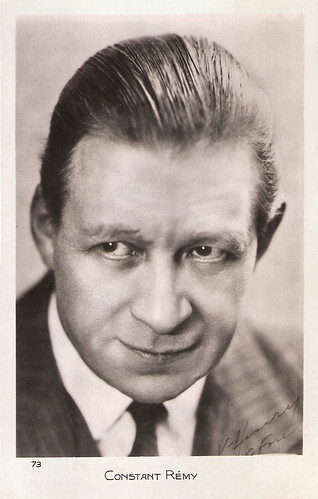
French postcard, no. 73.
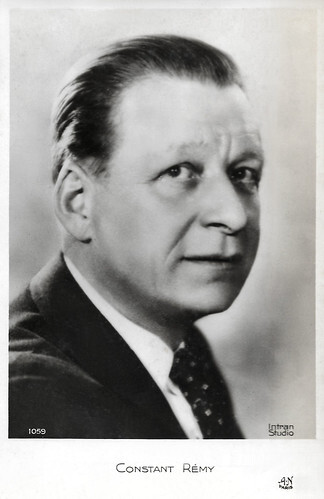
French postcard by A.N., Paris, no. 1059. Photo: Intran Studio.
Sources: Cineressources (French), Wikipedia (French and English) and .

French postcard by Editions Cinémagazine, no. 256.

French publicity still by Films Osso. Albert Préjean and Constant Rémy in Un soir de rafle/Night Raid (Carmine Gallone, 1930). Statens Filmcensur refers to the Danish Film censorship institution that took its final form with the Danish Cinema Act of 1938.
Focus on historical drama
Constant Rémy was born in 1882 in Paris, France. Though his father wanted him to become a doctor, Rémy selected the stage. He made his debut at the Gaité Montparnasse. Eager to prove himself, he acted all over France, Belgium, Switzerland, and Algeria before WWI. During WWI, he was imprisoned in Belgium and once released, he was forced to sing operetta for the liberated Belgians. Back in Paris he returned to the stage and had enormous success with 'La Rafale' which had 175 reprisals. He also was successful in vaudeville with 'J'avais une Marraine' at the Marigny theatre.
Rémy started acting in cinéma in his twenties. He focused on historical drama. He made his film debut for Pathé Frères in the short period piece Benvenuto Cellini (Albert Capellani, Camille de Morlhon, 1908). Then he also acted at Gaumont, and finally at Eclipse, where he stayed for some time. At Eclipse, he started to work with director Gaston Roudès, with whom he would often collaborate during his career. Their first film together was Sa petite fille (Gaston Roudès, 1911).
Another director with whom Rémy often worked at Eclipse was Henri Desfontaines. Rémy appeared at Eclipse also in modern dramas and Westerns, and he acted opposite such actors as Joë Hamman , Aimée Tessandier, and Germaine Dermoz . In an interview in Cinémagazine in the 1920s, Rémy reminded the nerve-wracking stunts he had to do with Roudès in those wild-west-like years of early cinema. Between 1914 and 1918, Rémy stopped film acting, probably because of the war, and only appeared in one film, Le baron mystère (Maurice Challiol, 1918).
From 1920 Rémy had again a steady career in film acting, though he didn't make too many films per year. Opposite France Dhélia , he had a major part in the drama of jealousy, L'ombre du bonheur (Gaston Roudès, 1924). He played the title character in Altemer le cynique (Georges Monca, 1924), about a beautiful harbour den dancer, Gina Zunga ( Geneviève Félix ), who is in the grip of a brutal character, Albéric Altemer. Despite her attraction to a young, naive lawyer (Fernand Herrmann), she cannot escape the fatal force of crime. Herrmann, Felix and Rémy played together again in L'ironie du sort/The Irony of Fate (Maurice Kéroul, Georges Monca, 1924).
Gaston Roudès gave him another lead in La Douleur (1925), also with France Dhélia and Lucien Dalsace . Albert-Francis Bertoni directed him in Les frères Zemganno (1926), which evolved in the circus world and was based on a novel by Edmond de Goncourt. Roudès let Rémy star again opposite - again - Dhélia in Le chemin de la gloire (Gaston Roudès, 1927), about a doctor who discovers a serum against cancer and tests it on one of his patients. Henri Debain gave him a supporting part in a Huguette Duflos vehicle, Chantage (1927) and an important role in Hara-Kiri (Henri Debain, Marie-Louise Iribe, 1928). It was Rémy's last silent film.

French card by EPC.
An easy passage to sound film
Two years later, after sound cinema had set in, Constant Rémy's first film part was in the French version of the German-English disaster film Atlantic, called Atlantis (1930), directed by Ewald André Dupont et Jean Kemm. The film was shot by British International Pictures at Elstree Studios, the first European studio to be equipped for sound film recording. Such Multiple-language versions were common in the early years of sound before dubbing became a more established practice. Atlantis, inspired by the Titanic disaster, was cinematographed by the reputed Charles Rosher, while Alice Field and Maxime Desjardins were Rémy's co-actors. Thanks to his diction skills from the stage, Rémy fairly easily made the passage into French sound film.
In the years 1933-1936, he did several films per year, including three films with Gaston Roudès: Roger la Honte (1933), Le Petit Jacques/Little Jacques (1934), and Le chant de l'amour (1935). Roger la Honte, based on a novel by Jules Mary, narrates the events of a man unjustly accused, taking the blame for his mistress, Julia de Noirville ( France Dhélia ). He escapes from prison and goes into hiding for years. Then he poses as a rich American and manages to unmask the real murder. In addition to many films in which was among the three to five top names in the cast, e.g. Un soir de rafle/Night Raid (Carmine Gallone, 1930), La Femme nue/The Naked Woman (Jean-Paul Paulin, 1932), L'Agonie des aigles/The Death Agony of the Eagles (Roger Richebé, 1933), and Les Mystères de Paris/Mysteries of Paris (Félix Gandéra, 1935),
Rémy had leads in La robe rouge/The Red Robe (Jean de Marguenat, 1933), La Rue sans nom/Street Without a Name (Pierre Chenal, 1934), Son autre amour/His Other Love (Alfred Machin, Constant Rémy, 1934) - which he co-directed -, and Poliche (Abel Gance, 1934). In the latter, he is a man who pretends to be a party guy but proves to be seriously in love with a woman ( Marie Bell ). His peak continued with the lead in Sous la griffe (Christian-Jaque, 1935), about a circus director who falls in love with his adopted daughter, the male lead opposite Madeleine Renaud in Hélène (Jean Benoît-Lévy, Marie Epstein, 1936), and again in Les petites alliées (Jean Dréville, 1936), and the lead in Passeurs d'hommes (René Jayet, 1937) about Belgians fleeing to the Netherlands during WWI.
Rémy had the lead as a colonel in the Foreign Legion in Les hommes sans nom/The Men Without Names (Jean Vallée, 1937) and again played a commander in Ceux de demain (Adelqui Millar, Georges Pallu, 1938). He accused himself of murder to save his son in the court case film La goualeuse/Street Singer (Fernand Rivers, 1938), while he had a supporting part in another Foreign Legion film, Le chemin de l'honneur/Path of Honor (Jean-Paul Paulin, 1939). In the war years, Rémy only acted in 2 films. Espoirs.../Hopes... (1941) was about two fathers (Rémy and Larquey) who oppose the relationship of Robert Lynen with Jacqueline Roman. In Monsieur des Lourdines (Pierre de Hérain, 1943) based on Chateaubriant, Rémy was the title character.
After WWII, only a handful of parts followed: Les clandestins/Clandestine (André Chotin, 1946), Les gosses mènent l'enquête/The Kids Are Leading the Investigation (Maurice Labro, 1947) - a high school suicide drama in which Rémy had an important part, Si Versailles m'était conté.../Royal Affairs in Versailles (Sacha Guitry, 1954) - in which Rémy played La Reynie, founding father of the French criminal police - and the period piece La tour de Nesle/Tower of Nesle (Abel Gance, 1955). In addition, Rémy had a rich stage career, acting at the Comédie Française in the 1920s, and also was highly active in music hall and vaudeville in the 1920s (which he claimed himself was a much better pay), but extending his stage performances well into the early 1950s. In the early 1930s, he also worked as a voice actor. Constant Rémy died in 1957 in Cannes, France. He was 75.

French postcard, no. 73.

French postcard by A.N., Paris, no. 1059. Photo: Intran Studio.
Sources: Cineressources (French), Wikipedia (French and English) and .
Published on November 13, 2023 22:00
November 12, 2023
Roberto Benigni
Roberto Benigni (1952) is Italy’s most popular film comedian since Totó. He worked with famous directors like Jim Jarmusch, Marco Ferreri, Bernardo Bertolucci, Federico Fellini, Wim Wenders, and Woody Allen. Benigni also directed several comedies himself, including the award-winning La vita è bella/Life Is Beautiful (1997).
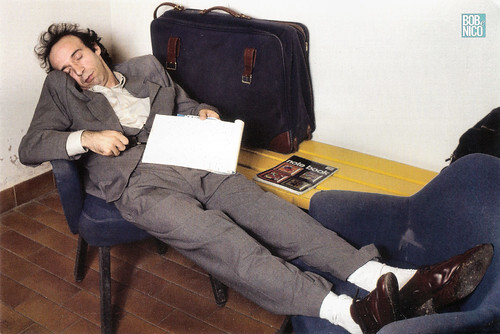
Italian postcard by Cineteca Bologna for the exhibition 'Bob e Nico'. Photo: Mimmo Cattarinich. Roberto Benigni during an interval of the shooting of Il Mostro/The Monster (Roberto Benigni, 1994).
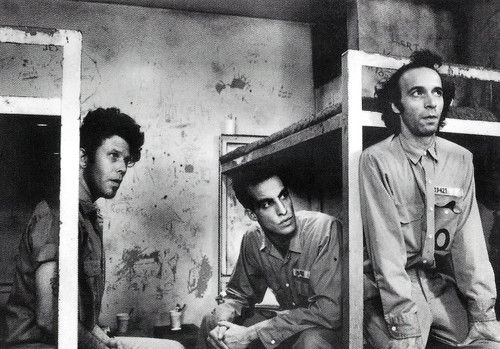
Vintage postcard, no. Z.1071. Tom Waits, John Lurie and Roberto Benigni in Down By Law (Jim Jarmusch, 1986).
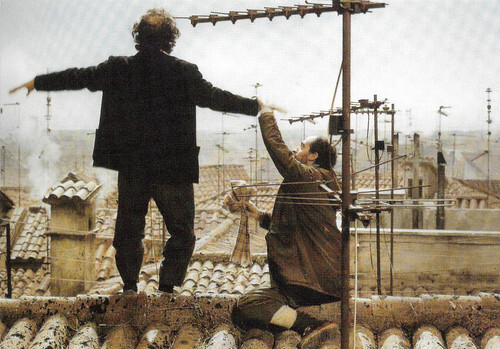
Taiwanese promotion card by CoolCard to promote the exhibition 'Absolute Fellini' (2007). Photo: Roberto Benigni and Angelo Orlando in La Voce della luna/The Voice of the Moon (Federico Fellini, 1990).
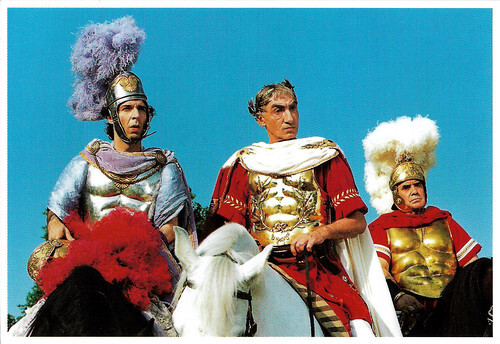
Small French postcard by McCann Communications, Nanterre, offered by AGFA. Photo: Etienne George / Renn Productions. Roberto Benigni, Gottfried John and Jean-Pierre Castaldi in Astérix & Obélix contre César/Asterix and Obelix vs Caesar (Claude Zidi, 1999).
Altar boy
Roberto Remigio Benigni was born in Manciano La Misericordia, Italy, 1952. His parents were Luigi Benigni and Isolina Papini and he has three sisters. His father worked as a farmer, carpenter and bricklayer. He was a prisoner in the concentration camp Bergen-Belsen between 1943 and 1945. Roberto used his stories as the basis for his film La vita è bella (1997). His mother worked as a fabric inspector. Roberto was raised Catholic, served as an altar boy and attended a seminary in Florence, planning to become a priest.
In 1971, he moved to Rome where he took part in some experimental theatre shows, some of which he also directed. In 1975, Benigni had his first theatrical success with the play Cioni Mario di Gaspare fu Giulia (1975), written and directed by Giuseppe Bertolucci. Benigni played Mario Cioni, a character he later resumed in the variety TV series Onda Libera (Renzo Arbore, 1976). Benigni became famous in Italy when he interpreted in Onda Libera the satirical song L'inno del corpo sciolto (The Hymn of the Slippery Body), about the joys of defecation. It caused such a scandal that the censors suspended the series.
Benigni played Mario Cioni again in his first film, the comedy Berlinguer ti voglio bene/Berlinguer, I Love You (Giuseppe Bertolucci, 1977) with Alida Valli as his mother. The title quotes Benigni´s character´s declaration of love for Enrico Berlinguer, then leader of the Italian Communist Party. Later, Benigni appeared during a public political demonstration by the Italian Communist Party. On this occasion, he lifted and cradled Berlinguer, normally a very serious figure. It was an unprecedented but very successful act, which led politicians to exhibit more popular behaviour from that moment on.
His popularity increased with L'altra domenica (1976-1979), another TV show in which Benigni portrays a lazy film critic who never watches the films he's asked to review. In 1979 he had an international success with the symbolic social drama Chiedo asilo/Seeking Asylum (Marco Ferreri, 1979) about a well-meaning teacher and his young pre-school class. The film was entered into the 30th Berlin International Film Festival where it won the Silver Bear - Special Jury Prize. Bernardo Bertolucci cast him in a small speechless role as a window upholsterer in La Luna/Luna (1979) starring Jill Clayburgh.
In 1980 Benigni met actress Nicoletta Braschi , who in 1991 became his wife. She co-starred in his first film as director, the comedy Tu mi turbi/You Upset Me (Roberto Benigni, 1983) and in most of his later films. Next, he played with the popular comic actor Massimo Troisi in Non ci resta che piangere/Nothing Left To Do But Cry (Roberto Benigni, Massimo Troisi, 1984). In this fable, the two protagonists are suddenly thrown back in time to the 15th century, just a little before 1492. They start looking for Christopher Columbus to stop him from discovering the Americas (for very personal love reasons) but are not able to reach him.
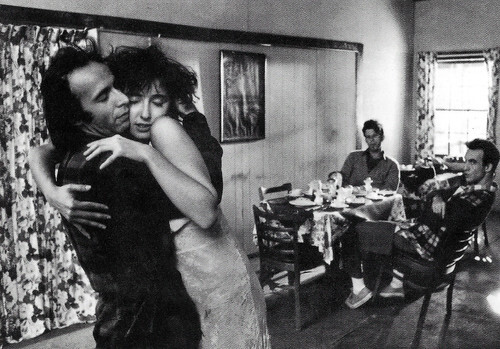
Vintage postcard, no. Z.1069. Roberto Benigni, Nicoletta Braschi, Tom Waits and John Lurie in Down By Law (Jim Jarmusch, 1986).

Italian postcard by Cineteca Bologna. Photo: Mario Tursi. Publicity still for Il piccolo diavolo/The Little Devil (Roberto Benigni, 1988) with Nicoletta Braschi .
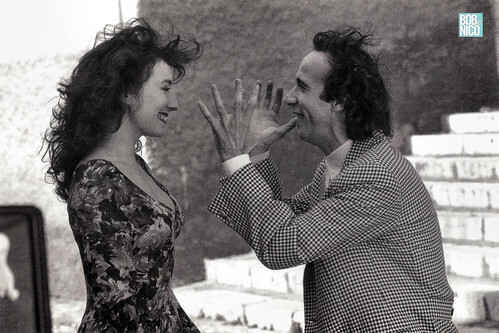
Italian postcard by Cineteca Bologna. Photo: Mario Tursi. Nicoletta Braschi and Roberto Benigni in Il piccolo diavolo/The Little Devil (Roberto Benigni, 1988).
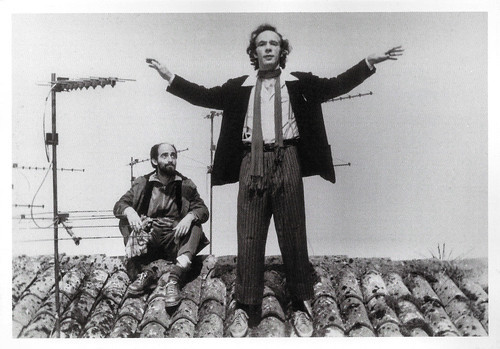
French postcard by DR. Photo: La Cinémathèque Française. Roberto Benigni and Angelo Orlando in La Voce della luna/The Voice of the Moon (Federico Fellini, 1990).
Irrepressible good humour
Roberto Benigni was censored again in the 1980s for calling Pope John Paul II ‘Wojtylaccio’ during a TV show (‘Wojtylaccio’, translates as ‘Bad Wojtyla’, but with a friendly meaning in Tuscan dialect). Benigni starred in three films by American director Jim Jarmusch. In Down By Law (Jim Jarmusch, 1986) he played Bob, an innocent foreigner living in the United States, convicted of manslaughter, whose irrepressible good humour and optimism help him to escape and find love. His co-stars were Tom Waits, John Lurie and Nicoletta Braschi , who of course played his beloved. In Night on Earth (Jim Jarmusch, 1991) he played a cabbie in Rome, who causes his passenger, a priest (Paolo Bonacelli), great discomfort and a fatal heart attack by confessing his bizarre sexual experiences. He also starred in the first of Jarmusch's segments in Coffee and Cigarettes (2003).
In 1988 Benigni began a long-lasting collaboration with screenwriter Vincenzo Cerami. Their first film was Il piccolo diavolo/The Little Devil (Roberto Benigni, 1988) with Walter Matthau. For his part as the little devil, Benigni won the David di Donatello Award for Best Actor. It was the start of a series of comedies that were very popular in Italy, including Johnny Stecchino/Johnny Toothpick (Roberto Benigni, 1992), and Il mostro/The Monster (Roberto Benigni, Yves Attal, 1994). The box-office hit Johnny Stecchino, brought him considerable international attention.
Benigni had a rare serious role in Fellini's last film, La voce della luna/The Voice of the Moon (Federico Fellini, 1989). He also starred in Wim Wenders' Faraway, So Close (1993) and Son of the Pink Panther (Blake Edwards, 1993) as Inspector Clouseau's ( Peter Sellers ) illegitimate son who is assigned to save the Princess of Lugash. Also in this film are Panther regulars Herbert Lom , Burt Kwouk and a star of the original 1963 film, Claudia Cardinale . The film bombed in the US, but was a hit in Italy.
Outside his homeland, Benigni is probably best known for his tragicomedy La vita è bella/Life Is Beautiful (Roberto Benigni, 1997), also written by Vincenzo Cerami. The film is about an Italian Jewish man who tries to protect his son's innocence during his internment at a Nazi concentration camp, by telling him that the Holocaust is an elaborate game and he must adhere very carefully to the rules to win. Benigni's father had spent three years in a concentration camp in Bergen-Belsen, and La vita è bella is based in part on his father's experiences. Although the story and presentation of the film had been discussed during production with different Jewish groups to limit the offence it might cause, critics accused the film of presenting the Holocaust without much suffering.
La vita è bella was shown at the 1998 Cannes Film Festival and won the Grand Prix. In 1999 Benigni also won the Oscar for Best Actor. The score by Nicola Piovani won another Oscar for Best Original Dramatic Score, and the film was awarded the Oscar for Best Foreign Language Film. Famously, Benigni climbed over and then stood on the backs of the seats in front of him and applauded the audience before proceeding to the stage. After winning his Best Actor Oscar, he said in his acceptance speech, "This is a terrible mistake because I used up all my English!" The film grossed worldwide more than $200 million. He then appeared in the live-action film Astérix & Obélix contre César/Asterix and Obelix vs Caesar (Claude Zidi, 1999), based on Goscinny and Uderzo's Astérix comics and featuring Christian Clavier as Asterix and Gérard Depardieu as Obélix. Benigni played Lucius Detritus, a corrupt Roman provincial governor who wants to kill Julius Caesar.
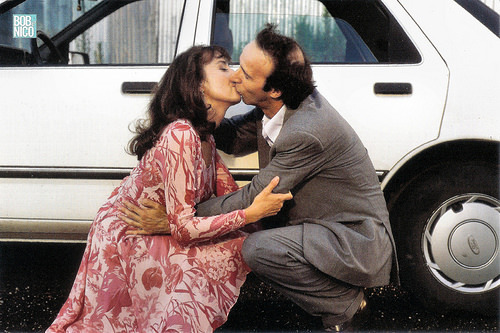
Italian postcard by Cineteca Bologna. Photo: Mimmo Cattarinich. Publicity still for Il Mostro/The Monster (Roberto Benigni, 1994) with Nicoletta Braschi .
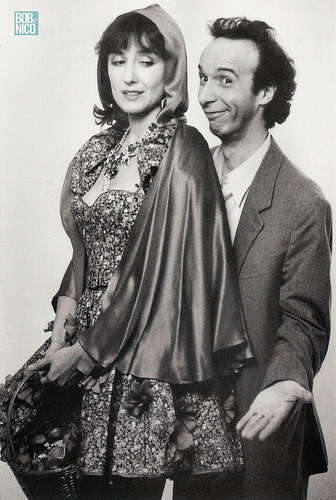
Italian postcard by Cineteca Bologna. Photo: Mimmo Cattarinich. Publicity still for Il Mostro/The Monster (Roberto Benigni, 1994) with Nicoletta Braschi .
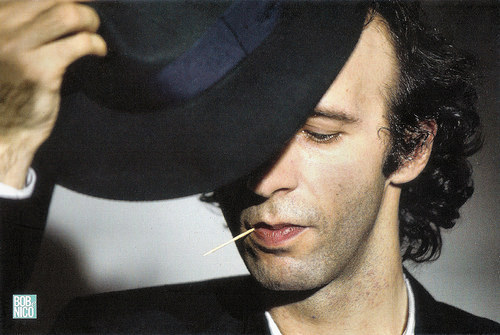
Italian postcard by Cineteca Bologna. Photo: Mimmo Catarinich.
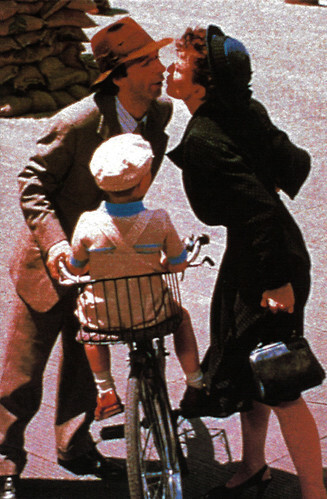
Vintage postcard, no. 6341. Roberto Benigni, Nicoletta Braschi and Giorgio Cantarini in La vita e bella (Roberto Benigni, 1997).
Donatello and Raspberry Awards
Roberto Benigni’s next film, the live-action Pinocchio (Roberto Benigni, 2002) was one of the costliest films in Italian cinema ever. It performed well in Italy, but it bombed in North America. Pinocchio received six nominations at the David di Donatello Awards, winning two, as well as winning one of the two awards it was nominated for at the Italian National Syndicate of Film Journalists. At the 23rd Golden Raspberry Awards, however, Benigni was named as the Worst Actor for his role as Pinocchio.
Benigni gave a typically energetic and revealing interview for Fellini: I'm a Born Liar (Damian Pettigrew, 2002), a cinematic portrait of the maestro that was nominated for Best Documentary at the European Film Awards.
His next film was La tigre e la neve/The Tiger and the Snow (Roberto Benigni, 2005) a romantic comedy set in contemporary Rome and in occupied Baghdad during the Iraq War.
In 2006 and 2007, Benigni toured Italy with his 90-minute one-man show 'TuttoDante' (Everything About Dante). Combining current events and memories of his past narrated with an ironic tone, Benigni then begins a journey of poetry and passion through the world of the Divine Comedy. He performed 'TuttoDante' during 130 shows in Italian piazzas, arenas, and stadiums for about one million spectators. Over 10 million more spectators watched the TV show, Il V canto dell’Inferno/The 5th Song of Hell (2007). In 2008-2009, Benigni brought 'TuttoDante' to the United States and Canada.
His latest film appearance was in a segment of To Rome with Love (Woody Allen, 2012). Benigni played a man who wakes up one morning to discover that he has inexplicably become a national celebrity. To Rome with Love received mixed reviews but was a box office success. In 2019, he starred as Mister Geppetto in Matteo Garrone's adaptation of Pinocchio (2019). Pinocchio was met with positive reviews from critics. It received 15 nominations at the 2020 David di Donatello Awards, nine nominations at the Nastro d'Argento Awards, and two Academy Award nominations. Benigni won the Nastro d'Argento for Best Supporting Actor.
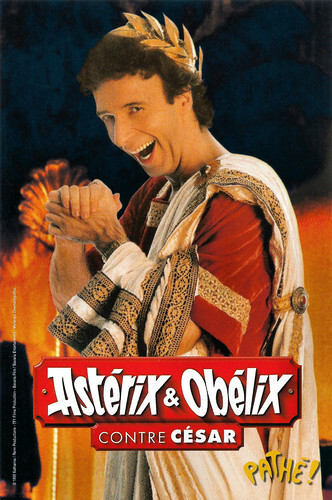
French postcard by Pathé. Photo: Katharina / Renn Productions / TF1 Films Production / Bavaria Entertainment / Canal+. Roberto Benigni in Astérix & Obélix contre César/Asterix and Obelix vs Caesar (Claude Zidi, 1999).
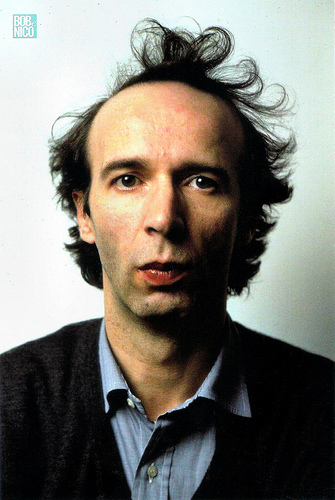
Italian postcard by Cineteca Bologna. Photo: Mimmo Catarinich.
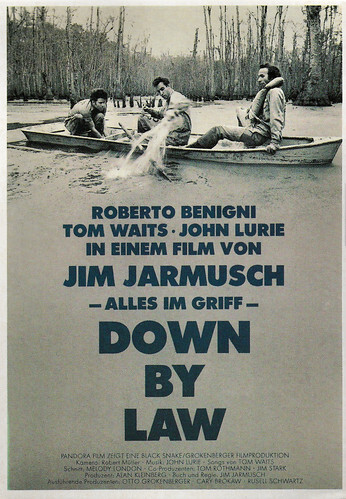
French postcard by Editions Humour à la Carte, Paris, no. A-C 1265. Photo: German poster by Pandora Film. Roberto Benigni, Tom Waits and John Lurie in Down By Law (Jim Jarmusch, 1986).
Sources: Hal Erickson (AllMovie), Wikipedia and .

Italian postcard by Cineteca Bologna for the exhibition 'Bob e Nico'. Photo: Mimmo Cattarinich. Roberto Benigni during an interval of the shooting of Il Mostro/The Monster (Roberto Benigni, 1994).

Vintage postcard, no. Z.1071. Tom Waits, John Lurie and Roberto Benigni in Down By Law (Jim Jarmusch, 1986).

Taiwanese promotion card by CoolCard to promote the exhibition 'Absolute Fellini' (2007). Photo: Roberto Benigni and Angelo Orlando in La Voce della luna/The Voice of the Moon (Federico Fellini, 1990).

Small French postcard by McCann Communications, Nanterre, offered by AGFA. Photo: Etienne George / Renn Productions. Roberto Benigni, Gottfried John and Jean-Pierre Castaldi in Astérix & Obélix contre César/Asterix and Obelix vs Caesar (Claude Zidi, 1999).
Altar boy
Roberto Remigio Benigni was born in Manciano La Misericordia, Italy, 1952. His parents were Luigi Benigni and Isolina Papini and he has three sisters. His father worked as a farmer, carpenter and bricklayer. He was a prisoner in the concentration camp Bergen-Belsen between 1943 and 1945. Roberto used his stories as the basis for his film La vita è bella (1997). His mother worked as a fabric inspector. Roberto was raised Catholic, served as an altar boy and attended a seminary in Florence, planning to become a priest.
In 1971, he moved to Rome where he took part in some experimental theatre shows, some of which he also directed. In 1975, Benigni had his first theatrical success with the play Cioni Mario di Gaspare fu Giulia (1975), written and directed by Giuseppe Bertolucci. Benigni played Mario Cioni, a character he later resumed in the variety TV series Onda Libera (Renzo Arbore, 1976). Benigni became famous in Italy when he interpreted in Onda Libera the satirical song L'inno del corpo sciolto (The Hymn of the Slippery Body), about the joys of defecation. It caused such a scandal that the censors suspended the series.
Benigni played Mario Cioni again in his first film, the comedy Berlinguer ti voglio bene/Berlinguer, I Love You (Giuseppe Bertolucci, 1977) with Alida Valli as his mother. The title quotes Benigni´s character´s declaration of love for Enrico Berlinguer, then leader of the Italian Communist Party. Later, Benigni appeared during a public political demonstration by the Italian Communist Party. On this occasion, he lifted and cradled Berlinguer, normally a very serious figure. It was an unprecedented but very successful act, which led politicians to exhibit more popular behaviour from that moment on.
His popularity increased with L'altra domenica (1976-1979), another TV show in which Benigni portrays a lazy film critic who never watches the films he's asked to review. In 1979 he had an international success with the symbolic social drama Chiedo asilo/Seeking Asylum (Marco Ferreri, 1979) about a well-meaning teacher and his young pre-school class. The film was entered into the 30th Berlin International Film Festival where it won the Silver Bear - Special Jury Prize. Bernardo Bertolucci cast him in a small speechless role as a window upholsterer in La Luna/Luna (1979) starring Jill Clayburgh.
In 1980 Benigni met actress Nicoletta Braschi , who in 1991 became his wife. She co-starred in his first film as director, the comedy Tu mi turbi/You Upset Me (Roberto Benigni, 1983) and in most of his later films. Next, he played with the popular comic actor Massimo Troisi in Non ci resta che piangere/Nothing Left To Do But Cry (Roberto Benigni, Massimo Troisi, 1984). In this fable, the two protagonists are suddenly thrown back in time to the 15th century, just a little before 1492. They start looking for Christopher Columbus to stop him from discovering the Americas (for very personal love reasons) but are not able to reach him.

Vintage postcard, no. Z.1069. Roberto Benigni, Nicoletta Braschi, Tom Waits and John Lurie in Down By Law (Jim Jarmusch, 1986).

Italian postcard by Cineteca Bologna. Photo: Mario Tursi. Publicity still for Il piccolo diavolo/The Little Devil (Roberto Benigni, 1988) with Nicoletta Braschi .

Italian postcard by Cineteca Bologna. Photo: Mario Tursi. Nicoletta Braschi and Roberto Benigni in Il piccolo diavolo/The Little Devil (Roberto Benigni, 1988).

French postcard by DR. Photo: La Cinémathèque Française. Roberto Benigni and Angelo Orlando in La Voce della luna/The Voice of the Moon (Federico Fellini, 1990).
Irrepressible good humour
Roberto Benigni was censored again in the 1980s for calling Pope John Paul II ‘Wojtylaccio’ during a TV show (‘Wojtylaccio’, translates as ‘Bad Wojtyla’, but with a friendly meaning in Tuscan dialect). Benigni starred in three films by American director Jim Jarmusch. In Down By Law (Jim Jarmusch, 1986) he played Bob, an innocent foreigner living in the United States, convicted of manslaughter, whose irrepressible good humour and optimism help him to escape and find love. His co-stars were Tom Waits, John Lurie and Nicoletta Braschi , who of course played his beloved. In Night on Earth (Jim Jarmusch, 1991) he played a cabbie in Rome, who causes his passenger, a priest (Paolo Bonacelli), great discomfort and a fatal heart attack by confessing his bizarre sexual experiences. He also starred in the first of Jarmusch's segments in Coffee and Cigarettes (2003).
In 1988 Benigni began a long-lasting collaboration with screenwriter Vincenzo Cerami. Their first film was Il piccolo diavolo/The Little Devil (Roberto Benigni, 1988) with Walter Matthau. For his part as the little devil, Benigni won the David di Donatello Award for Best Actor. It was the start of a series of comedies that were very popular in Italy, including Johnny Stecchino/Johnny Toothpick (Roberto Benigni, 1992), and Il mostro/The Monster (Roberto Benigni, Yves Attal, 1994). The box-office hit Johnny Stecchino, brought him considerable international attention.
Benigni had a rare serious role in Fellini's last film, La voce della luna/The Voice of the Moon (Federico Fellini, 1989). He also starred in Wim Wenders' Faraway, So Close (1993) and Son of the Pink Panther (Blake Edwards, 1993) as Inspector Clouseau's ( Peter Sellers ) illegitimate son who is assigned to save the Princess of Lugash. Also in this film are Panther regulars Herbert Lom , Burt Kwouk and a star of the original 1963 film, Claudia Cardinale . The film bombed in the US, but was a hit in Italy.
Outside his homeland, Benigni is probably best known for his tragicomedy La vita è bella/Life Is Beautiful (Roberto Benigni, 1997), also written by Vincenzo Cerami. The film is about an Italian Jewish man who tries to protect his son's innocence during his internment at a Nazi concentration camp, by telling him that the Holocaust is an elaborate game and he must adhere very carefully to the rules to win. Benigni's father had spent three years in a concentration camp in Bergen-Belsen, and La vita è bella is based in part on his father's experiences. Although the story and presentation of the film had been discussed during production with different Jewish groups to limit the offence it might cause, critics accused the film of presenting the Holocaust without much suffering.
La vita è bella was shown at the 1998 Cannes Film Festival and won the Grand Prix. In 1999 Benigni also won the Oscar for Best Actor. The score by Nicola Piovani won another Oscar for Best Original Dramatic Score, and the film was awarded the Oscar for Best Foreign Language Film. Famously, Benigni climbed over and then stood on the backs of the seats in front of him and applauded the audience before proceeding to the stage. After winning his Best Actor Oscar, he said in his acceptance speech, "This is a terrible mistake because I used up all my English!" The film grossed worldwide more than $200 million. He then appeared in the live-action film Astérix & Obélix contre César/Asterix and Obelix vs Caesar (Claude Zidi, 1999), based on Goscinny and Uderzo's Astérix comics and featuring Christian Clavier as Asterix and Gérard Depardieu as Obélix. Benigni played Lucius Detritus, a corrupt Roman provincial governor who wants to kill Julius Caesar.

Italian postcard by Cineteca Bologna. Photo: Mimmo Cattarinich. Publicity still for Il Mostro/The Monster (Roberto Benigni, 1994) with Nicoletta Braschi .

Italian postcard by Cineteca Bologna. Photo: Mimmo Cattarinich. Publicity still for Il Mostro/The Monster (Roberto Benigni, 1994) with Nicoletta Braschi .

Italian postcard by Cineteca Bologna. Photo: Mimmo Catarinich.

Vintage postcard, no. 6341. Roberto Benigni, Nicoletta Braschi and Giorgio Cantarini in La vita e bella (Roberto Benigni, 1997).
Donatello and Raspberry Awards
Roberto Benigni’s next film, the live-action Pinocchio (Roberto Benigni, 2002) was one of the costliest films in Italian cinema ever. It performed well in Italy, but it bombed in North America. Pinocchio received six nominations at the David di Donatello Awards, winning two, as well as winning one of the two awards it was nominated for at the Italian National Syndicate of Film Journalists. At the 23rd Golden Raspberry Awards, however, Benigni was named as the Worst Actor for his role as Pinocchio.
Benigni gave a typically energetic and revealing interview for Fellini: I'm a Born Liar (Damian Pettigrew, 2002), a cinematic portrait of the maestro that was nominated for Best Documentary at the European Film Awards.
His next film was La tigre e la neve/The Tiger and the Snow (Roberto Benigni, 2005) a romantic comedy set in contemporary Rome and in occupied Baghdad during the Iraq War.
In 2006 and 2007, Benigni toured Italy with his 90-minute one-man show 'TuttoDante' (Everything About Dante). Combining current events and memories of his past narrated with an ironic tone, Benigni then begins a journey of poetry and passion through the world of the Divine Comedy. He performed 'TuttoDante' during 130 shows in Italian piazzas, arenas, and stadiums for about one million spectators. Over 10 million more spectators watched the TV show, Il V canto dell’Inferno/The 5th Song of Hell (2007). In 2008-2009, Benigni brought 'TuttoDante' to the United States and Canada.
His latest film appearance was in a segment of To Rome with Love (Woody Allen, 2012). Benigni played a man who wakes up one morning to discover that he has inexplicably become a national celebrity. To Rome with Love received mixed reviews but was a box office success. In 2019, he starred as Mister Geppetto in Matteo Garrone's adaptation of Pinocchio (2019). Pinocchio was met with positive reviews from critics. It received 15 nominations at the 2020 David di Donatello Awards, nine nominations at the Nastro d'Argento Awards, and two Academy Award nominations. Benigni won the Nastro d'Argento for Best Supporting Actor.

French postcard by Pathé. Photo: Katharina / Renn Productions / TF1 Films Production / Bavaria Entertainment / Canal+. Roberto Benigni in Astérix & Obélix contre César/Asterix and Obelix vs Caesar (Claude Zidi, 1999).

Italian postcard by Cineteca Bologna. Photo: Mimmo Catarinich.

French postcard by Editions Humour à la Carte, Paris, no. A-C 1265. Photo: German poster by Pandora Film. Roberto Benigni, Tom Waits and John Lurie in Down By Law (Jim Jarmusch, 1986).
Sources: Hal Erickson (AllMovie), Wikipedia and .
Published on November 12, 2023 22:00
November 11, 2023
Robert Montgomery
Robert Montgomery (1904-1981) was left penniless at the age of sixteen and became a mechanic's mate on a railway, a deck hand, and finally property man for a touring company, which resulted in a stage career. He played in stock for some time, mostly old man characters, and eventually reached New York. He had his film debut in So This is College (1929), while after Private Lives (1931) with Norma Shearer he became a star. Memorable pictures with him were e.g. The Big House (1930), Inspiration (1931), Hell Below (1933), No More Ladies (1935), Piccadilly Jim (1936), Mr. & Mrs. Smith (1941) and Here Comes Mr. Jordan (1941). From 1945 he directed films too, such as the Film Noir Lady in the Lake (1946).
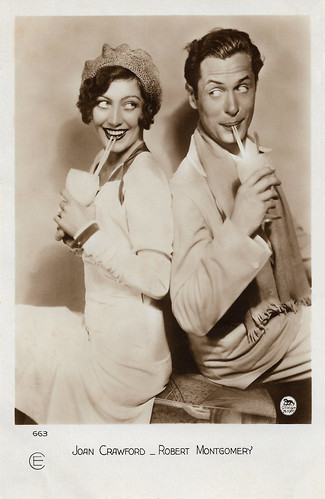
French postcard by Cinémagazine-Edition, Paris, no. 663. Photo: Metro-Goldwyn-Mayer. Joan Crawford and Robert Montgomery in Untamed (Jack Conway, 1929). Collection: Geoffrey Donaldson Institute.

British postcard in the Film Partners Series, London, no. P 47. Photo: Metro Goldwyn Mayer. Robert Montgomery and Joan Crawford in Our Blushing Brides (1930).
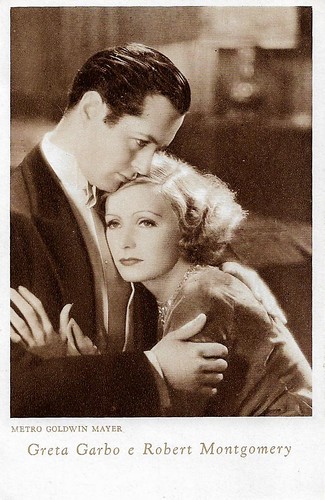
Italian postcard by Cinema-Illustrazione, Milano, Series 2, no. 3. Photo: Metro-Goldwyn-Mayer. Greta Garbo and Robert Montgomery in Inspiration (Clarence Brown, 1931).
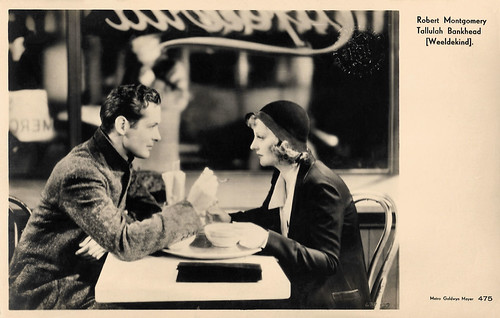
Dutch postcard, no. 475. Photo: M.G.M. (Metro Goldwyn Mayer). Robert Montgomery and Tallulah Bankhead in Faithless (Harry Beaumont, 1932).
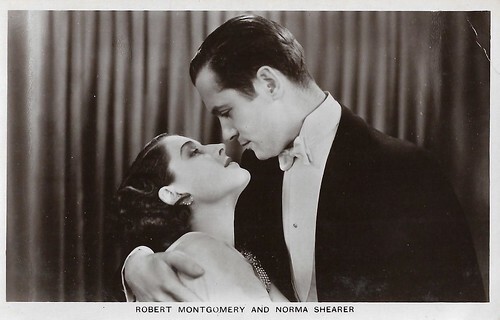
British postcard in the Film Partners series, London, no. P27. Robert Montgomery and Norma Shearer in Riptide (Edmund Goulding, 1934).
A screwball comedy by Alfred Hitchcock
Robert Montgomery was born Henry Montgomery Jr., in Beacon, New York, in 1904. He grew up very wealthy as the son of a New York businessman, the president of the New York Rubber Company. After his father's death, there was nothing left of the fortune for him, so he had to eke out a living with odd jobs.
He tried unsuccessfully as a writer and then also as an actor. The director George Cukor discovered him for the stage and Cukor gave him an entry to Hollywood and a contract with Metro-Goldwyn-Mayer. His first film for MGM was the comedy So This Is College (Sam Wood, 1929). He had his breakthrough as the weak-willed prisoner Kent in The Big House (George Hill, 1930).
The studio purposefully built him up as a star and Montgomery quickly played alongside established female stars. He appeared as Greta Garbo 's romantic interest in Inspiration (Clarence Brown, 1930). Norma Shearer cast him opposite her in The Divorcee (Robert Z. Leonard, 1930), Strangers May Kiss (George Fitzmaurice, 1931), and Private Lives (Sidney Franklin, 1931).
Montgomery appeared in the first filmed version of When Ladies Meet (1933), which starred Ann Harding and Myrna Loy . He made a total of six films with Joan Crawford , beginning with Untamed. In 1937, she starred opposite Marion Davies in Ever Since Eve, based on a play by the then-fashionable playwright Lawrence Riley.
He was often cast in charming and comedic roles, for example in the Alfred Hitchcock -directed screwball comedy Mr. and Mrs. Smith (1941) opposite Carole Lombard . Very successfully going against his usual type of role, he was cast as a psychopathic murderer in the thriller Night Must Fall (Richard Thorpe, 1937), for which he received the first of his two Oscar nominations. The second was for Here Comes Mr. Jordan (Alexander Hall, 1942) in which he played a boxer who is accidentally taken to heaven by an angel and reclaims his lost lifetime.
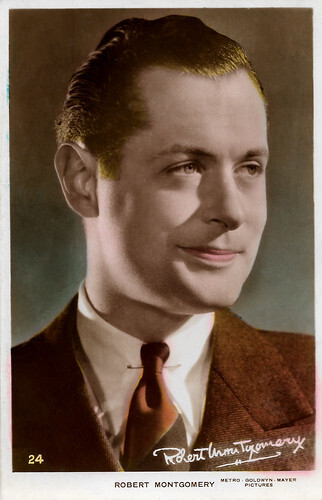
British Art Photo postcard, no. 24. Photo: Metro Goldwyn Mayer.
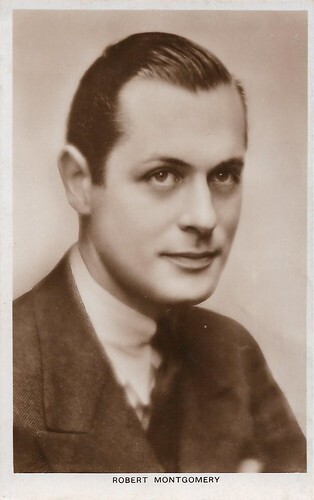
British postcard
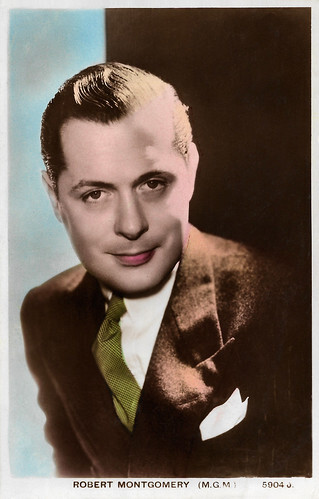
British postcard by Valentine's, no. 5904O. Photo: Metro-Goldwyn-Mayer Pictures.
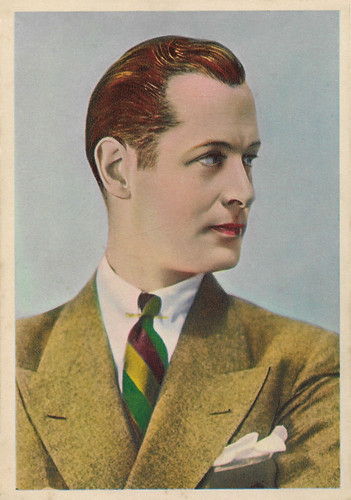
British postcard by De Reszke Cigarettes, no. 5. Photo: Metro-Goldwyn-Mayer (MGM).
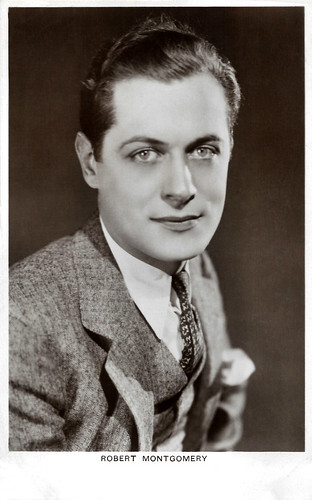
British postcard in the Picturegoer Series, London, no. 461.
An experimental Film Noir
Robert Montgomery's association with MGM lasted 16 years, interrupted only by the Second World War. After the U.S. entered World War II in December 1941, he joined the US Navy, rising to the rank of major. After his return from active service Robert Montgomery also began to work as a director.
He made his directorial debut, but without credits, in They Were Expendable (John Ford, 1945), where he directed some of the PT Boat scenes when director John Ford was unable to work for health reasons. His best-known film as a director is The Lady in the Lake (1947), an experimental Film Noir shot entirely from the hero's perspective with a subjective camera.
Active in Republican politics and concerned about communist influence in the entertainment industry, he was a friendly witness before the Committee on Un-American Activities in 1947. Montgomery was one of the first Hollywood stars to move to television. He hosted the Emmy Award-winning television series, Robert Montgomery Presents. The series, produced between 1950 and 1957, proved very popular.
The Gallant Hours (1960), a film Montgomery directed and co-produced with its star, his friend James Cagney , was the last film or television production he worked on. Montgomery served as president of the Screen Actors Guild from 1935 to 1938 and again from 1946 to 1947. The actor was active in the Republican Party throughout his life, supporting Republican presidential candidates Thomas E. Dewey and Dwight D. Eisenhower.
During Eisenhower's presidency, he was the first official media advisor to the White House in the history of the United States. He was married to Elizabeth Bryan Allen from 1928 until their divorce in 1950, and to Elizabeth Grant Harkness from 1950 until his death. Their children were actress Elizabeth Montgomery, best known for her 1960s television series, Bewitched, and Robert Montgomery Jr. Robert Montgomery died of cancer in New York in 1981 at the age of 77.

Italian postcard, no. 1222. Photo: Metro Goldwyn Mayer. Robert Montgomery and Audrey Totter in The Lady in the Lake (Robert Montgomery, 1947).
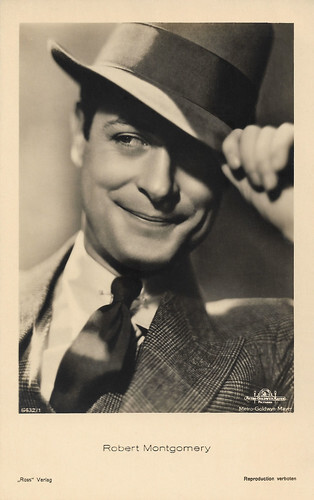
German postcard by Ross Verlag, no. 6432/1, 1931-1932. Photo: Metro-Goldwyn-Mayer.
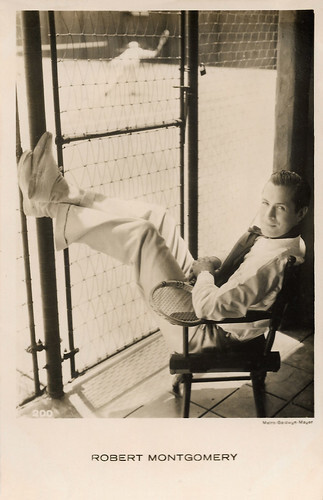
Dutch postcard, no. 200. Photo: Metro Goldwyn Mayer.
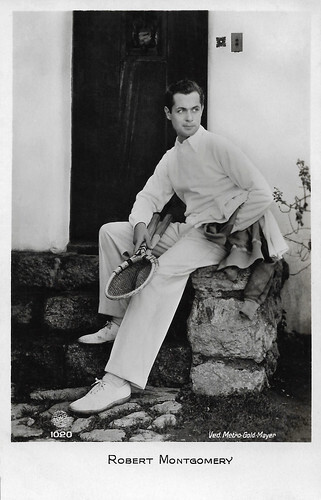
French postcard by EDUG, no. 1020. Photo: Metro Goldwyn Mayer.
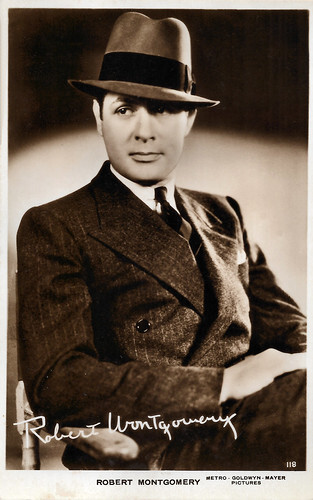
British postcard in the Film-Kurier Series, London, no. 118. Photo: Metro-Goldwyn-Mayer Pictures.
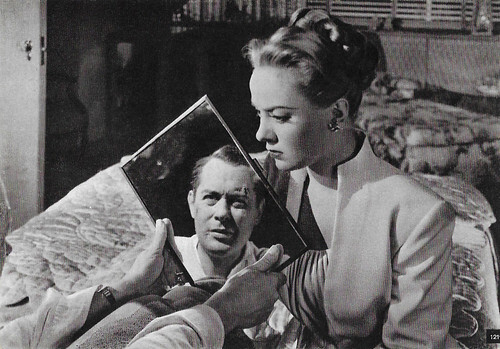
Italian postcard, no. 121. Photo: Metro Goldwyn Mayer. Audrey Totter and Robert Montgomery in The Lady in the Lake (Robert Montgomery, 1947).
Sources: Wikipedia (German, Spanish and English) and .

French postcard by Cinémagazine-Edition, Paris, no. 663. Photo: Metro-Goldwyn-Mayer. Joan Crawford and Robert Montgomery in Untamed (Jack Conway, 1929). Collection: Geoffrey Donaldson Institute.

British postcard in the Film Partners Series, London, no. P 47. Photo: Metro Goldwyn Mayer. Robert Montgomery and Joan Crawford in Our Blushing Brides (1930).

Italian postcard by Cinema-Illustrazione, Milano, Series 2, no. 3. Photo: Metro-Goldwyn-Mayer. Greta Garbo and Robert Montgomery in Inspiration (Clarence Brown, 1931).

Dutch postcard, no. 475. Photo: M.G.M. (Metro Goldwyn Mayer). Robert Montgomery and Tallulah Bankhead in Faithless (Harry Beaumont, 1932).

British postcard in the Film Partners series, London, no. P27. Robert Montgomery and Norma Shearer in Riptide (Edmund Goulding, 1934).
A screwball comedy by Alfred Hitchcock
Robert Montgomery was born Henry Montgomery Jr., in Beacon, New York, in 1904. He grew up very wealthy as the son of a New York businessman, the president of the New York Rubber Company. After his father's death, there was nothing left of the fortune for him, so he had to eke out a living with odd jobs.
He tried unsuccessfully as a writer and then also as an actor. The director George Cukor discovered him for the stage and Cukor gave him an entry to Hollywood and a contract with Metro-Goldwyn-Mayer. His first film for MGM was the comedy So This Is College (Sam Wood, 1929). He had his breakthrough as the weak-willed prisoner Kent in The Big House (George Hill, 1930).
The studio purposefully built him up as a star and Montgomery quickly played alongside established female stars. He appeared as Greta Garbo 's romantic interest in Inspiration (Clarence Brown, 1930). Norma Shearer cast him opposite her in The Divorcee (Robert Z. Leonard, 1930), Strangers May Kiss (George Fitzmaurice, 1931), and Private Lives (Sidney Franklin, 1931).
Montgomery appeared in the first filmed version of When Ladies Meet (1933), which starred Ann Harding and Myrna Loy . He made a total of six films with Joan Crawford , beginning with Untamed. In 1937, she starred opposite Marion Davies in Ever Since Eve, based on a play by the then-fashionable playwright Lawrence Riley.
He was often cast in charming and comedic roles, for example in the Alfred Hitchcock -directed screwball comedy Mr. and Mrs. Smith (1941) opposite Carole Lombard . Very successfully going against his usual type of role, he was cast as a psychopathic murderer in the thriller Night Must Fall (Richard Thorpe, 1937), for which he received the first of his two Oscar nominations. The second was for Here Comes Mr. Jordan (Alexander Hall, 1942) in which he played a boxer who is accidentally taken to heaven by an angel and reclaims his lost lifetime.

British Art Photo postcard, no. 24. Photo: Metro Goldwyn Mayer.

British postcard

British postcard by Valentine's, no. 5904O. Photo: Metro-Goldwyn-Mayer Pictures.

British postcard by De Reszke Cigarettes, no. 5. Photo: Metro-Goldwyn-Mayer (MGM).

British postcard in the Picturegoer Series, London, no. 461.
An experimental Film Noir
Robert Montgomery's association with MGM lasted 16 years, interrupted only by the Second World War. After the U.S. entered World War II in December 1941, he joined the US Navy, rising to the rank of major. After his return from active service Robert Montgomery also began to work as a director.
He made his directorial debut, but without credits, in They Were Expendable (John Ford, 1945), where he directed some of the PT Boat scenes when director John Ford was unable to work for health reasons. His best-known film as a director is The Lady in the Lake (1947), an experimental Film Noir shot entirely from the hero's perspective with a subjective camera.
Active in Republican politics and concerned about communist influence in the entertainment industry, he was a friendly witness before the Committee on Un-American Activities in 1947. Montgomery was one of the first Hollywood stars to move to television. He hosted the Emmy Award-winning television series, Robert Montgomery Presents. The series, produced between 1950 and 1957, proved very popular.
The Gallant Hours (1960), a film Montgomery directed and co-produced with its star, his friend James Cagney , was the last film or television production he worked on. Montgomery served as president of the Screen Actors Guild from 1935 to 1938 and again from 1946 to 1947. The actor was active in the Republican Party throughout his life, supporting Republican presidential candidates Thomas E. Dewey and Dwight D. Eisenhower.
During Eisenhower's presidency, he was the first official media advisor to the White House in the history of the United States. He was married to Elizabeth Bryan Allen from 1928 until their divorce in 1950, and to Elizabeth Grant Harkness from 1950 until his death. Their children were actress Elizabeth Montgomery, best known for her 1960s television series, Bewitched, and Robert Montgomery Jr. Robert Montgomery died of cancer in New York in 1981 at the age of 77.

Italian postcard, no. 1222. Photo: Metro Goldwyn Mayer. Robert Montgomery and Audrey Totter in The Lady in the Lake (Robert Montgomery, 1947).

German postcard by Ross Verlag, no. 6432/1, 1931-1932. Photo: Metro-Goldwyn-Mayer.

Dutch postcard, no. 200. Photo: Metro Goldwyn Mayer.

French postcard by EDUG, no. 1020. Photo: Metro Goldwyn Mayer.

British postcard in the Film-Kurier Series, London, no. 118. Photo: Metro-Goldwyn-Mayer Pictures.

Italian postcard, no. 121. Photo: Metro Goldwyn Mayer. Audrey Totter and Robert Montgomery in The Lady in the Lake (Robert Montgomery, 1947).
Sources: Wikipedia (German, Spanish and English) and .
Published on November 11, 2023 22:00
November 10, 2023
Photo by Witzel
Today, we're at the Verzamelaarsjaarbeurs in Utrecht and will meet Marlene Pilaete there for drinks and stories. For the occasion, this EFSP post contains film star postcards from all our collections featuring vibrant, elegant portrait photographs by American photographer Albert Witzel. Marlene shared a text she once wrote in her wonderful blog La Collectionneuse at the now-defunct website L’Encinémathèque. Albert Witzel was a pioneer and prominent portrait photographer of Los Angeles. He was born in 1871 and died in 1929 after a long illness. The rise of his studio paralleled the emergence of the film industry following its relocation from the East Coast. Witzel made portraits of many of Los Angeles' leading figures, including such film icons as Charlie Chaplin, Harold Lloyd and Theda Bara.
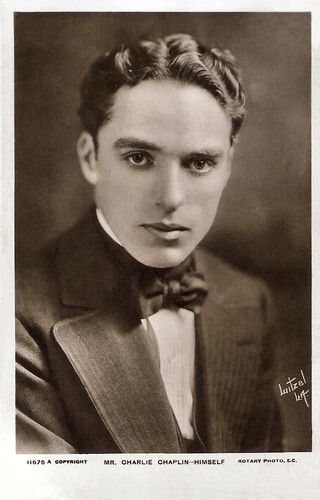
British postcard by Rotary, no 11675 A. Photo: Witzel.
In 1914, English comedian Charles ‘Charlie’ Chaplin (1889-1977) invented his classic character the Tramp! With his toothbrush moustache, undersized bowler hat and bamboo cane, the tramp struggled to survive while keeping his dignity in a world with great social injustice. Chaplin was one of the most creative and influential personalities of the silent film era. He used mime, slapstick and other visual comedy routines, and he not only starred in his films, but also directed, wrote and produced them, and composed the music as well.

Austrian postcard by Iris Verlag, Wien, no. 404. Photo: Witzel L.A. / Fox Film.
Blond Florence Gilbert (1904-1991) was an American silent film actress of the 1920s. She was renowned for playing supporting roles alongside such actors as William Fairbanks and Jack Hoxie.
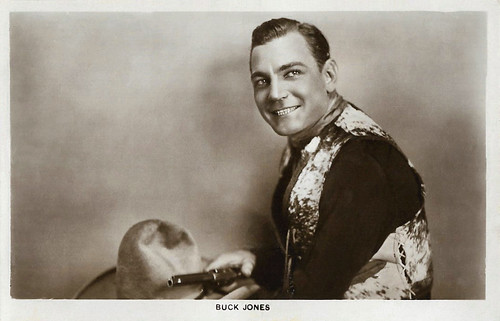
British postcard in the Picturegoer Series, London, no. 146a. Photo: Albert Witzel, Hollywood.
American film star Buck Jones (1891–1942) starred in many popular B-Westerns of the 1920s, 1930s, and 1940s. Executive William Fox decided to use him as a backup to Tom Mix. This led to his first starring role, The Last Straw (Denison Clift, Charles Swickard, 1920). With his famed horse Silver, Jones would make more than 160 films.
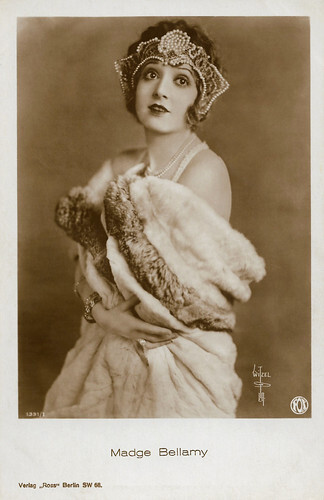
German postcard by Ross Verlag, no. 1331/1, 1927-1928. Photo: Witzel / Fox.
Madge Bellamy (1899-1990) was a beautiful and temperamental leading lady of the silent era, known for such classics as John Ford's first Western The Iron Horse (1924). She appeared in about fifty silent films and also in a dozen sound films, including the cult favourite White Zombie (1932). By the late 1930s, her film career had virtually ended, but in 1943 she became again fodder for the press when she was arrested for shooting her former lover.
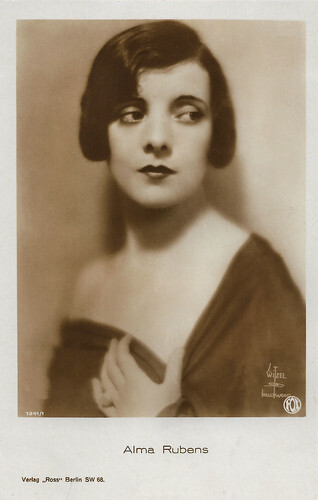
German postcard by Ross Verlag, Berlin no. 1341/1, 1927-1928. Photo: Witzel / Fox.
Alma Rubens (1897–1931) was an American film actress and stage performer. She first acted at Triangle and Cosmopolitan, where she starred in the hit Humoresque (1920), based on a Fanny Hurst story and scripted by Frances Marion. The film won a precursor of the Oscars. While at Fox, Rubens peaked in the hit melodrama East Lynne (1925) opposite Edmund Lowe and Lou Tellegen. Yet, her drug abuse ended her career. She died young of a combination of pneumonia and bronchitis.
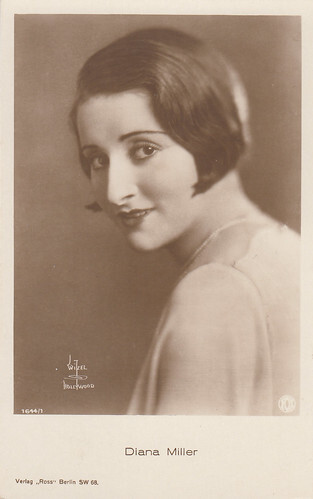
German postcard by Ross Verlag, no. 1644/1, 1927-1928. Photo: Witzel, Hollywood / Fox. Collection: Marlene Pilaete.
American actress Diana Miller (1902-1927) acted in silent motion pictures for Famous Players-Lasky and Fox. She had red hair and excelled in playing roles which required delineation of character. She was briefly married to actor William Boyd and director and producer George Melford. She suffered a breakdown about a year before her death and was treated at a sanatorium.
The first film star portrait to appear in the Los Angeles Times
Albert Walter Witzel was born in 1879 in Deadwood, South Dakota. He was the son of German immigrants August Witzel and Catherine Siefert. The family moved to Seattle in 1886 and Albert signed up as a photographer’s apprentice in 1894. Learning quickly, the young man eventually ran the studio. He moved to Los Angeles as early as 1898 and began working as a clerk in the photographic studio of Coules & Dando. In 1905, Witzel bought his employer’s studio and leased the one above it. He began by photographing society persons and their children. His brother Charles helped manage the business.
Witzel quickly established a clientele that included theatre actors. The astute businessman quickly recognised the value of celebrities to help promote his business and began reaching out to theatrical entertainers in need of carefully crafted portraits to lure customers. As David Shields points out in his book, 'Still: American Silent Motion Picture Photography,' Witzel "favored pronounced facial expressions for women. Furthermore, he had a penchant for typifying sitters into the character types of the old stock companies"'
It was only a short step from the stage to the cinema, especially if you lived in California. Hollywood was becoming the movie capital when independent film companies began moving to Los Angeles to escape the regulations from the Motion Picture Trust and the harsh weather of New York. These companies had recently introduced the practice of promoting the stars of their films, helping to create brand awareness among consumers, who flocked to movies starring their favourites. This star system became the basis for selling films to distributors and the public.
The Balboa Film Co. hired him in 1913-1914 to shoot portraits of their star stable, quickly followed by companies like Triangle-Ince. Witzel's photograph of Viola Barry from Balboa's The Sea Wolf (Hobart Bosworth, 1913) was the first film star portrait to appear in the Los Angeles Times on 21 August 1913. This was followed by a portrait of Elsie Albert as the princess in the Powers Picture Co.’s Venus Feature film, Aladdin and his Wonderful Lamp (Harry C. Mathews, 1913), in the Los Angeles Times of 27 August 1913. A Witzel portrait of actress Lois Weber from the Phillips Smalley Co. ran in September. Beginning in 1915, Witzel's work ran regularly in the Los Angeles Times.
After he made a name for himself, Witzel had a Craftsman residence built in 1914. It was designed and constructed by William Fleming in the Craftsman style with Japanese influences. The now renowned Albert W. Witzel Residence is located at 226 S. St. Andrews Place between Second and Third Streets in the Wilshire Community Plan Area. Witzel remained there until his death.
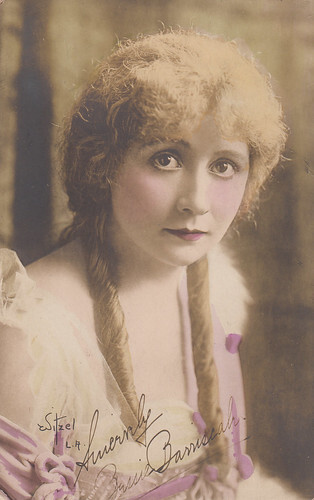
American postcard. Photo: Witzel, Los Angeles. Collection: Marlene Pilaete.
American actress Bessie Barriscale (1884-1965) was a silent film star in the 1910s. Hollywood marketed her as the "girl with the biggest eyes". Barriscale became one of the highest-paid actresses of the time.
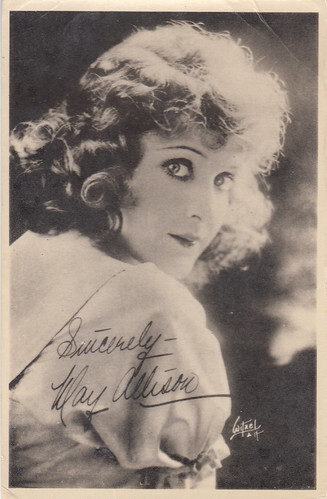
American AZO postcard. Photo: Witzel, Los Angeles. Collection: Marlene Pilaete.
May Allison (1890-1989) was an American actress whose greatest success was achieved in the early part of the 20th century in silent films, although she also appeared on stage.
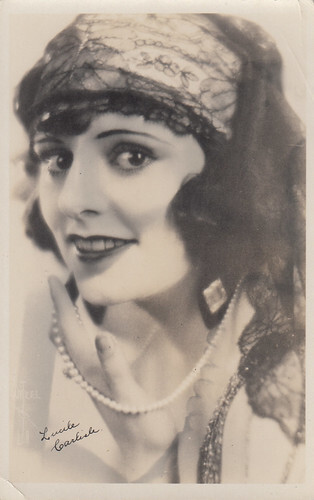
American AZO postcard. Photo: Witzel, Los Angeles. Collection: Marlene Pilaete.
American actress Lucille Carlisle (1895-1958) made silent films for Vitagraph Studios. With comedian and director Larry Semon, she made 25 films. After their professional and personal relationship ended, she also left film work.
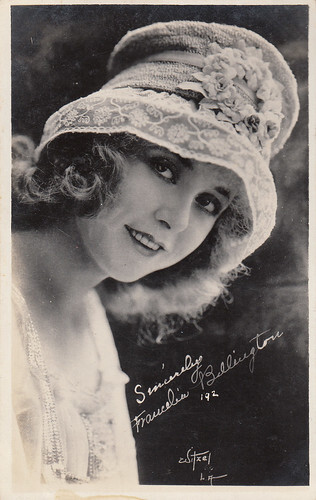
American AZO postcard, no. 192. Photo: Witzel, Los Angeles. Collection: Marlene Pilaete.
Francelia Billington (1895-1934) was an early American silent-screen actress and an accomplished camera operator.
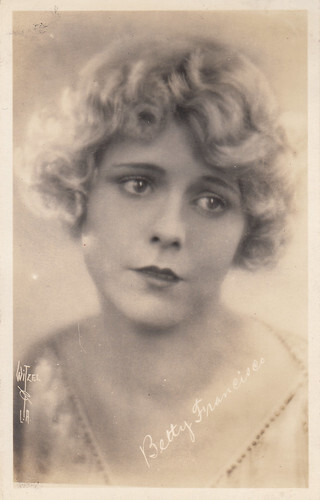
American AZO postcard. Photo: Witzel, Los Angeles. Collection: Marlene Pilaete.
Betty Francisco (19301950) was an American silent-film actress, appearing primarily in supporting roles. Her sisters Evelyn and Margaret were also actresses.
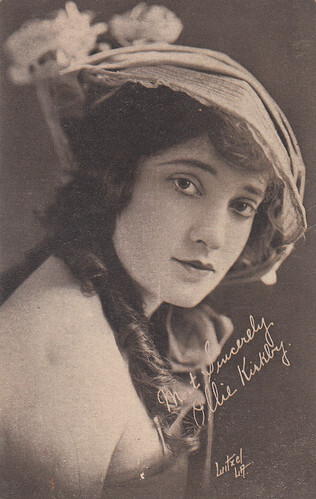
American postcard by American Publishing Co., Los Angeles, Cal., U.S.A.. Photo: Witzel, Los Angeles. Collection: Marlene Pilaete.
American actress Ollie Kirkby (1886-1964) was a brunette silent film, stage and vaudeville actress. For Kalem Kalem, she was the star of one- and two-reelers such as The Social Pirates (1916).
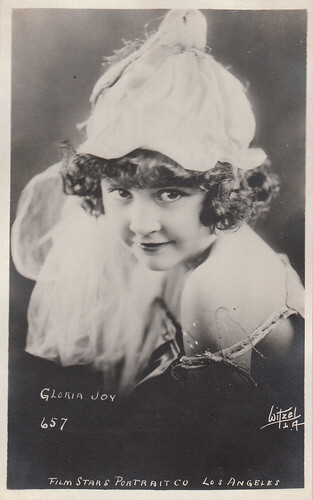
American postcard by Film Stars Portrait Co., Los Angeles, no. 657. Photo: Witzel, Los Angeles. Collection: Marlene Pilaete.
American actress Gloria Joy (1910-1970) began her career in the film industry at age seven when her stepfather, Sherwood MacDonald, formed Mission Productions in the autumn of 1918 to produce a series of films showcasing Joy as a child actress. She starred in such films as The Midnight Burglar (1918) and The Locked Heart (1918). As a young adult, she continued her career with such silent films as Phantom Police (1926).
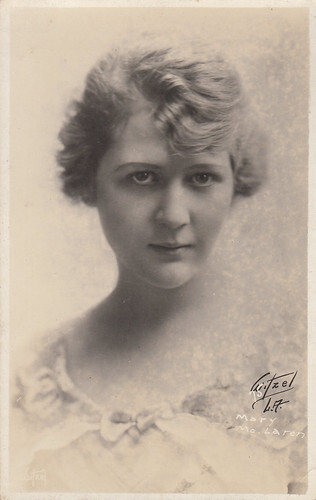
American AZO postcard, no. 75. Photo: Witzel, Los Angeles. Collection: Marlene Pilaete.
Blonde and blue-eyed Mary MacLaren (1896–1985) was an American silent film actress. She was the younger sister of actress and film producer Katherine MacDonald. Discovered by director Lois Weber and her husband, producer Phillips Smalley, Mary was launched in the lead of Shoes (Lois Weber, 1916). Among her other Universal films were three directed by Tod Browning, including Bonnie, Bonnie Lassie (1919). After about twenty films, MacLaren left Universal in 1921 and successfully performed in ten more films, including The Wild Goose (1921).
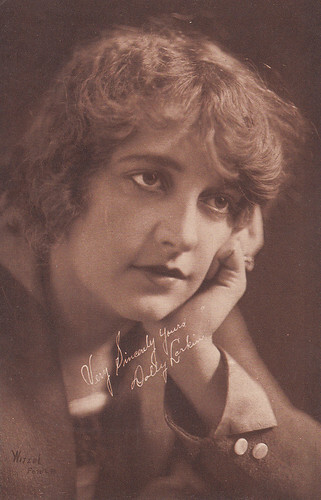
American postcard by Maurer, Schultz & Co Publishers, Los Angeles, Cal., U.S.A. Photo: Witzel, Los Angeles. Collection: Marlene Pilaete.
American actress Dolly Larkin (1889-1976) was known for such silent films as Black Beauty (1913), The Broken Barrier (1914), and The Labyrinth (1915). She was married to George Larkin.
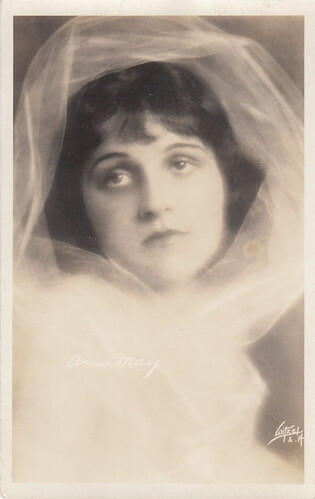
American AZO postcard, no 10. Photo: Witzel, Los Angeles. Collection: Marlene Pilaete.
American silent film actress Ann May (1898-1985) appeared in motion pictures from 1919 to 1925. She had her breakthrough as the leading lady opposite Charles Ray in Paris Green (1920). As an actress, she was diverse enough to play a daring rider or a delicate society girl from the East. In 1925, she married the screenwriter and producer C. Gardner Sullivan.
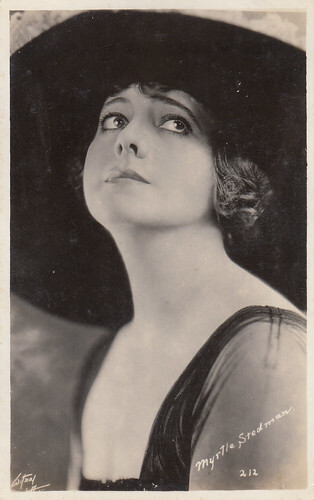
American postcard, no. 212. Photo: Witzel, Los Angeles. Collection: Marlene Pilaete.
American actress Myrtle Stedman (1883-1938) started her film career in 1910 at the Selig studio in Western and action short films. She was the only female member of Selig at that time, making her the female lead in all of that studio's Westerns. After Selig, Stedman joined the Hobart Bosworth Productions Company and she also worked for Metro-Goldwyn-Mayer and Famous Players–Lasky studios. She retired in 1931.
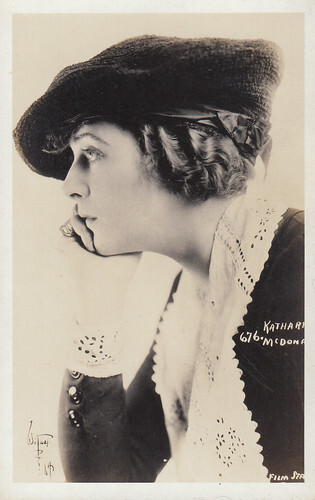
American AZO postcard, no. 676. Photo: Witzel, Hollywood. Collection: Marlene Pilaete.
Katherine MacDonald (1891-1956) was an American stage and film actress, film producer, and model. She was the older sister of actresses Miriam MacDonald and Mary MacLaren. Katherine started her career as a popular model in New York City in the 1910s. MacDonald moved to Los Angeles in 1917 and her first significant role was in Shark Monroe (1918) opposite William S. Hart. She also became one of the first women to produce films in Hollywood and from 1919 to 1921, she produced nine features for her company, Katherine MacDonald Pictures. MacDonald earned about $50,000 per picture from a contract with First National. From 1922 to 1925 she appeared in films produced by B. P. Schulberg. Her films typically were romantic dramas. MacDonald made only two pictures after 1923, one each in 1925 and 1926.
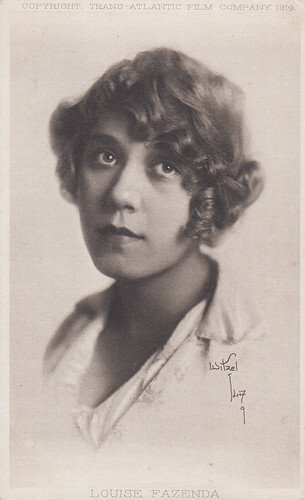
British postcard by Trans-Atlantic Film Company, 1914. Photo: Witzel, Hollywood. Collection: Marlene Pilaete.
Louise Fazenda (1895-1962) was a gawky, highly popular funny girl in slapstick comedies for Keystone Studios. She paired up well with comedian Charlie Murray. Her best-known character was her country bumpkin - complete with spit curls, multiple pigtails, and calico dresses. In the early 1920s, Louise left Sennett's company and progressed to feature films, where her eccentric talents were greatly utilised in musicals and knockabout comedies.
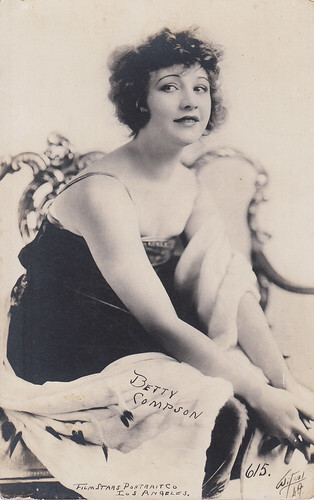
American postcard by Film Stars Portrait Co., Los Angeles, no. 6/5. Photo: Witzel, Hollywood. Collection: Marlene Pilaete.
Blond, blue-eyed Betty Compson (1897–1974) was an American actress and film producer. She peaked in silent cinema and early talkies and is best known for her performances as a suicidal prostitute rescued by a stoker (George Bancroft) in The Docks of New York (Joseph Von Sternberg, 1928), and as the manipulative carnival girl Carrie in the part-talkie The Barker (George Fitzmaurice, 1928), the latter earning a nomination for the Academy Award for Best Actress.
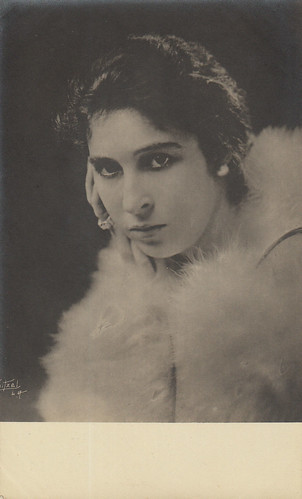
Vintage postcard. Photo: Witzel, Los Angeles. Collection: Marlene Pilaete.
American actress Edith Storey (1892-1967) was a silent film star who was an unusual combination of an intelligent actress and an outdoor athlete. She often appeared in Westerns, period dramas and adventure films. For a long time, she worked for Vitagraph and in 1918, she became one of the stars of Metro.
Rembrandt lighting and moody shadows
Distinguished by Rembrandt lighting and moody shadows, and by dramatic poses and settings, Albert Witzel’s photos set the tone for Hollywood studio photography. Witzel expanded his work with studios, occasionally shooting freelance images of Sennett bathing beauties in 1916 that were published in magazines and newspapers, and working on an assignment for Fox Studios in 1917, photographing Theda Bara in a series of somewhat soft pictorialist images for some of her best-known films, Cleopatra (J. Gordon Edwards, 1917), Madame du Barry (J. Gordon Edwards, 1917) and Salome (J. Gordon Edwards, 1918).
Film star photographs quickly became a regular part of film coverage by newspapers and magazines. Witzel made portraits of such silent film stars as Lilian Gish , Bessie Love , Theda Bara , Clara Bow , Bebe Daniels , and Charlie Chaplin . For the record, it was during a posing session in a Witzel studio that Harold Lloyd lost two of his fingers in 1919. Somehow, it was decided that Lloyd would pose with prop bombs, and pretend to light some. Unbeknownst to everyone, a real bomb created for action shoots had been thrown in the prop bomb box at the studio after a special practice that week. Through the late 1910s and 1920s Witzel's portraits featured frequently in fan magazines like The Moving Picture World, Photoplay and Motion Picture, becoming an important promotional and publicity tool.
His business flourished and Witzel opened a second studio downtown and a third at Hollywood Boulevard and Vine Street. To maintain the high quality and output required for his film work, Witzel hired Henry Nealson Smith as his laboratory manager to supervise the retouching, developing, and finishing of photographic prints. Charlie Chaplin helped finance a popular restaurant called Henry’s across the street from Witzel’s Hollywood studio and the two became acquainted. Witzel went on to have many photo shoots with the star. Photographers he hired to help him were Walter Frederick Seely and later Max Munn Autrey . Autrey eventually became head of Witzel’s Hollywood Studio at 6324 Hollywood Blvd. from 1922 to 1924. Their work became more intense and exotic, emphasizing a glamorous star look.
From the mid-1920s onwards, film companies began to set up their own photographic studios, rather than continuing to use freelance photographers. Max Munn Autrey departed to found Fox’s portrait department. Witzel did not disappear from the scene, however, and, having established his reputation, continued to practise his craft. Witzel focused more on special shoots for newspapers and magazines, like the Peggy Hamilton fashion features for the Los Angeles Times, and other select sections. His portrait photos were used for many postcards. He signed his portraits by Witzel in holograph white pencil.
After a long illness, Albert Witzel died in 1929 of tuberculosis at age 49 in Banning, California. His brother Charles shut down all the studios except the 7th Street location, which he continued to run. Turning his back on Hollywood glamour, Charles Witzel focused the business on portraiture for high school graduations, special gatherings, businesses and upper-middle-class families. The studio eventually moved to 716 S. Bonne Brae St. and remained in operation through 1952. Albert Witzel is interred at Inglewood Park Cemetery.
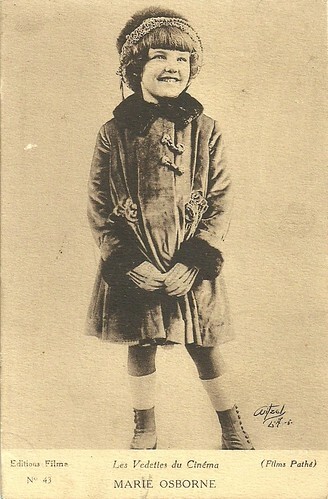
French postcard in the Les Vedettes du Cinéma series by Editions Filma, no. 43. Photo: Witzel / Films Pathé.
Marie Osborne Yeats aka Baby Marie Osborne (1911-2010) was the first major child star of American silent films.
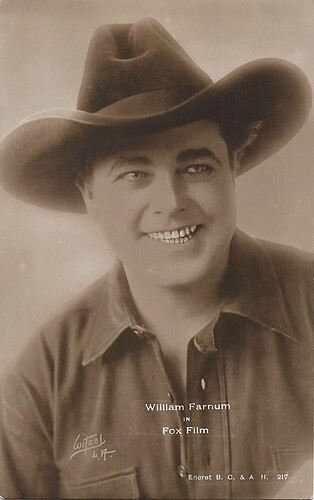
Danish postcard by Eneret B.C. & A.H., no. 217. Photo: Witzel, Los Angeles / Fox Film.
American actor William Farnum (1876-1953) was one of the first major film stars. From 1914 to 1925, Farnum was one of the biggest sensations in Hollywood, earning $10,000 a week. Farnum's silent pictures include the Westerns The Spoilers (1914) - which culminates in a spectacular saloon fistfight, Drag Harlan (1920), and the drama-adventure If I Were King (1921).

American Arcade card. Photo: Witzel, L.A. Conway Tearle in Marooned Hearts (George Archainbaud, 1920).
Conway Tearle (1878-1938) was an American stage actor who became famous as Ben Hur in several stage productions. He went on to perform in silent and early sound films. His first film was The Nightingale (1914) and his last was a film adaptation of Shakespeare's Romeo and Juliet (1936). He was often cast as the dashing hero or ardent lover. Tearle appeared in some 93 films over his career and at the end of the 1910s and early 1920s, he was at times one of the highest-paid leading men in Hollywood.
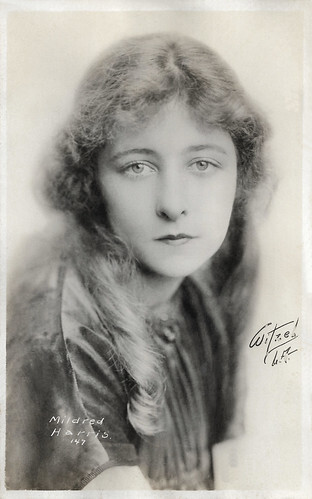
American postcard, no. 147. Photo: Witzel, L.A.
American film actress Mildred Harris (1901-1944) began her career in the film industry as a child actress when she was 11 years old. She was also the first wife of Charlie Chaplin.
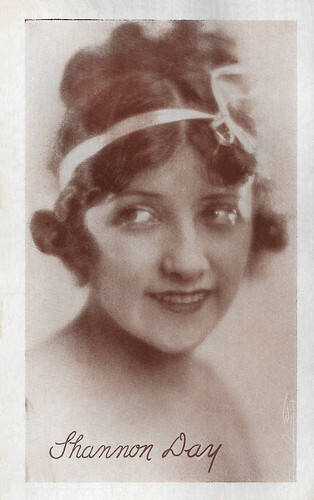
American arcade postcard. Photo: Witzel, L.A.
Shannon Day (1896-1977) was an American silent film actress with blue eyes and reddish brown hair who appeared in supporting parts in numerous productions. Before her film debut, she was a Ziegfeld Girl.
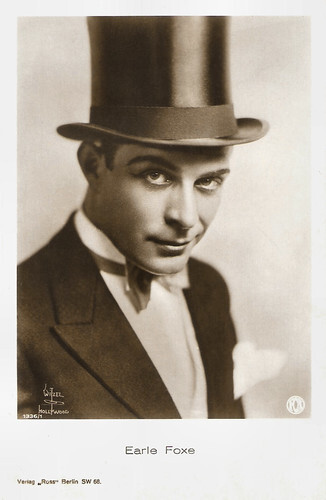
German postcard by Ross Verlag, no. 1336/1, 1927-1928. Photo: Witzel, Hollywood / Fox.
American actor Earle Foxe (1891-1973) starred in 148 films between 1912 and 1946. He went to New York as a young man and became a successful stage star. In 1922, he moved to Hollywood and was one of the attractive and wicked screen gigolos of the 1920s.
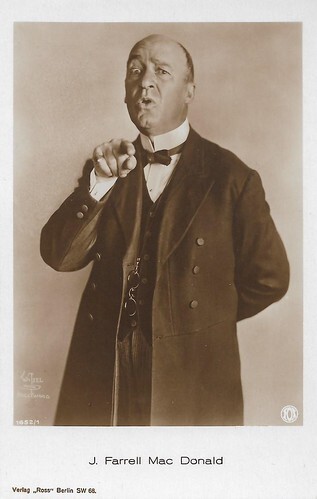
German postcard by Ross Verlag, Berlin, no. 1652/1, 1927-1928. Photo: Witzel, Hollywood / Fox.
J. Farrell MacDonald (1875-1952) was an American film and theatre actor and silent film director. Between 1911 and 1951, the character actor appeared in some 325 films, including 25 productions directed by John Ford. MacDonald also directed over 50 silent films between 1912 and 1917.
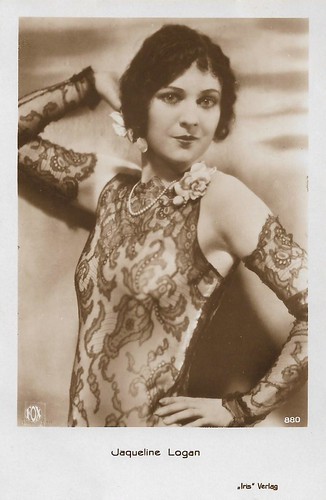
Austrian postcard by Iris Verlag, no. 880. Photo: Albert Witzel / Fox.
Jacqueline Logan (1901-1983) was an American actress of the silent screen. Her most famous part is that of Mary Magdalene in The King of Kings (1927) by Cecil B. DeMille.
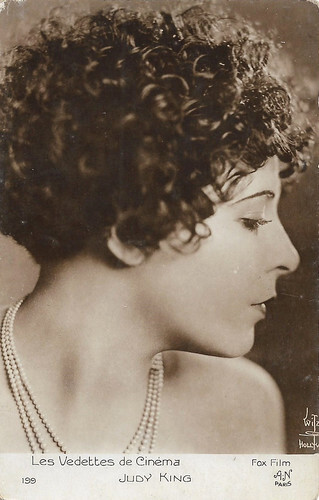
French postcard in the Les vedettes de cinéma series by A.N., Paris., no. 199. Photo: Witzel, Hollywood / Fox Film.
Judy King (1901-1987) was an American actress in the silent film, known for She Wolves (1925), The Gay Retreat (1927) and John Ford's Upstream (1927). She was married to director Tim Whelan.
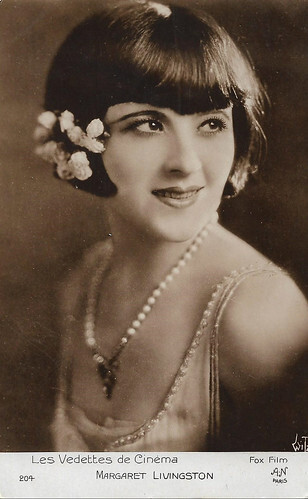
French postcard in the Les vedettes de Cinéma series by A.N., Paris, no. 204. Photo: Witzel / Fox Film.
Margaret Livingston (1895–1984) was an American film actress and businesswoman, most notable for her work during the silent film era. She remains best known today as 'the Woman from the City' in F.W. Murnau's masterpiece Sunrise: A Song of Two Humans (1927).
Sources: Marlene Pilaete (La Collectionneuse, for L’Encinémathèque, now defunct), David Shields (Still), Mary Mallory (The Daily Mirror), National Portrait Gallery, Wikitree, Biblio, Los Angeles Department of City Planning, Wikipedia (French) and IMDb.

British postcard by Rotary, no 11675 A. Photo: Witzel.
In 1914, English comedian Charles ‘Charlie’ Chaplin (1889-1977) invented his classic character the Tramp! With his toothbrush moustache, undersized bowler hat and bamboo cane, the tramp struggled to survive while keeping his dignity in a world with great social injustice. Chaplin was one of the most creative and influential personalities of the silent film era. He used mime, slapstick and other visual comedy routines, and he not only starred in his films, but also directed, wrote and produced them, and composed the music as well.

Austrian postcard by Iris Verlag, Wien, no. 404. Photo: Witzel L.A. / Fox Film.
Blond Florence Gilbert (1904-1991) was an American silent film actress of the 1920s. She was renowned for playing supporting roles alongside such actors as William Fairbanks and Jack Hoxie.

British postcard in the Picturegoer Series, London, no. 146a. Photo: Albert Witzel, Hollywood.
American film star Buck Jones (1891–1942) starred in many popular B-Westerns of the 1920s, 1930s, and 1940s. Executive William Fox decided to use him as a backup to Tom Mix. This led to his first starring role, The Last Straw (Denison Clift, Charles Swickard, 1920). With his famed horse Silver, Jones would make more than 160 films.

German postcard by Ross Verlag, no. 1331/1, 1927-1928. Photo: Witzel / Fox.
Madge Bellamy (1899-1990) was a beautiful and temperamental leading lady of the silent era, known for such classics as John Ford's first Western The Iron Horse (1924). She appeared in about fifty silent films and also in a dozen sound films, including the cult favourite White Zombie (1932). By the late 1930s, her film career had virtually ended, but in 1943 she became again fodder for the press when she was arrested for shooting her former lover.

German postcard by Ross Verlag, Berlin no. 1341/1, 1927-1928. Photo: Witzel / Fox.
Alma Rubens (1897–1931) was an American film actress and stage performer. She first acted at Triangle and Cosmopolitan, where she starred in the hit Humoresque (1920), based on a Fanny Hurst story and scripted by Frances Marion. The film won a precursor of the Oscars. While at Fox, Rubens peaked in the hit melodrama East Lynne (1925) opposite Edmund Lowe and Lou Tellegen. Yet, her drug abuse ended her career. She died young of a combination of pneumonia and bronchitis.

German postcard by Ross Verlag, no. 1644/1, 1927-1928. Photo: Witzel, Hollywood / Fox. Collection: Marlene Pilaete.
American actress Diana Miller (1902-1927) acted in silent motion pictures for Famous Players-Lasky and Fox. She had red hair and excelled in playing roles which required delineation of character. She was briefly married to actor William Boyd and director and producer George Melford. She suffered a breakdown about a year before her death and was treated at a sanatorium.
The first film star portrait to appear in the Los Angeles Times
Albert Walter Witzel was born in 1879 in Deadwood, South Dakota. He was the son of German immigrants August Witzel and Catherine Siefert. The family moved to Seattle in 1886 and Albert signed up as a photographer’s apprentice in 1894. Learning quickly, the young man eventually ran the studio. He moved to Los Angeles as early as 1898 and began working as a clerk in the photographic studio of Coules & Dando. In 1905, Witzel bought his employer’s studio and leased the one above it. He began by photographing society persons and their children. His brother Charles helped manage the business.
Witzel quickly established a clientele that included theatre actors. The astute businessman quickly recognised the value of celebrities to help promote his business and began reaching out to theatrical entertainers in need of carefully crafted portraits to lure customers. As David Shields points out in his book, 'Still: American Silent Motion Picture Photography,' Witzel "favored pronounced facial expressions for women. Furthermore, he had a penchant for typifying sitters into the character types of the old stock companies"'
It was only a short step from the stage to the cinema, especially if you lived in California. Hollywood was becoming the movie capital when independent film companies began moving to Los Angeles to escape the regulations from the Motion Picture Trust and the harsh weather of New York. These companies had recently introduced the practice of promoting the stars of their films, helping to create brand awareness among consumers, who flocked to movies starring their favourites. This star system became the basis for selling films to distributors and the public.
The Balboa Film Co. hired him in 1913-1914 to shoot portraits of their star stable, quickly followed by companies like Triangle-Ince. Witzel's photograph of Viola Barry from Balboa's The Sea Wolf (Hobart Bosworth, 1913) was the first film star portrait to appear in the Los Angeles Times on 21 August 1913. This was followed by a portrait of Elsie Albert as the princess in the Powers Picture Co.’s Venus Feature film, Aladdin and his Wonderful Lamp (Harry C. Mathews, 1913), in the Los Angeles Times of 27 August 1913. A Witzel portrait of actress Lois Weber from the Phillips Smalley Co. ran in September. Beginning in 1915, Witzel's work ran regularly in the Los Angeles Times.
After he made a name for himself, Witzel had a Craftsman residence built in 1914. It was designed and constructed by William Fleming in the Craftsman style with Japanese influences. The now renowned Albert W. Witzel Residence is located at 226 S. St. Andrews Place between Second and Third Streets in the Wilshire Community Plan Area. Witzel remained there until his death.

American postcard. Photo: Witzel, Los Angeles. Collection: Marlene Pilaete.
American actress Bessie Barriscale (1884-1965) was a silent film star in the 1910s. Hollywood marketed her as the "girl with the biggest eyes". Barriscale became one of the highest-paid actresses of the time.

American AZO postcard. Photo: Witzel, Los Angeles. Collection: Marlene Pilaete.
May Allison (1890-1989) was an American actress whose greatest success was achieved in the early part of the 20th century in silent films, although she also appeared on stage.

American AZO postcard. Photo: Witzel, Los Angeles. Collection: Marlene Pilaete.
American actress Lucille Carlisle (1895-1958) made silent films for Vitagraph Studios. With comedian and director Larry Semon, she made 25 films. After their professional and personal relationship ended, she also left film work.

American AZO postcard, no. 192. Photo: Witzel, Los Angeles. Collection: Marlene Pilaete.
Francelia Billington (1895-1934) was an early American silent-screen actress and an accomplished camera operator.

American AZO postcard. Photo: Witzel, Los Angeles. Collection: Marlene Pilaete.
Betty Francisco (19301950) was an American silent-film actress, appearing primarily in supporting roles. Her sisters Evelyn and Margaret were also actresses.

American postcard by American Publishing Co., Los Angeles, Cal., U.S.A.. Photo: Witzel, Los Angeles. Collection: Marlene Pilaete.
American actress Ollie Kirkby (1886-1964) was a brunette silent film, stage and vaudeville actress. For Kalem Kalem, she was the star of one- and two-reelers such as The Social Pirates (1916).

American postcard by Film Stars Portrait Co., Los Angeles, no. 657. Photo: Witzel, Los Angeles. Collection: Marlene Pilaete.
American actress Gloria Joy (1910-1970) began her career in the film industry at age seven when her stepfather, Sherwood MacDonald, formed Mission Productions in the autumn of 1918 to produce a series of films showcasing Joy as a child actress. She starred in such films as The Midnight Burglar (1918) and The Locked Heart (1918). As a young adult, she continued her career with such silent films as Phantom Police (1926).

American AZO postcard, no. 75. Photo: Witzel, Los Angeles. Collection: Marlene Pilaete.
Blonde and blue-eyed Mary MacLaren (1896–1985) was an American silent film actress. She was the younger sister of actress and film producer Katherine MacDonald. Discovered by director Lois Weber and her husband, producer Phillips Smalley, Mary was launched in the lead of Shoes (Lois Weber, 1916). Among her other Universal films were three directed by Tod Browning, including Bonnie, Bonnie Lassie (1919). After about twenty films, MacLaren left Universal in 1921 and successfully performed in ten more films, including The Wild Goose (1921).

American postcard by Maurer, Schultz & Co Publishers, Los Angeles, Cal., U.S.A. Photo: Witzel, Los Angeles. Collection: Marlene Pilaete.
American actress Dolly Larkin (1889-1976) was known for such silent films as Black Beauty (1913), The Broken Barrier (1914), and The Labyrinth (1915). She was married to George Larkin.

American AZO postcard, no 10. Photo: Witzel, Los Angeles. Collection: Marlene Pilaete.
American silent film actress Ann May (1898-1985) appeared in motion pictures from 1919 to 1925. She had her breakthrough as the leading lady opposite Charles Ray in Paris Green (1920). As an actress, she was diverse enough to play a daring rider or a delicate society girl from the East. In 1925, she married the screenwriter and producer C. Gardner Sullivan.

American postcard, no. 212. Photo: Witzel, Los Angeles. Collection: Marlene Pilaete.
American actress Myrtle Stedman (1883-1938) started her film career in 1910 at the Selig studio in Western and action short films. She was the only female member of Selig at that time, making her the female lead in all of that studio's Westerns. After Selig, Stedman joined the Hobart Bosworth Productions Company and she also worked for Metro-Goldwyn-Mayer and Famous Players–Lasky studios. She retired in 1931.

American AZO postcard, no. 676. Photo: Witzel, Hollywood. Collection: Marlene Pilaete.
Katherine MacDonald (1891-1956) was an American stage and film actress, film producer, and model. She was the older sister of actresses Miriam MacDonald and Mary MacLaren. Katherine started her career as a popular model in New York City in the 1910s. MacDonald moved to Los Angeles in 1917 and her first significant role was in Shark Monroe (1918) opposite William S. Hart. She also became one of the first women to produce films in Hollywood and from 1919 to 1921, she produced nine features for her company, Katherine MacDonald Pictures. MacDonald earned about $50,000 per picture from a contract with First National. From 1922 to 1925 she appeared in films produced by B. P. Schulberg. Her films typically were romantic dramas. MacDonald made only two pictures after 1923, one each in 1925 and 1926.

British postcard by Trans-Atlantic Film Company, 1914. Photo: Witzel, Hollywood. Collection: Marlene Pilaete.
Louise Fazenda (1895-1962) was a gawky, highly popular funny girl in slapstick comedies for Keystone Studios. She paired up well with comedian Charlie Murray. Her best-known character was her country bumpkin - complete with spit curls, multiple pigtails, and calico dresses. In the early 1920s, Louise left Sennett's company and progressed to feature films, where her eccentric talents were greatly utilised in musicals and knockabout comedies.

American postcard by Film Stars Portrait Co., Los Angeles, no. 6/5. Photo: Witzel, Hollywood. Collection: Marlene Pilaete.
Blond, blue-eyed Betty Compson (1897–1974) was an American actress and film producer. She peaked in silent cinema and early talkies and is best known for her performances as a suicidal prostitute rescued by a stoker (George Bancroft) in The Docks of New York (Joseph Von Sternberg, 1928), and as the manipulative carnival girl Carrie in the part-talkie The Barker (George Fitzmaurice, 1928), the latter earning a nomination for the Academy Award for Best Actress.

Vintage postcard. Photo: Witzel, Los Angeles. Collection: Marlene Pilaete.
American actress Edith Storey (1892-1967) was a silent film star who was an unusual combination of an intelligent actress and an outdoor athlete. She often appeared in Westerns, period dramas and adventure films. For a long time, she worked for Vitagraph and in 1918, she became one of the stars of Metro.
Rembrandt lighting and moody shadows
Distinguished by Rembrandt lighting and moody shadows, and by dramatic poses and settings, Albert Witzel’s photos set the tone for Hollywood studio photography. Witzel expanded his work with studios, occasionally shooting freelance images of Sennett bathing beauties in 1916 that were published in magazines and newspapers, and working on an assignment for Fox Studios in 1917, photographing Theda Bara in a series of somewhat soft pictorialist images for some of her best-known films, Cleopatra (J. Gordon Edwards, 1917), Madame du Barry (J. Gordon Edwards, 1917) and Salome (J. Gordon Edwards, 1918).
Film star photographs quickly became a regular part of film coverage by newspapers and magazines. Witzel made portraits of such silent film stars as Lilian Gish , Bessie Love , Theda Bara , Clara Bow , Bebe Daniels , and Charlie Chaplin . For the record, it was during a posing session in a Witzel studio that Harold Lloyd lost two of his fingers in 1919. Somehow, it was decided that Lloyd would pose with prop bombs, and pretend to light some. Unbeknownst to everyone, a real bomb created for action shoots had been thrown in the prop bomb box at the studio after a special practice that week. Through the late 1910s and 1920s Witzel's portraits featured frequently in fan magazines like The Moving Picture World, Photoplay and Motion Picture, becoming an important promotional and publicity tool.
His business flourished and Witzel opened a second studio downtown and a third at Hollywood Boulevard and Vine Street. To maintain the high quality and output required for his film work, Witzel hired Henry Nealson Smith as his laboratory manager to supervise the retouching, developing, and finishing of photographic prints. Charlie Chaplin helped finance a popular restaurant called Henry’s across the street from Witzel’s Hollywood studio and the two became acquainted. Witzel went on to have many photo shoots with the star. Photographers he hired to help him were Walter Frederick Seely and later Max Munn Autrey . Autrey eventually became head of Witzel’s Hollywood Studio at 6324 Hollywood Blvd. from 1922 to 1924. Their work became more intense and exotic, emphasizing a glamorous star look.
From the mid-1920s onwards, film companies began to set up their own photographic studios, rather than continuing to use freelance photographers. Max Munn Autrey departed to found Fox’s portrait department. Witzel did not disappear from the scene, however, and, having established his reputation, continued to practise his craft. Witzel focused more on special shoots for newspapers and magazines, like the Peggy Hamilton fashion features for the Los Angeles Times, and other select sections. His portrait photos were used for many postcards. He signed his portraits by Witzel in holograph white pencil.
After a long illness, Albert Witzel died in 1929 of tuberculosis at age 49 in Banning, California. His brother Charles shut down all the studios except the 7th Street location, which he continued to run. Turning his back on Hollywood glamour, Charles Witzel focused the business on portraiture for high school graduations, special gatherings, businesses and upper-middle-class families. The studio eventually moved to 716 S. Bonne Brae St. and remained in operation through 1952. Albert Witzel is interred at Inglewood Park Cemetery.

French postcard in the Les Vedettes du Cinéma series by Editions Filma, no. 43. Photo: Witzel / Films Pathé.
Marie Osborne Yeats aka Baby Marie Osborne (1911-2010) was the first major child star of American silent films.

Danish postcard by Eneret B.C. & A.H., no. 217. Photo: Witzel, Los Angeles / Fox Film.
American actor William Farnum (1876-1953) was one of the first major film stars. From 1914 to 1925, Farnum was one of the biggest sensations in Hollywood, earning $10,000 a week. Farnum's silent pictures include the Westerns The Spoilers (1914) - which culminates in a spectacular saloon fistfight, Drag Harlan (1920), and the drama-adventure If I Were King (1921).

American Arcade card. Photo: Witzel, L.A. Conway Tearle in Marooned Hearts (George Archainbaud, 1920).
Conway Tearle (1878-1938) was an American stage actor who became famous as Ben Hur in several stage productions. He went on to perform in silent and early sound films. His first film was The Nightingale (1914) and his last was a film adaptation of Shakespeare's Romeo and Juliet (1936). He was often cast as the dashing hero or ardent lover. Tearle appeared in some 93 films over his career and at the end of the 1910s and early 1920s, he was at times one of the highest-paid leading men in Hollywood.

American postcard, no. 147. Photo: Witzel, L.A.
American film actress Mildred Harris (1901-1944) began her career in the film industry as a child actress when she was 11 years old. She was also the first wife of Charlie Chaplin.

American arcade postcard. Photo: Witzel, L.A.
Shannon Day (1896-1977) was an American silent film actress with blue eyes and reddish brown hair who appeared in supporting parts in numerous productions. Before her film debut, she was a Ziegfeld Girl.

German postcard by Ross Verlag, no. 1336/1, 1927-1928. Photo: Witzel, Hollywood / Fox.
American actor Earle Foxe (1891-1973) starred in 148 films between 1912 and 1946. He went to New York as a young man and became a successful stage star. In 1922, he moved to Hollywood and was one of the attractive and wicked screen gigolos of the 1920s.

German postcard by Ross Verlag, Berlin, no. 1652/1, 1927-1928. Photo: Witzel, Hollywood / Fox.
J. Farrell MacDonald (1875-1952) was an American film and theatre actor and silent film director. Between 1911 and 1951, the character actor appeared in some 325 films, including 25 productions directed by John Ford. MacDonald also directed over 50 silent films between 1912 and 1917.

Austrian postcard by Iris Verlag, no. 880. Photo: Albert Witzel / Fox.
Jacqueline Logan (1901-1983) was an American actress of the silent screen. Her most famous part is that of Mary Magdalene in The King of Kings (1927) by Cecil B. DeMille.

French postcard in the Les vedettes de cinéma series by A.N., Paris., no. 199. Photo: Witzel, Hollywood / Fox Film.
Judy King (1901-1987) was an American actress in the silent film, known for She Wolves (1925), The Gay Retreat (1927) and John Ford's Upstream (1927). She was married to director Tim Whelan.

French postcard in the Les vedettes de Cinéma series by A.N., Paris, no. 204. Photo: Witzel / Fox Film.
Margaret Livingston (1895–1984) was an American film actress and businesswoman, most notable for her work during the silent film era. She remains best known today as 'the Woman from the City' in F.W. Murnau's masterpiece Sunrise: A Song of Two Humans (1927).
Sources: Marlene Pilaete (La Collectionneuse, for L’Encinémathèque, now defunct), David Shields (Still), Mary Mallory (The Daily Mirror), National Portrait Gallery, Wikitree, Biblio, Los Angeles Department of City Planning, Wikipedia (French) and IMDb.
Published on November 10, 2023 22:00
November 9, 2023
Gloria Stuart
American actress Gloria Stuart (1910-2010) played lead roles for director James Whale in The Old Dark House (1932), The Invisible Man (1933) and The Kiss Before the Mirror (1933). More than sixty years later, Stuart won a Screen Actors Guild Award and an Oscar nomination for her performance as the Old Rose in Titanic (1997).
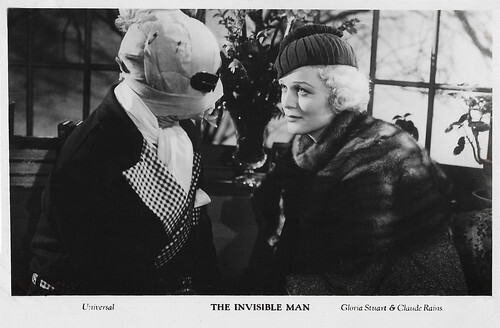
British postcard in the Filmshots series by Film Weekly. Photo: Universal. Gloria Stuart and Claude Rains in The Invisible Man (James Whale, 1933).
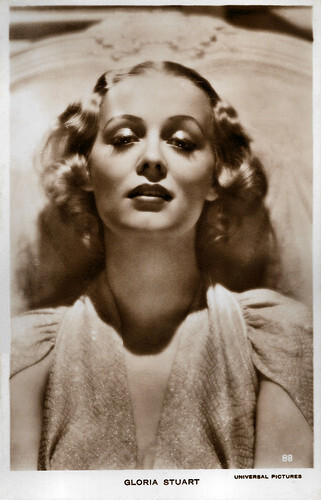
British postcard, no. 88. Photo: Universal Pictures.
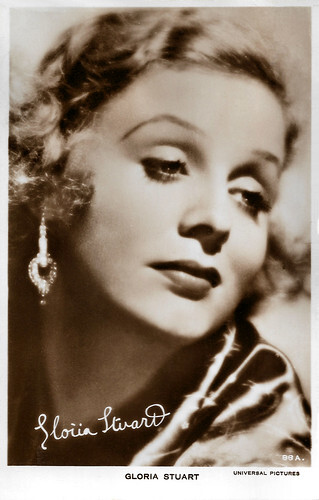
British postcard by Milton, no. 88a. Photo: Universal Pictures.
Directed by James Whale
Gloria Stuart was born Gloria Stewart on her family's dining room table on 4th Street in Santa Monica, California in 1910. She was the first child of Alice (née Deidrick) and Frank Stewart. At the time of her birth, her father was an attorney representing The Six Companies. When Stuart was nine years old, her father died as the result of an infection from an injury sustained when an automobile grazed his leg. Hard-pressed to support two small children, her mother soon accepted the proposal of local businessman Fred J. Finch.
Her early roles as a performing artist were in plays she produced in her home as a young girl. She was the star of her senior class play, 'The Swan', at Santa Monica High School in 1927. Attending the University of California, at Berkeley, she continued to perform on the stage. Stuart married Blair Gordon Newell, a young sculptor, and moved to Carmel, where she performed in a production of Anton Chekhov's 'The Seagull' which was transferred to the Pasadena Playhouse in 1932.
It was at the Opening Night there that talent scouts for both Paramount and Universal saw her. She decided to sign a contract with Universal, which paid a bit more than Paramount. After a few film appearances, Stuart was selected as one of the WAMPAS Baby Stars that year. These were new film actresses "Most Likely to Succeed". She then played lead roles for director James Whale in the horror comedy The Old Dark House (1932) with Boris Karloff , the fantasy The Invisible Man (1933) starring Claude Rains and the drama The Kiss Before the Mirror (1933) with Nancy Carroll and Paul Lukas .
In The Old Dark House (1932), she played the glamour role of a sentimental wife who winds up stranded among strangers at a spooky mansion, among the ensemble cast ( Boris Karloff , Melvyn Douglas , Charles Laughton , Lilian Bond , Ernest Thesiger, Eva Moore and Raymond Massey). The film was critically praised, and The New York Times called Stuart's performance "clever and charming," with the film later becoming a cult classic. The hard work at the studio estranged her from her first husband. Stuart later helped to create the Screen Actors Guild. Stuart was given a co-starring role by director John Ford in Air Mail (1932), playing opposite Pat O'Brien and Ralph Bellamy.
Gloria Stuart played the leading lady opposite Eddie Cantor in Roman Scandals (Frank Tuttle, 1933), on the set of which she met her second husband, screenwriter Arthur Sheekman. They married in 1934. She was dissatisfied with the roles in which she was cast at Universal and moved to 20th Century Fox. She had some success with The Gold Diggers of 1935 (Busby Berkeley, 1935) as Dick Powell 's love interest, and The Prisoner of Shark Island (John Ford, 1936), but she was not to make the leap into the front row of Hollywood stars. In June 1936, she helped Paul Muni , Franchot Tone , Ernst Lubitsch , and Oscar Hammerstein II form the Hollywood Anti-Nazi League. That same year she and writer Dorothy Parker helped create the League to Support the Spanish Civil War Orphans. A few years after having her daughter Sylvia (1935), she left the cinema and sought roles on the stage in New York.
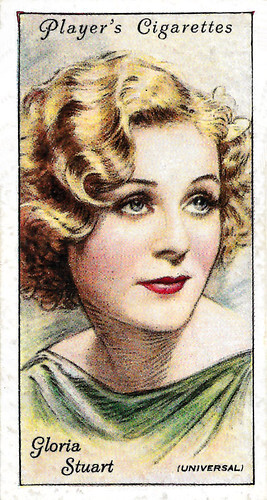
British cigarette card by Player's Cigarettes in the second Film Stars series. no. 43. Photo: Universal.
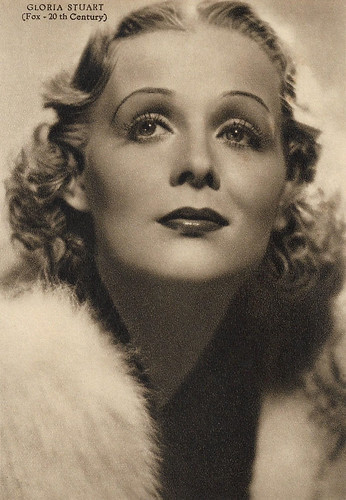
Italian postcard by Rizzoli & C., Milano, 1936. Photo: Fox - 20th Century.
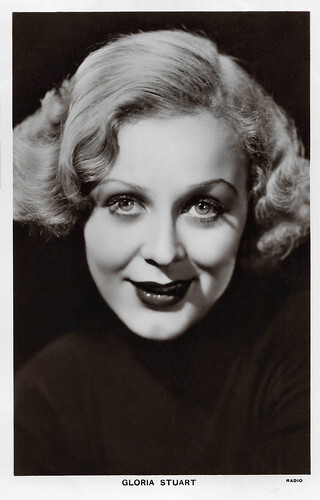
British postcard in the Picturegoer Series, London, no. 772a. Photo: Radio.
A comeback in the cinema at 87
In the 1940s, Gloria Stuart opened an art furniture shop where she created decoupage lamps, tables and trays, many of which sold to stars like Judy Garland and others. Later, Stuart took up oil painting and was very prolific, showing and selling her work in New York, Los Angeles and elsewhere. Her landscapes of The Watts Towers are on permanent collection at The Los Angeles County Museum. She also took up and mastered the art of bonsai and some of her trees are on permanent collection in the Huntington Library Japanese Garden.
When her husband fell ill in the 1970s and died in 1978, she returned to acting doing a range of television series. In 1982, she returned to the screen appearing in a brief dance scene with Peter O'Toole in My Favorite Year (Richard Benjamin, 1982). After that, Stuart was in Jack Lemmon 's drama Mass Appeal (Glenn Jordan, 1984) and Goldie Hawn's comedy Wildcats (Michael Ritchie, 1986). Stuart learned the craft of fine printing and established a printing press in her home studio called Imprenta Glorias, where she created a body of artist's books. Her book, 'Flight of Butterfly Kites' is in the permanent collection at the J. Paul Getty Museum.
At the age of 87, she made a comeback in the cinema. Gloria Stuart won a Screen Actors Guild Award and an Oscar nomination for her performance as the Old Rose, the 101-year-old survivor of shipwreck, in the epic romance Titanic (James Cameron, 1997), starring Leonardo Di Caprio and Kate Winslet . Titanic became the highest-grossing film of all time at the time.
A vintage publicity photo of her was also used for the image of 'Peg', the sister of butler Alfred Pennyworth, in Batman & Robin (Joel Schumacher, 1997). She played her last film roles in director Wim Wenders' films The Million Dollar Hotel (2000) and Land of Plenty (2004), starring Michelle Williams. In 2010, The Academy of Motion Picture Arts & Sciences honored Gloria Stuart with a Centennial Celebration. She was the first such honoree to be living for a centennial.
At 100 years of age, she had completed her greatest artist's book with her great-granddaughter working as her apprentice and also her final appearance on film in her grandson's documentary about her, entitled Secret Life of Old Rose: The Art of Gloria Stuart (Benjamin Stuart Thompson, 2012) when she died at home at the age of 100 in 2010. Stuart's great-granddaughter, Deborah B. Thompson, produced an e-book, 'Butterfly Summers: A Memoir of Gloria Stuart's Apprentice'.
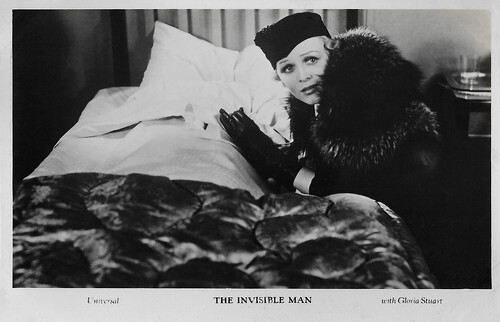
British postcard in the Filmshots series by Film Weekly. Photo: Universal. Gloria Stuart (and Claude Rains ) in The Invisible Man (James Whale, 1933).
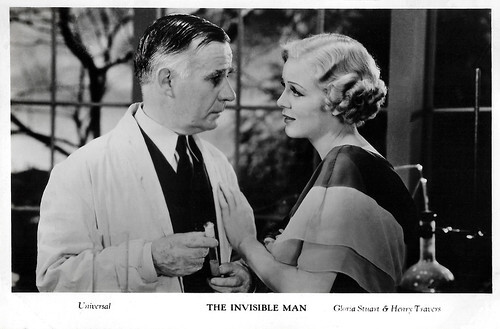
British postcard in the Filmshots series by Film Weekly. Photo: Universal. Gloria Stuart and Henry Travers in The Invisible Man (James Whale, 1933).
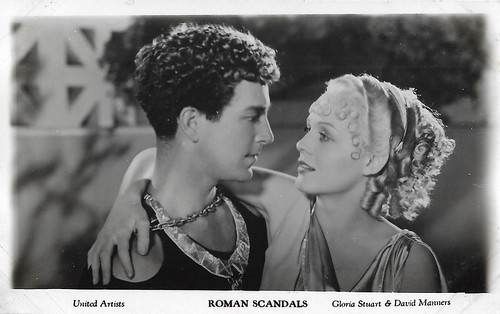
British postcard in the Filmshots series by Film Weekly. Photo: United Artists. David Manners and Gloria Stuart in Roman Scandals (Frank Tuttle, 1933).
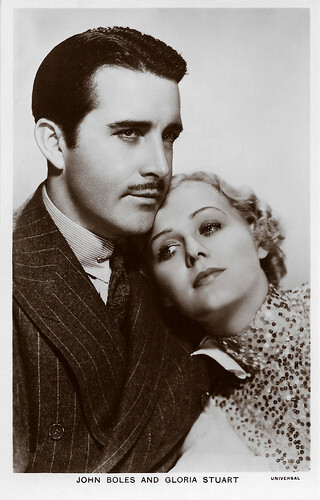
British postcard in the Film Partners Series, London, no. P 142. John Boles and Gloria Stuart in Beloved (Victor Schertzinger, 1934).
Sources: Wikipedia (Dutch, German and English) and .

British postcard in the Filmshots series by Film Weekly. Photo: Universal. Gloria Stuart and Claude Rains in The Invisible Man (James Whale, 1933).

British postcard, no. 88. Photo: Universal Pictures.

British postcard by Milton, no. 88a. Photo: Universal Pictures.
Directed by James Whale
Gloria Stuart was born Gloria Stewart on her family's dining room table on 4th Street in Santa Monica, California in 1910. She was the first child of Alice (née Deidrick) and Frank Stewart. At the time of her birth, her father was an attorney representing The Six Companies. When Stuart was nine years old, her father died as the result of an infection from an injury sustained when an automobile grazed his leg. Hard-pressed to support two small children, her mother soon accepted the proposal of local businessman Fred J. Finch.
Her early roles as a performing artist were in plays she produced in her home as a young girl. She was the star of her senior class play, 'The Swan', at Santa Monica High School in 1927. Attending the University of California, at Berkeley, she continued to perform on the stage. Stuart married Blair Gordon Newell, a young sculptor, and moved to Carmel, where she performed in a production of Anton Chekhov's 'The Seagull' which was transferred to the Pasadena Playhouse in 1932.
It was at the Opening Night there that talent scouts for both Paramount and Universal saw her. She decided to sign a contract with Universal, which paid a bit more than Paramount. After a few film appearances, Stuart was selected as one of the WAMPAS Baby Stars that year. These were new film actresses "Most Likely to Succeed". She then played lead roles for director James Whale in the horror comedy The Old Dark House (1932) with Boris Karloff , the fantasy The Invisible Man (1933) starring Claude Rains and the drama The Kiss Before the Mirror (1933) with Nancy Carroll and Paul Lukas .
In The Old Dark House (1932), she played the glamour role of a sentimental wife who winds up stranded among strangers at a spooky mansion, among the ensemble cast ( Boris Karloff , Melvyn Douglas , Charles Laughton , Lilian Bond , Ernest Thesiger, Eva Moore and Raymond Massey). The film was critically praised, and The New York Times called Stuart's performance "clever and charming," with the film later becoming a cult classic. The hard work at the studio estranged her from her first husband. Stuart later helped to create the Screen Actors Guild. Stuart was given a co-starring role by director John Ford in Air Mail (1932), playing opposite Pat O'Brien and Ralph Bellamy.
Gloria Stuart played the leading lady opposite Eddie Cantor in Roman Scandals (Frank Tuttle, 1933), on the set of which she met her second husband, screenwriter Arthur Sheekman. They married in 1934. She was dissatisfied with the roles in which she was cast at Universal and moved to 20th Century Fox. She had some success with The Gold Diggers of 1935 (Busby Berkeley, 1935) as Dick Powell 's love interest, and The Prisoner of Shark Island (John Ford, 1936), but she was not to make the leap into the front row of Hollywood stars. In June 1936, she helped Paul Muni , Franchot Tone , Ernst Lubitsch , and Oscar Hammerstein II form the Hollywood Anti-Nazi League. That same year she and writer Dorothy Parker helped create the League to Support the Spanish Civil War Orphans. A few years after having her daughter Sylvia (1935), she left the cinema and sought roles on the stage in New York.

British cigarette card by Player's Cigarettes in the second Film Stars series. no. 43. Photo: Universal.

Italian postcard by Rizzoli & C., Milano, 1936. Photo: Fox - 20th Century.

British postcard in the Picturegoer Series, London, no. 772a. Photo: Radio.
A comeback in the cinema at 87
In the 1940s, Gloria Stuart opened an art furniture shop where she created decoupage lamps, tables and trays, many of which sold to stars like Judy Garland and others. Later, Stuart took up oil painting and was very prolific, showing and selling her work in New York, Los Angeles and elsewhere. Her landscapes of The Watts Towers are on permanent collection at The Los Angeles County Museum. She also took up and mastered the art of bonsai and some of her trees are on permanent collection in the Huntington Library Japanese Garden.
When her husband fell ill in the 1970s and died in 1978, she returned to acting doing a range of television series. In 1982, she returned to the screen appearing in a brief dance scene with Peter O'Toole in My Favorite Year (Richard Benjamin, 1982). After that, Stuart was in Jack Lemmon 's drama Mass Appeal (Glenn Jordan, 1984) and Goldie Hawn's comedy Wildcats (Michael Ritchie, 1986). Stuart learned the craft of fine printing and established a printing press in her home studio called Imprenta Glorias, where she created a body of artist's books. Her book, 'Flight of Butterfly Kites' is in the permanent collection at the J. Paul Getty Museum.
At the age of 87, she made a comeback in the cinema. Gloria Stuart won a Screen Actors Guild Award and an Oscar nomination for her performance as the Old Rose, the 101-year-old survivor of shipwreck, in the epic romance Titanic (James Cameron, 1997), starring Leonardo Di Caprio and Kate Winslet . Titanic became the highest-grossing film of all time at the time.
A vintage publicity photo of her was also used for the image of 'Peg', the sister of butler Alfred Pennyworth, in Batman & Robin (Joel Schumacher, 1997). She played her last film roles in director Wim Wenders' films The Million Dollar Hotel (2000) and Land of Plenty (2004), starring Michelle Williams. In 2010, The Academy of Motion Picture Arts & Sciences honored Gloria Stuart with a Centennial Celebration. She was the first such honoree to be living for a centennial.
At 100 years of age, she had completed her greatest artist's book with her great-granddaughter working as her apprentice and also her final appearance on film in her grandson's documentary about her, entitled Secret Life of Old Rose: The Art of Gloria Stuart (Benjamin Stuart Thompson, 2012) when she died at home at the age of 100 in 2010. Stuart's great-granddaughter, Deborah B. Thompson, produced an e-book, 'Butterfly Summers: A Memoir of Gloria Stuart's Apprentice'.

British postcard in the Filmshots series by Film Weekly. Photo: Universal. Gloria Stuart (and Claude Rains ) in The Invisible Man (James Whale, 1933).

British postcard in the Filmshots series by Film Weekly. Photo: Universal. Gloria Stuart and Henry Travers in The Invisible Man (James Whale, 1933).

British postcard in the Filmshots series by Film Weekly. Photo: United Artists. David Manners and Gloria Stuart in Roman Scandals (Frank Tuttle, 1933).

British postcard in the Film Partners Series, London, no. P 142. John Boles and Gloria Stuart in Beloved (Victor Schertzinger, 1934).
Sources: Wikipedia (Dutch, German and English) and .
Published on November 09, 2023 22:00
November 8, 2023
Paola Monti
Paola Monti started her career as a barefoot dancer in the 1900s in Paris. Between late 1912 and late 1914, Monti was the leading actress in some thirty mostly short Italian films.
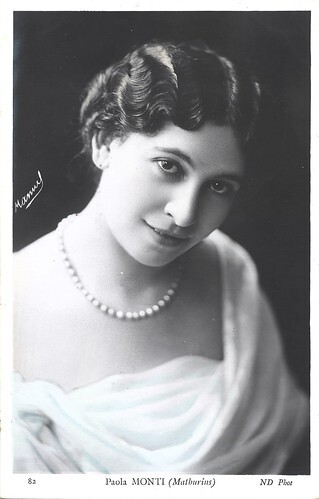
French postcard by ND Phot., no. 82. Photo: Manuel. Caption: Paola Monti (Mathurins). The Théâtre des Mathurins was opened in 1897 and is a still-existing theatre in Paris, in the 8th arrondissement.
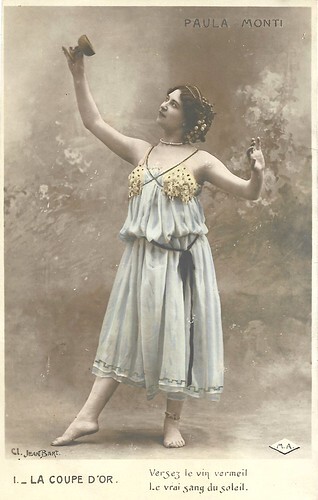
French postcard by M.A. I. Photo: Jean Bart. Caption: La coupe d'or. Versez le vin vermeil, Le vrai sang du soleil (Pour the vermillion wine, The true blood of the sun).
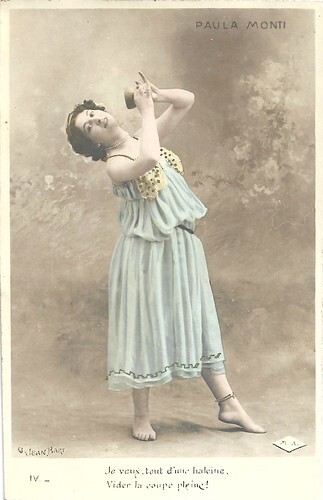
French postcard by M.A. IV. Photo: Jean Bart. Caption: Je veux, tout d'une haleine, Vider la coupe pleine (I want, all at once, to empty the full cup).
The Dance Macabre
Who was Paola Monti, sometimes also written as Paula Monti? Very little is known about Monti, her life dates and origins, as well as her stage career.
What is known is that she performed on the Parisian stages in the 1900s, e.g. in the play 'La strega/The Witch' as well as in a series of dances called 'Les danses antiques/grecques de Paola Monti'.
She performed these dances around 1903 on various occasions and at various locations, such as the Parisiana. Monti's barefoot dances caused a stir.
In January 1904, Monti first performed at the Mathurins a new dance, 'the Dance Macabre', inspired by the Tanagra 'Pleureuses' sculptures at the Louvre. The audience applauded the original dances, which Monti danced barefoot and barelegged.
In 1904, Monti was considered among the best female artists, who not only performed but also visited the theatres, e.g. the Casino de Paris.
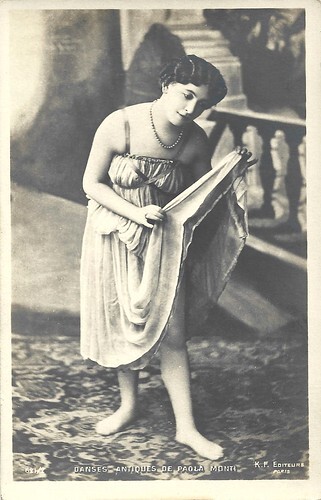
French postcard by K.F. Editeurs, no. 621/2. Caption: Danses antiques de Paola Monti.
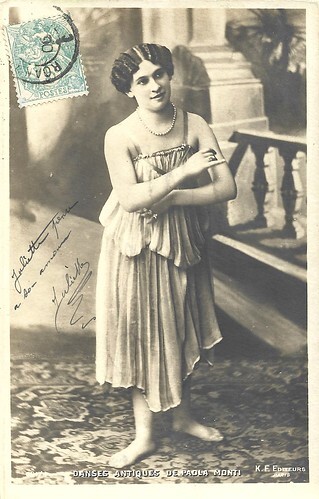
French postcard by K.F. Editeurs, no. 621/4. Caption: Danses antiques de Paola Monti.
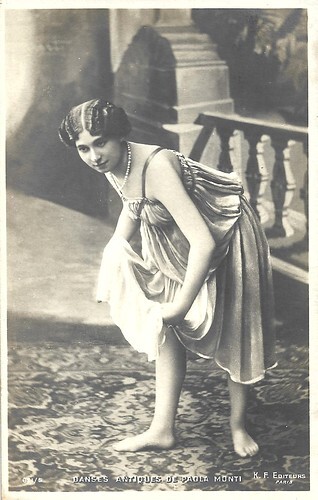
French postcard by K.F. Editeurs, no. 621/5. Caption: Danses antiques de Paola Monti.
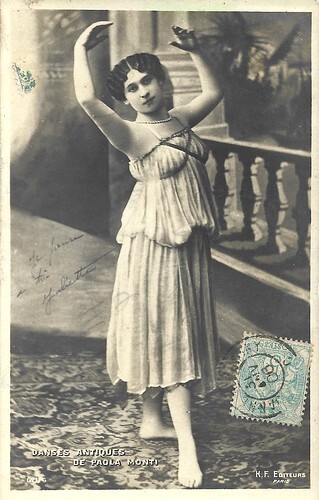
French postcard by K.F. Editeurs, no. 621/6, stamped 1908 or 1906. Caption: Danses antiques de Paola Monti.
A poignant drama which brings one to tears
Between late 1912 and late 1914, Paola Monti was the leading actress in some thirty mostly short Italian films. She started in late 1912 as a supporting actress at the Roman company Celio Film, but after two films, she moved to Film d'Arte Italiana (FAI), the Roman film studio and subsidiary of the French company Pathé Frères.
Here, Monti played the female leads in many shorts opposite other FAI regulars such as Ettore Berti and Guido Brignone, e.g. in Il cuore non dimentica/The Altar Fire (1913), La tragedia di Pulcinella/The Tragedy of Punchinello (1913), and Il bacio di gloria/The Kiss of Glory (1913), all of which the director is unknown.
She also acted in Gerolamo Lo Savio's L'assalto fatale/The Fatal Assault. Later in 1913, Monti got female competition from the French actress Madeleine Céliat , e.g. in Resto umano/Staying human (1913). Other female co-actresses were Emilia Berti-Masi and Alfonsina Pieri, e.g. in L'intrusa/The Intruder (1913). After 16 films in 1913 at FAI, she did 11 more films at the company in 1914. Several of these are known to have been directed by Ugo Falena, such as La più forte/A Husband Outwitted (1914) and La colpa di Giovanna/Giovanna (1914).
Because of Pathé's large distribution network, Monti's films were shown everywhere, of course everywhere in France but also as far as Istanbul. When shown in Paris in 1914, the illustrated journal Excelsior wrote on Monti's La colpa di Giovanna, then shown at the Omnia-Pathé on the Boulevard de Montmartre: "It is a poignant drama which brings one to tears. The perfect mise-en-scene, the luxurious and picturesque locations, and the artists well-known in Italy: Mlle Paola Monti and Mr. Ettore Berti are already a guarantee for a huge success for this film." (Excelsior, 26 June, 1914).
Probably, Monti's last film for FAI was Il segreto delle rose/As Fades the Roses, released in October 1914, and as usual also with Berti and Brignone. Afterwards, she might have returned to the stage. Possibly because of the obstacles of the war, or just usual delays, Monti's films were still shown in the French countryside in 1915.
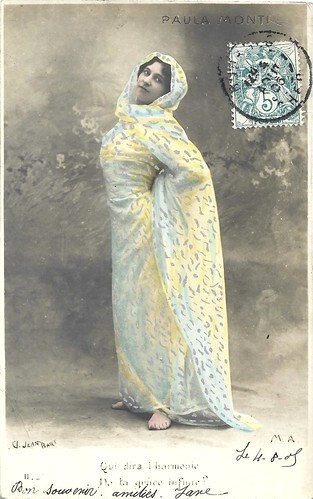
French postcard by M.A. II. Photo: Jean Bart. Caption: Qui dira l'harmonie, De ta grâce infinie (Who will tell the harmony, Of your infinite grace). Card mailed in 1905.
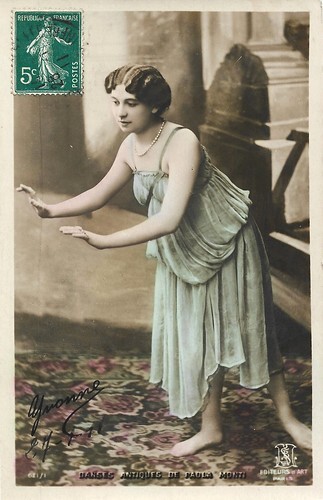
French postcard by HSBA Editeurs d'Art Paris, no. 621/1. Caption: Danses antiques de Paola Monti.
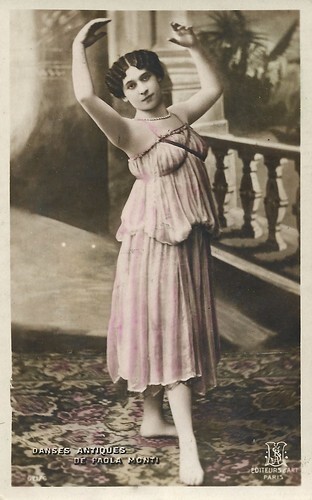
French postcard by HSBA Editeurs d'Art, Paris, no. 621/6. Caption: Danses antiques de Paola Monti.
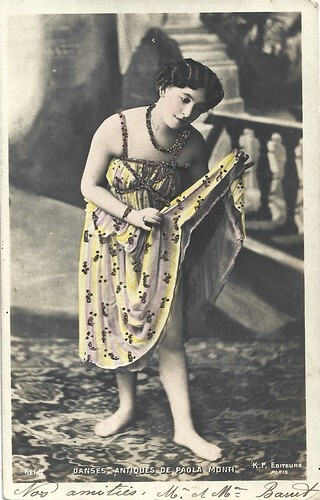
French postcard by K.F. Editeurs, no. 621/2. Caption: Danses antiques de Paola Monti.
Sources: and Gallica.

French postcard by ND Phot., no. 82. Photo: Manuel. Caption: Paola Monti (Mathurins). The Théâtre des Mathurins was opened in 1897 and is a still-existing theatre in Paris, in the 8th arrondissement.

French postcard by M.A. I. Photo: Jean Bart. Caption: La coupe d'or. Versez le vin vermeil, Le vrai sang du soleil (Pour the vermillion wine, The true blood of the sun).

French postcard by M.A. IV. Photo: Jean Bart. Caption: Je veux, tout d'une haleine, Vider la coupe pleine (I want, all at once, to empty the full cup).
The Dance Macabre
Who was Paola Monti, sometimes also written as Paula Monti? Very little is known about Monti, her life dates and origins, as well as her stage career.
What is known is that she performed on the Parisian stages in the 1900s, e.g. in the play 'La strega/The Witch' as well as in a series of dances called 'Les danses antiques/grecques de Paola Monti'.
She performed these dances around 1903 on various occasions and at various locations, such as the Parisiana. Monti's barefoot dances caused a stir.
In January 1904, Monti first performed at the Mathurins a new dance, 'the Dance Macabre', inspired by the Tanagra 'Pleureuses' sculptures at the Louvre. The audience applauded the original dances, which Monti danced barefoot and barelegged.
In 1904, Monti was considered among the best female artists, who not only performed but also visited the theatres, e.g. the Casino de Paris.

French postcard by K.F. Editeurs, no. 621/2. Caption: Danses antiques de Paola Monti.

French postcard by K.F. Editeurs, no. 621/4. Caption: Danses antiques de Paola Monti.

French postcard by K.F. Editeurs, no. 621/5. Caption: Danses antiques de Paola Monti.

French postcard by K.F. Editeurs, no. 621/6, stamped 1908 or 1906. Caption: Danses antiques de Paola Monti.
A poignant drama which brings one to tears
Between late 1912 and late 1914, Paola Monti was the leading actress in some thirty mostly short Italian films. She started in late 1912 as a supporting actress at the Roman company Celio Film, but after two films, she moved to Film d'Arte Italiana (FAI), the Roman film studio and subsidiary of the French company Pathé Frères.
Here, Monti played the female leads in many shorts opposite other FAI regulars such as Ettore Berti and Guido Brignone, e.g. in Il cuore non dimentica/The Altar Fire (1913), La tragedia di Pulcinella/The Tragedy of Punchinello (1913), and Il bacio di gloria/The Kiss of Glory (1913), all of which the director is unknown.
She also acted in Gerolamo Lo Savio's L'assalto fatale/The Fatal Assault. Later in 1913, Monti got female competition from the French actress Madeleine Céliat , e.g. in Resto umano/Staying human (1913). Other female co-actresses were Emilia Berti-Masi and Alfonsina Pieri, e.g. in L'intrusa/The Intruder (1913). After 16 films in 1913 at FAI, she did 11 more films at the company in 1914. Several of these are known to have been directed by Ugo Falena, such as La più forte/A Husband Outwitted (1914) and La colpa di Giovanna/Giovanna (1914).
Because of Pathé's large distribution network, Monti's films were shown everywhere, of course everywhere in France but also as far as Istanbul. When shown in Paris in 1914, the illustrated journal Excelsior wrote on Monti's La colpa di Giovanna, then shown at the Omnia-Pathé on the Boulevard de Montmartre: "It is a poignant drama which brings one to tears. The perfect mise-en-scene, the luxurious and picturesque locations, and the artists well-known in Italy: Mlle Paola Monti and Mr. Ettore Berti are already a guarantee for a huge success for this film." (Excelsior, 26 June, 1914).
Probably, Monti's last film for FAI was Il segreto delle rose/As Fades the Roses, released in October 1914, and as usual also with Berti and Brignone. Afterwards, she might have returned to the stage. Possibly because of the obstacles of the war, or just usual delays, Monti's films were still shown in the French countryside in 1915.

French postcard by M.A. II. Photo: Jean Bart. Caption: Qui dira l'harmonie, De ta grâce infinie (Who will tell the harmony, Of your infinite grace). Card mailed in 1905.

French postcard by HSBA Editeurs d'Art Paris, no. 621/1. Caption: Danses antiques de Paola Monti.

French postcard by HSBA Editeurs d'Art, Paris, no. 621/6. Caption: Danses antiques de Paola Monti.

French postcard by K.F. Editeurs, no. 621/2. Caption: Danses antiques de Paola Monti.
Sources: and Gallica.
Published on November 08, 2023 22:00
November 7, 2023
The Da Vinci Code (2002)
The Da Vinci Code (Ron Howard, 2006) is the film adaptation of the book of the same name, written by American author Dan Brown. It is the first part of the Robert Langdon film trilogy, but is, in fact, the second part of the literary pentalogy, after 'Angels and Demons'. The lead roles in this conspiracy thriller are played by Tom Hanks (Robert Langdon), Audrey Tautou (Sophie Neveu) and Ian McKellen (Sir Leigh Teabing). Co-stars are Jean Reno, Paul Bettany, Alfred Molina and Jürgen Prochnow.
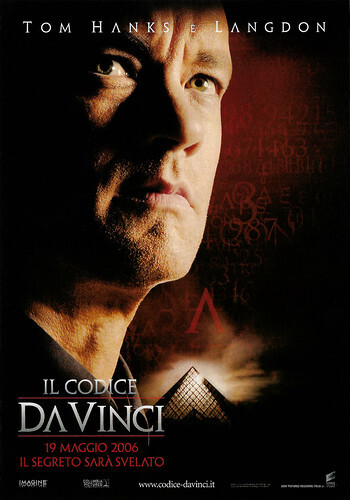
Italian promocard by The Cult Advertising, no. PC 6391. Image: Imagine / Columbia Pictures / Sony Pictures. Tom Hanks in The Da Vinci Code (Ron Howard, 2006). Caption: Tom Hanks is Langdon. 19 May 2006, the secret will be revealed.
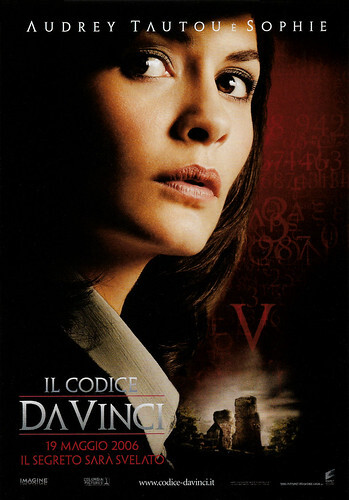
Italian promocard by The Cult Advertising, no. PC 6390. Image: Imagine / Columbia Pictures / Sony Pictures. Audrey Tautou in The Da Vinci Code (Ron Howard, 2006). Caption: Audrey Tautou is Sophie. 19 May 2006, the secret will be revealed.
An image using his body and blood
The Da Vinci Code (Ron Howard, 2006) begins in the Louvre at night. A man is pursued by an unknown man, threatened and finally murdered.
Later we learn that the man killed is Jacques Saunière, the curator of the Louvre. In his last minutes, Saunière creates an image using his body and blood that forms a sketch of Leonardo da Vinci.
At the time, Robert Langdon (Tom Hanks), a Harvard University symbologist, was in Paris to give a lecture and present his new book. Police officers appear at the book signing afterwards. They show him the photo of Saunière's body and ask him for his opinion.
At the Louvre, he meets Sophie ( Audrey Tautou ), Saunière's granddaughter who works as a cryptologist for the Paris police. Together they try to figure out the mysterious murder and the clue Saunière was trying to give. It turns out that the curator belonged to the Priory of Sion. Leonardo da Vinci, Victor Hugo , Claude Debussy and Sir Isaac Newton are also said to have belonged to it.
After following clues in Da Vinci's paintings, they find a fleur de lis with a street name on it. When they get to the right address, it turns out to be a bank. It led to the discovery of a religious mystery protected by a secret society for two thousand years, which could shake the foundations of Christianity.
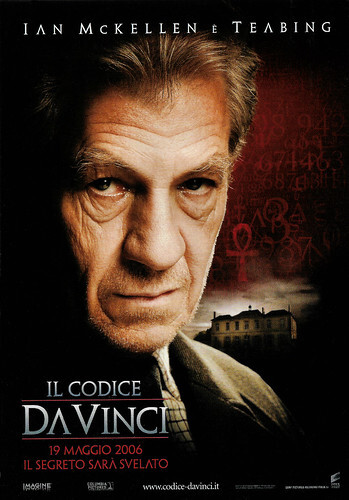
Italian promocard by The Cult Advertising, no. PC 6387. Image: Imagine / Columbia Pictures / Sony Pictures. Ian McKellen in The Da Vinci Code (Ron Howard, 2006). Caption: Ian McKellen is Teabing. 19 May 2006, the secret will be revealed.
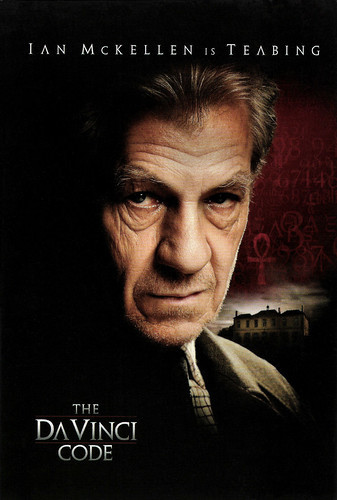
British postcard by Pacificmeg.com. Photo: Columbia Pictures / Sony Pictures. Ian McKellen as Sir Leigh Teabing in The Da Vinci Code (Ron Howard, 2006). This postcard was published for the VCD & DVD release in 2006.
Nominated for the Golden Raspberry
The Da Vinci Code (2002) was shot in Britain, France and Germany. The Louvre in Paris gave the film crew permission to film in the museum; however, Westminster Abbey did not, so the scenes set there in the book were shot in other churches, namely Lincoln Cathedral in Lincoln and Winchester Cathedral in Winchester.
The chancellor of Lincoln Cathedral, Mike West, called the book heretical and "historical nonsense" in a public address. Alec Knight, the dean of the Anglican cathedral, called the bestseller a "load of rubbish". Nevertheless, he reached an agreement with the US film studio Sony to film the film after a donation of the equivalent of around 146,000 euros was promised. Many of the scenes in buildings were shot at Pinewood Studios.
The film's premiere took place at the Cannes Film Festival. There, the film was lukewarmly received by the film critics in attendance. The film was said to be too complicated, too rushed and difficult to understand for people who had not read the book. During a crucial moment at the end of the film, the audience erupted in laughter the moment Professor Langdon told cryptologist Neveu that she was the last living descendant of Jesus Christ. In 2007, the film was nominated for the Golden Raspberry in the category of Worst Director.
The Encyclopaedia of International Film called The Da Vinci Code a "film absurd in its theses, yet thoroughly entertaining, which feeds its story from the fund of questionable conspiracy theories and, despite its closeness to mainstream cinema, is given a character all of its own by the performance of its leading actor." The film, with an estimated budget of $125 million, grossed around $758.2 million worldwide.
Dan Brown and his wife made a cameo in the film together at the beginning of the film, in the background of Robert Langdon's autograph session. In 2008, another of Brown's novels, 'Angels and Demons', was made into a film. Tom Hanks was again cast in the role of Langdon, and the Israeli actress Ayelet Zurer took on the role of a nuclear physicist. The film, Angels and Demons, was released in 2009. Inferno, the film of the fourth book in the Robert Langdon series was released in 2016. Hanks played Professor Langdon once again, directed by Ron Howard.
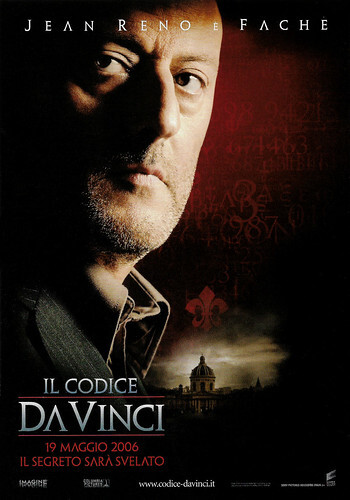
Italian promocard by The Cult Advertising, no. PC 6388. Image: Imagine / Columbia Pictures / Sony Pictures. Jean Reno in The Da Vinci Code (Ron Howard, 2006). Caption: Jean Reno is Fache. 19 May 2006, the secret will be revealed.
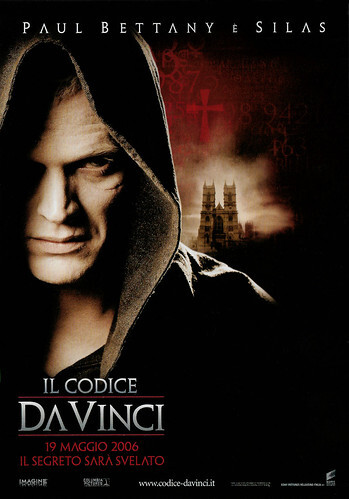
Italian promocard by The Cult Advertising, no. PC 6389. Image: Imagine / Columbia Pictures / Sony Pictures. Paul Bettany in The Da Vinci Code (Ron Howard, 2006). Caption: Paul Bettany is Silas. 19 May 2006, the secret will be revealed.
Sources: Wikipedia (Dutch, French and German) and IMDb.

Italian promocard by The Cult Advertising, no. PC 6391. Image: Imagine / Columbia Pictures / Sony Pictures. Tom Hanks in The Da Vinci Code (Ron Howard, 2006). Caption: Tom Hanks is Langdon. 19 May 2006, the secret will be revealed.

Italian promocard by The Cult Advertising, no. PC 6390. Image: Imagine / Columbia Pictures / Sony Pictures. Audrey Tautou in The Da Vinci Code (Ron Howard, 2006). Caption: Audrey Tautou is Sophie. 19 May 2006, the secret will be revealed.
An image using his body and blood
The Da Vinci Code (Ron Howard, 2006) begins in the Louvre at night. A man is pursued by an unknown man, threatened and finally murdered.
Later we learn that the man killed is Jacques Saunière, the curator of the Louvre. In his last minutes, Saunière creates an image using his body and blood that forms a sketch of Leonardo da Vinci.
At the time, Robert Langdon (Tom Hanks), a Harvard University symbologist, was in Paris to give a lecture and present his new book. Police officers appear at the book signing afterwards. They show him the photo of Saunière's body and ask him for his opinion.
At the Louvre, he meets Sophie ( Audrey Tautou ), Saunière's granddaughter who works as a cryptologist for the Paris police. Together they try to figure out the mysterious murder and the clue Saunière was trying to give. It turns out that the curator belonged to the Priory of Sion. Leonardo da Vinci, Victor Hugo , Claude Debussy and Sir Isaac Newton are also said to have belonged to it.
After following clues in Da Vinci's paintings, they find a fleur de lis with a street name on it. When they get to the right address, it turns out to be a bank. It led to the discovery of a religious mystery protected by a secret society for two thousand years, which could shake the foundations of Christianity.

Italian promocard by The Cult Advertising, no. PC 6387. Image: Imagine / Columbia Pictures / Sony Pictures. Ian McKellen in The Da Vinci Code (Ron Howard, 2006). Caption: Ian McKellen is Teabing. 19 May 2006, the secret will be revealed.

British postcard by Pacificmeg.com. Photo: Columbia Pictures / Sony Pictures. Ian McKellen as Sir Leigh Teabing in The Da Vinci Code (Ron Howard, 2006). This postcard was published for the VCD & DVD release in 2006.
Nominated for the Golden Raspberry
The Da Vinci Code (2002) was shot in Britain, France and Germany. The Louvre in Paris gave the film crew permission to film in the museum; however, Westminster Abbey did not, so the scenes set there in the book were shot in other churches, namely Lincoln Cathedral in Lincoln and Winchester Cathedral in Winchester.
The chancellor of Lincoln Cathedral, Mike West, called the book heretical and "historical nonsense" in a public address. Alec Knight, the dean of the Anglican cathedral, called the bestseller a "load of rubbish". Nevertheless, he reached an agreement with the US film studio Sony to film the film after a donation of the equivalent of around 146,000 euros was promised. Many of the scenes in buildings were shot at Pinewood Studios.
The film's premiere took place at the Cannes Film Festival. There, the film was lukewarmly received by the film critics in attendance. The film was said to be too complicated, too rushed and difficult to understand for people who had not read the book. During a crucial moment at the end of the film, the audience erupted in laughter the moment Professor Langdon told cryptologist Neveu that she was the last living descendant of Jesus Christ. In 2007, the film was nominated for the Golden Raspberry in the category of Worst Director.
The Encyclopaedia of International Film called The Da Vinci Code a "film absurd in its theses, yet thoroughly entertaining, which feeds its story from the fund of questionable conspiracy theories and, despite its closeness to mainstream cinema, is given a character all of its own by the performance of its leading actor." The film, with an estimated budget of $125 million, grossed around $758.2 million worldwide.
Dan Brown and his wife made a cameo in the film together at the beginning of the film, in the background of Robert Langdon's autograph session. In 2008, another of Brown's novels, 'Angels and Demons', was made into a film. Tom Hanks was again cast in the role of Langdon, and the Israeli actress Ayelet Zurer took on the role of a nuclear physicist. The film, Angels and Demons, was released in 2009. Inferno, the film of the fourth book in the Robert Langdon series was released in 2016. Hanks played Professor Langdon once again, directed by Ron Howard.

Italian promocard by The Cult Advertising, no. PC 6388. Image: Imagine / Columbia Pictures / Sony Pictures. Jean Reno in The Da Vinci Code (Ron Howard, 2006). Caption: Jean Reno is Fache. 19 May 2006, the secret will be revealed.

Italian promocard by The Cult Advertising, no. PC 6389. Image: Imagine / Columbia Pictures / Sony Pictures. Paul Bettany in The Da Vinci Code (Ron Howard, 2006). Caption: Paul Bettany is Silas. 19 May 2006, the secret will be revealed.
Sources: Wikipedia (Dutch, French and German) and IMDb.
Published on November 07, 2023 22:00
November 6, 2023
Nelly Cormon
Nelly Cormon (1877-1942) was a French theatre and film actress, who starred in two dozens early silent films for the Film d'Art company. She acted in such historical films as Les Trois Mousquetaires (1912) and Le Comte de Monte-Cristo (1918), both adapted from Alexandre Dumas.
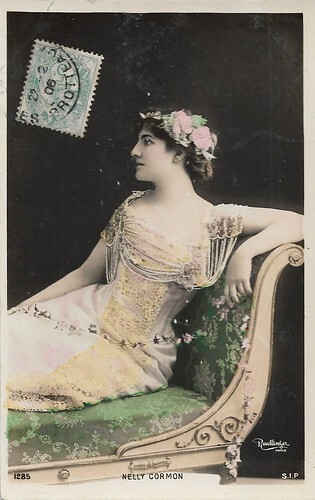
French postcard by S.I.P., no. 1285. Photo: Reutlinger, Paris. Card mailed in 1906.
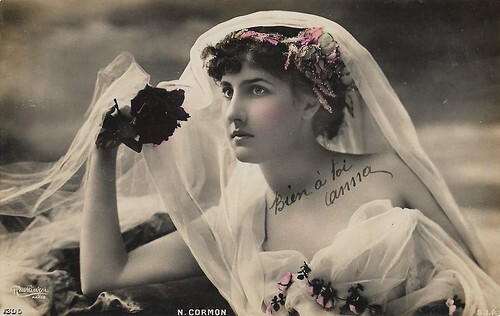
French postcard by S.I.P., no. 1306. Photo: Jean Reutlinger, Paris.
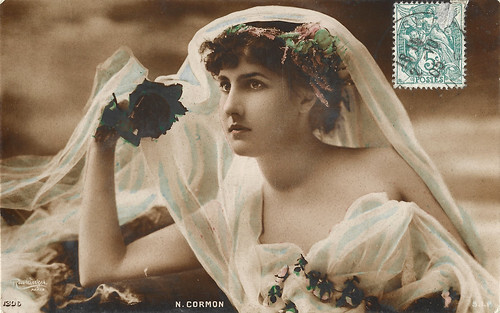
French postcard by S.I.P., no. 1306. Photo: Jean Reutlinger, Paris.
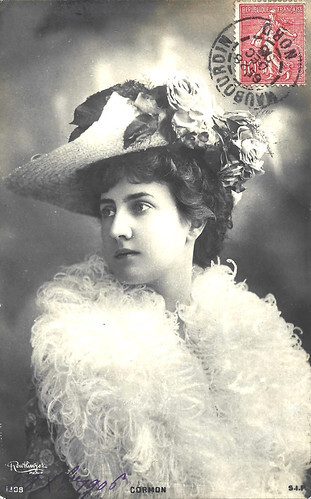
French postcard by S.I.P., no. 1308. Photo: Reutlinger, Paris. Sent by mail in 1906.
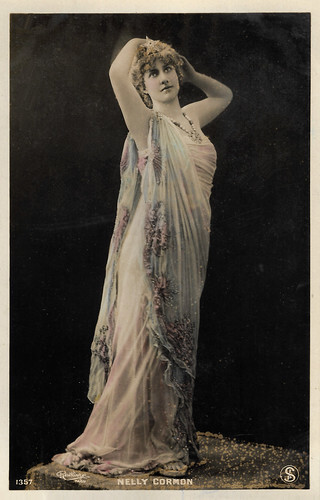
French postcard by S.I.P., no. 1357. Photo: Reutlinger, Paris.
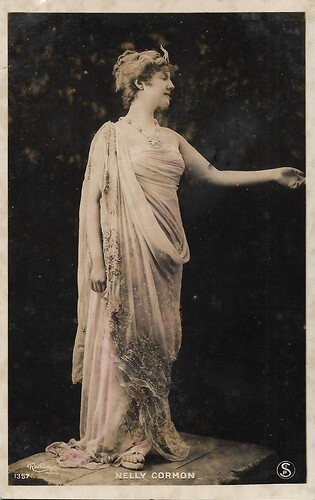
French postcard by S.I.P., no. 1357. Photo: Reutlinger, Paris.
Harmonious features, a proud look and brown curly hair
Marie Nelly Cormon was born in 1877 in Bourges, France to a teacher and his wife.
As Guy Bellinger writes on IMDb , "Tall and elegant, with harmonious features, a proud look and brown curly hair, Nelly Cormon was a French theatre actress of classic beauty who was very successful on stage for three decades and had a brief but honourable career in silent films at the time when cinema was beginning to become more artistic, not just a fairground art."
Nelly Cormon was admitted to the Paris Conservatoire in piano with Professor Raoul Pugno. She graduated at the age of fifteen with several prizes.
In the 1900s she had a rich stage career, first at the Théâtre du Gymnase in plays such as 'L'Épave' (1903) and 'Le Retour de Jérusalem' (1903), then moved to the Théâtre Sarah-Bernhardt, where she acted in plays like 'Le Masque d'amour' (1905) and 'Le Frisson de l'Aigle' (1906).
From 1906 she acted at various Parisian theatres, e.g. in 'Les Nuées' (1906) by Aristophanes, 'Les Deux gosses' (1907) by Pierre Decourcelle, and 'La Maison de danses' (1909) by Nozière and Müller. She also went on tour to Lisbon, London, Nancy, Brussels and other cities. In the early 1910s, she acted at the Théâtre de la Porte-Saint-Martin in such plays as 'La Flambée' by Kistemaeckers fils, and 'La Chèvrefeuille' by Gabriele D'Annunzio . Cormon continued to act on stage throughout the 1920s and early 1930s.
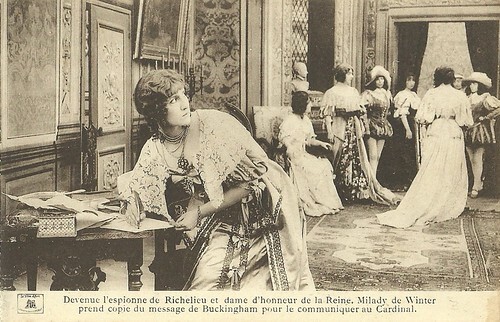
French postcard. Photo: Le Film d'Art. Nelly Cormon as Milady de Winter in Les trois mousquetaires/The Three Musketeers (Henry Pouctal, André Calmettes, 1912-1913). The unnumbered cards don't follow the order of the novel.
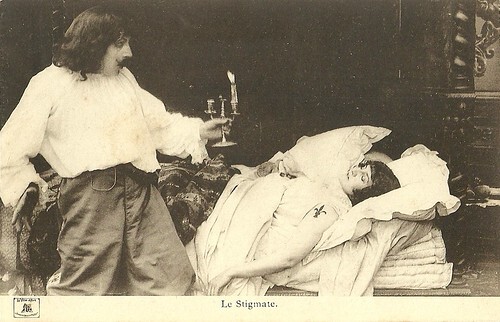
French postcard. Photo: Le Film d'Art. Marcel Vibert as Athos (Count de Fère) and Nelly Cormon as Milady de Winter in Les trois mousquetaires/The Three Musketeers (Henry Pouctal, André Calmettes, 1912-1913). Most of the cards follow the order of the novel, with some hesitations about the cards on Milady's past. The cards were not numbered.
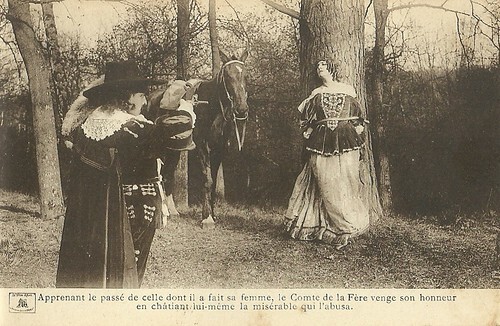
French postcard. Photo: Le Film d'Art. Marcel Vibert as Athos (Count de Fère) and Nelly Cormon as Milady de Winter in Les trois mousquetaires/The Three Musketeers (Henry Pouctal, André Calmettes, 1912-1913).
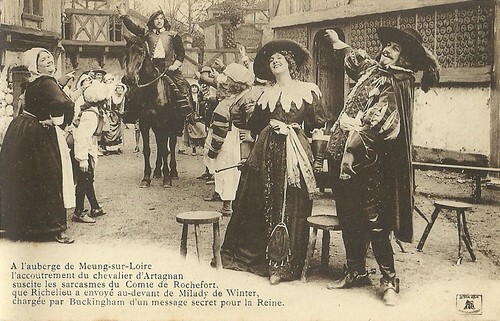
French postcard. Photo: Le Film d'Art. Emile Dehelly as D'Artagnan, Nelly Cormon as Milady de Winter and Jacques Volnys as Le Comte de Rochefort in Les trois mousquetaires/The Three Musketeers (Henry Pouctal, André Calmettes, 1912-1913).
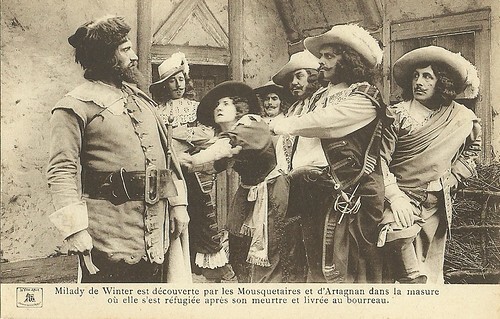
French postcard. Photo: Le Film d'Art. Emile Dehelly as D'Artagnan, Nelly Cormon as Milady de Winter, Marcel Vibert as Athos, Adolphe Candé asPorthos and Stellio as Aramis in Les trois mousquetaires/The Three Musketeers (Henry Pouctal, André Calmettes, 1912-1913).
The evil antagonist Milady De Winter
Parallel to her stage career, Nelly Cormon started a career as a film actress in 1909. After a one-off comedy at Pathé, she initially mostly appeared in Film d'Art films by André Calmettes, such as L'Arrestation de la Duchesse de Berry (André Calmettes, 1910) in which she had the lead.
From 1911, Cormon would perform in a large number of films directed by Henri Pouctal, who had started out his career as an assistant of Calmettes. Their most intense collaboration was in 1912 when Cormon acted in eleven films by Pouctal, all for Le Film d'Art. Often these were period dramas such as Joséphine impératrice/Impératrice et reine, in which Cormon had the title role of Joséphine de Beauharnais.
Under the direction of Calmettes and Pouctal together, Cormon acted as the evil antagonist Milady De Winter in the Film d'Art production Les Trois Mousquetaires/The Three Musketeers (1912-1913), based on Alexandre Dumas père 's' famous novel. The film starred Emile Dehelly as D'Artagnan, Marguerite Guizelle as Constance Bonacieux, and Philippe Garnier as Richelieu. The sets were by Emile Bertin. The two-part film was a big success, leading to many more film adaptations of Les Trois Mousquetaires, both in France and Hollywood.
While Cormon continued to act with Pouctal in seven more films in 1913, all for Le Film d'Art, afterwards, the wave was over. She still acted in one film by Pouctal in 1914, L'Alibi, and one in 1916, Les Flambeaux, while in 1918 she had the lead in Henry Krauss ' Marion Delorme on the famous courtesan. Also in 1918, Cormon had the female lead as Mercedes in Pouctal's serial film Le Comte de Monte-Cristo, with Léon Mathot in the male lead as Edmond Dantès.
After an absence of a decade, Cormon would only return once more to the film sets to play the elder Juliette Recamier in the film Madame Recamier (1928) by Tony Lekain and Gaston Ravel, while Marie Bell had the lead as the young Juliette Recamier. This was the last time Cormon acted in film. Nelly Cormon died in 1942 in Sorel-Moussel (Eure-et-Loir). She was 64. Since 1923 she was married to Gaston Georges Olmer, an industrialist.
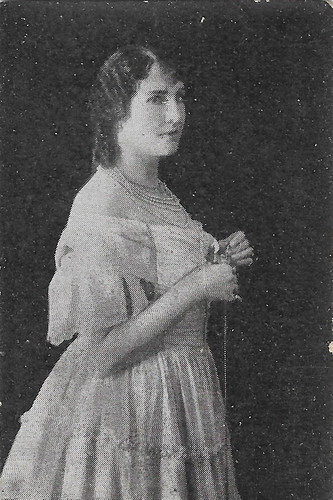
Spanish minicard by Chocolate Amatller, Marca Luna, Series 2 of 33 minicards. Photo: Pathé Frères. Nelly Cormon as Mercedes in the film serial Le Comte de Monte-Cristo (Henri Pouctal, 1918).
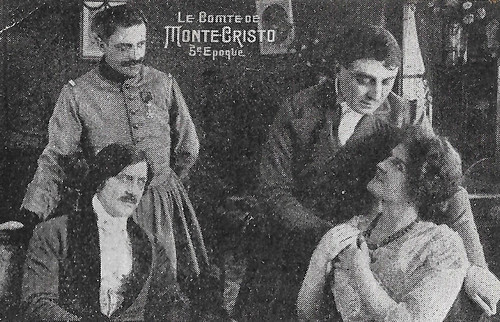
Spanish minicard by Chocolate Amatller, Marca Luna, Series 2 of 33 minicards. Photo: Pathé Frères. Léon Mathot as Edmond Dantès / The Count of Monte-Cristo and Nelly Cormon as Mercedes in the film serial Le Comte de Monte-Cristo (Henri Pouctal, 1918).
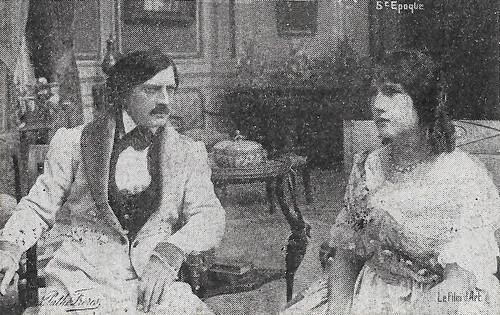
Spanish minicard by Chocolate Amatller, Marca Luna, Series 2 of 33 minicards. Photo: Pathé Frères. Léon Mathot as Edmond Dantès / The Count of Monte-Cristo and Nelly Cormon as Mercedes in the film serial Le Comte de Monte-Cristo (Henri Pouctal, 1918).
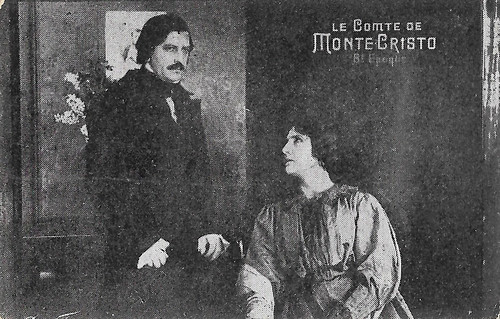
Spanish minicard by Chocolate Amatller, Marca Luna, Series 2 of 33 minicards. Photo: Pathé Frères. Léon Mathot as Edmond Dantès / The Count of Monte-Cristo and Nelly Cormon as Mercedes in the film serial Le Comte de Monte-Cristo (Henri Pouctal, 1918).
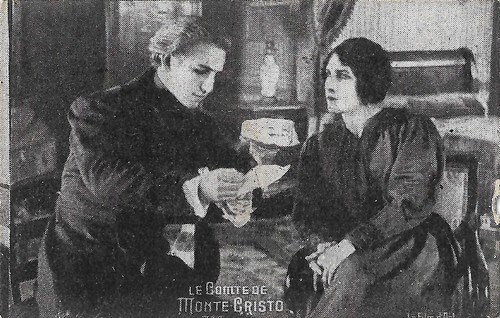
Spanish minicard by Chocolate Amatller, Marca Luna, Series 2 of 33 minicards. Photo: Pathé Frères. Nelly Cormon as Mercedes and Jacques Robert as Albert, Mercedes'son, in the film serial Le Comte de Monte-Cristo (Henri Pouctal, 1918).
Sources: (IMDb), Wikipedia (English and French) and .

French postcard by S.I.P., no. 1285. Photo: Reutlinger, Paris. Card mailed in 1906.

French postcard by S.I.P., no. 1306. Photo: Jean Reutlinger, Paris.

French postcard by S.I.P., no. 1306. Photo: Jean Reutlinger, Paris.

French postcard by S.I.P., no. 1308. Photo: Reutlinger, Paris. Sent by mail in 1906.

French postcard by S.I.P., no. 1357. Photo: Reutlinger, Paris.

French postcard by S.I.P., no. 1357. Photo: Reutlinger, Paris.
Harmonious features, a proud look and brown curly hair
Marie Nelly Cormon was born in 1877 in Bourges, France to a teacher and his wife.
As Guy Bellinger writes on IMDb , "Tall and elegant, with harmonious features, a proud look and brown curly hair, Nelly Cormon was a French theatre actress of classic beauty who was very successful on stage for three decades and had a brief but honourable career in silent films at the time when cinema was beginning to become more artistic, not just a fairground art."
Nelly Cormon was admitted to the Paris Conservatoire in piano with Professor Raoul Pugno. She graduated at the age of fifteen with several prizes.
In the 1900s she had a rich stage career, first at the Théâtre du Gymnase in plays such as 'L'Épave' (1903) and 'Le Retour de Jérusalem' (1903), then moved to the Théâtre Sarah-Bernhardt, where she acted in plays like 'Le Masque d'amour' (1905) and 'Le Frisson de l'Aigle' (1906).
From 1906 she acted at various Parisian theatres, e.g. in 'Les Nuées' (1906) by Aristophanes, 'Les Deux gosses' (1907) by Pierre Decourcelle, and 'La Maison de danses' (1909) by Nozière and Müller. She also went on tour to Lisbon, London, Nancy, Brussels and other cities. In the early 1910s, she acted at the Théâtre de la Porte-Saint-Martin in such plays as 'La Flambée' by Kistemaeckers fils, and 'La Chèvrefeuille' by Gabriele D'Annunzio . Cormon continued to act on stage throughout the 1920s and early 1930s.

French postcard. Photo: Le Film d'Art. Nelly Cormon as Milady de Winter in Les trois mousquetaires/The Three Musketeers (Henry Pouctal, André Calmettes, 1912-1913). The unnumbered cards don't follow the order of the novel.

French postcard. Photo: Le Film d'Art. Marcel Vibert as Athos (Count de Fère) and Nelly Cormon as Milady de Winter in Les trois mousquetaires/The Three Musketeers (Henry Pouctal, André Calmettes, 1912-1913). Most of the cards follow the order of the novel, with some hesitations about the cards on Milady's past. The cards were not numbered.

French postcard. Photo: Le Film d'Art. Marcel Vibert as Athos (Count de Fère) and Nelly Cormon as Milady de Winter in Les trois mousquetaires/The Three Musketeers (Henry Pouctal, André Calmettes, 1912-1913).

French postcard. Photo: Le Film d'Art. Emile Dehelly as D'Artagnan, Nelly Cormon as Milady de Winter and Jacques Volnys as Le Comte de Rochefort in Les trois mousquetaires/The Three Musketeers (Henry Pouctal, André Calmettes, 1912-1913).

French postcard. Photo: Le Film d'Art. Emile Dehelly as D'Artagnan, Nelly Cormon as Milady de Winter, Marcel Vibert as Athos, Adolphe Candé asPorthos and Stellio as Aramis in Les trois mousquetaires/The Three Musketeers (Henry Pouctal, André Calmettes, 1912-1913).
The evil antagonist Milady De Winter
Parallel to her stage career, Nelly Cormon started a career as a film actress in 1909. After a one-off comedy at Pathé, she initially mostly appeared in Film d'Art films by André Calmettes, such as L'Arrestation de la Duchesse de Berry (André Calmettes, 1910) in which she had the lead.
From 1911, Cormon would perform in a large number of films directed by Henri Pouctal, who had started out his career as an assistant of Calmettes. Their most intense collaboration was in 1912 when Cormon acted in eleven films by Pouctal, all for Le Film d'Art. Often these were period dramas such as Joséphine impératrice/Impératrice et reine, in which Cormon had the title role of Joséphine de Beauharnais.
Under the direction of Calmettes and Pouctal together, Cormon acted as the evil antagonist Milady De Winter in the Film d'Art production Les Trois Mousquetaires/The Three Musketeers (1912-1913), based on Alexandre Dumas père 's' famous novel. The film starred Emile Dehelly as D'Artagnan, Marguerite Guizelle as Constance Bonacieux, and Philippe Garnier as Richelieu. The sets were by Emile Bertin. The two-part film was a big success, leading to many more film adaptations of Les Trois Mousquetaires, both in France and Hollywood.
While Cormon continued to act with Pouctal in seven more films in 1913, all for Le Film d'Art, afterwards, the wave was over. She still acted in one film by Pouctal in 1914, L'Alibi, and one in 1916, Les Flambeaux, while in 1918 she had the lead in Henry Krauss ' Marion Delorme on the famous courtesan. Also in 1918, Cormon had the female lead as Mercedes in Pouctal's serial film Le Comte de Monte-Cristo, with Léon Mathot in the male lead as Edmond Dantès.
After an absence of a decade, Cormon would only return once more to the film sets to play the elder Juliette Recamier in the film Madame Recamier (1928) by Tony Lekain and Gaston Ravel, while Marie Bell had the lead as the young Juliette Recamier. This was the last time Cormon acted in film. Nelly Cormon died in 1942 in Sorel-Moussel (Eure-et-Loir). She was 64. Since 1923 she was married to Gaston Georges Olmer, an industrialist.

Spanish minicard by Chocolate Amatller, Marca Luna, Series 2 of 33 minicards. Photo: Pathé Frères. Nelly Cormon as Mercedes in the film serial Le Comte de Monte-Cristo (Henri Pouctal, 1918).

Spanish minicard by Chocolate Amatller, Marca Luna, Series 2 of 33 minicards. Photo: Pathé Frères. Léon Mathot as Edmond Dantès / The Count of Monte-Cristo and Nelly Cormon as Mercedes in the film serial Le Comte de Monte-Cristo (Henri Pouctal, 1918).

Spanish minicard by Chocolate Amatller, Marca Luna, Series 2 of 33 minicards. Photo: Pathé Frères. Léon Mathot as Edmond Dantès / The Count of Monte-Cristo and Nelly Cormon as Mercedes in the film serial Le Comte de Monte-Cristo (Henri Pouctal, 1918).

Spanish minicard by Chocolate Amatller, Marca Luna, Series 2 of 33 minicards. Photo: Pathé Frères. Léon Mathot as Edmond Dantès / The Count of Monte-Cristo and Nelly Cormon as Mercedes in the film serial Le Comte de Monte-Cristo (Henri Pouctal, 1918).

Spanish minicard by Chocolate Amatller, Marca Luna, Series 2 of 33 minicards. Photo: Pathé Frères. Nelly Cormon as Mercedes and Jacques Robert as Albert, Mercedes'son, in the film serial Le Comte de Monte-Cristo (Henri Pouctal, 1918).
Sources: (IMDb), Wikipedia (English and French) and .
Published on November 06, 2023 22:00
Paul van Yperen's Blog
- Paul van Yperen's profile
- 13 followers
Paul van Yperen isn't a Goodreads Author
(yet),
but they
do have a blog,
so here are some recent posts imported from
their feed.



